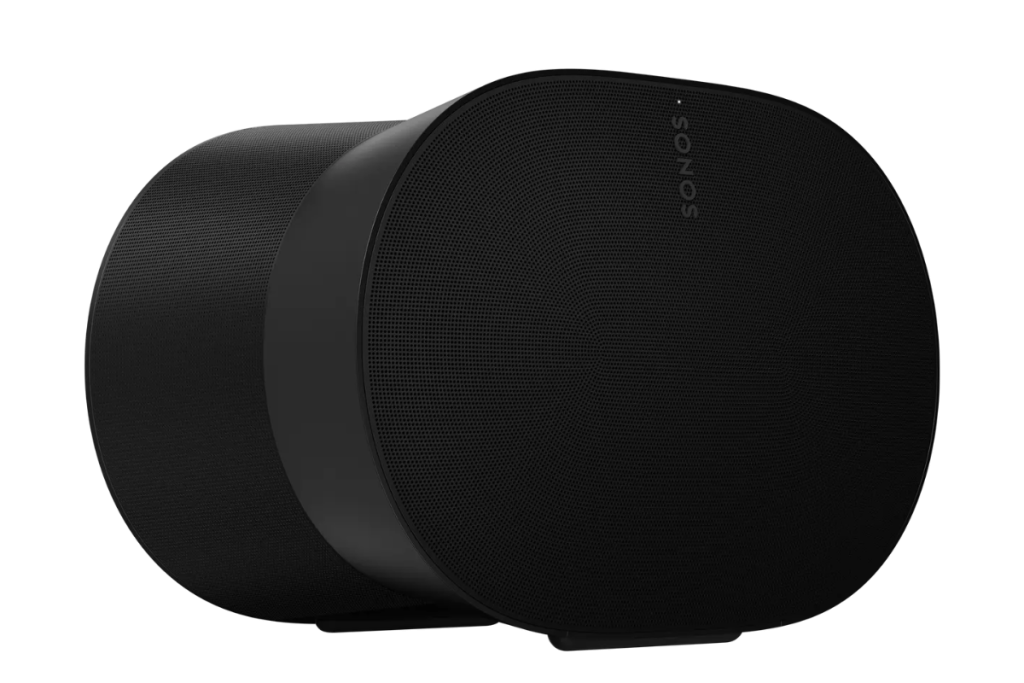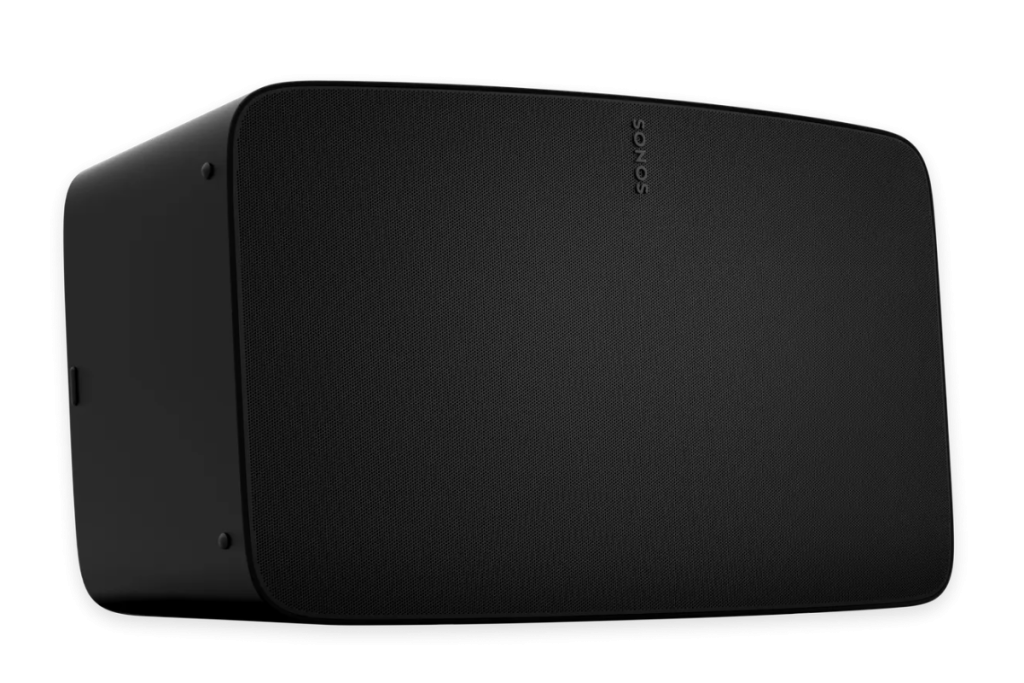Your Mini Basket
Sonos Says Goodbye to the Sonos One & Sonos One SL
Following the release of the Sonos Era 100 in March 2023, the Sonos One and Sonos One SL are set to be discontinued. Sonos has now begun the process of phasing out the fan-favourite Sonos One (Gen 2) and Sonos One SL wireless smart speakers. The brand has confirmed that it will maintain the availability of the One/One SL until stocks are gone. Once that happens, the Sonos Era 100 will then become the company's sole entry-level speaker.
Already got a Sonos One or Sonos One SL? Don’t worry! Despite being discontinued, these speakers will still continue to function as they did when they were originally purchased, so there’s no reason why you can’t continue to use them in any capacity throughout your home. That being said, the key thing to remember is that although there will still be support for bug updates from Sonos, there won’t be any new features added (and who doesn’t like new functionality, right?)
Thankfully, Sonos have a ready-made replacement in the shape of the Sonos Era 100, and it's jam-packed with upgrades that definitely make it a more tempting proposition.
The Key Differences At A GlancE
Regardless of whether you’re looking to buy your first Sonos speaker, trying to figure out whether it’s worth upgrading your current speaker or simply debating between the two, understanding the differences between the Sonos Era 100 and Sonos One (Gen 2) can be tricky. Both are fantastic smart speakers, but they have some key differences. Let's break it down:
If you’d like a more in-depth comparison, read our Sonos Era 100 vs. Sonos One (Gen 2): What's the Difference blog.
Better Sound Performance
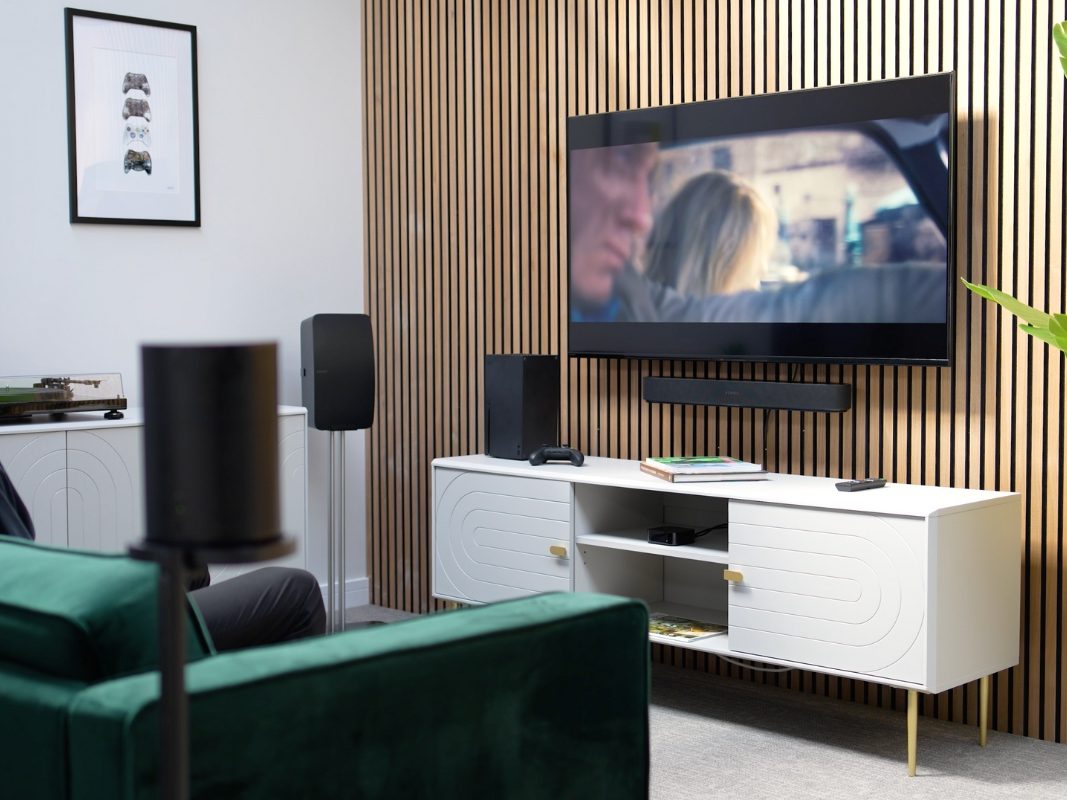
Sonos Era 100: Richer, fuller sound profile with stereo separation thanks to two angled tweeters and a 25% larger woofer.
Sonos One (Gen 2) / Sonos One SL: Mono sound, good for daily listening music but a step down in overall performance.
Extended Features:
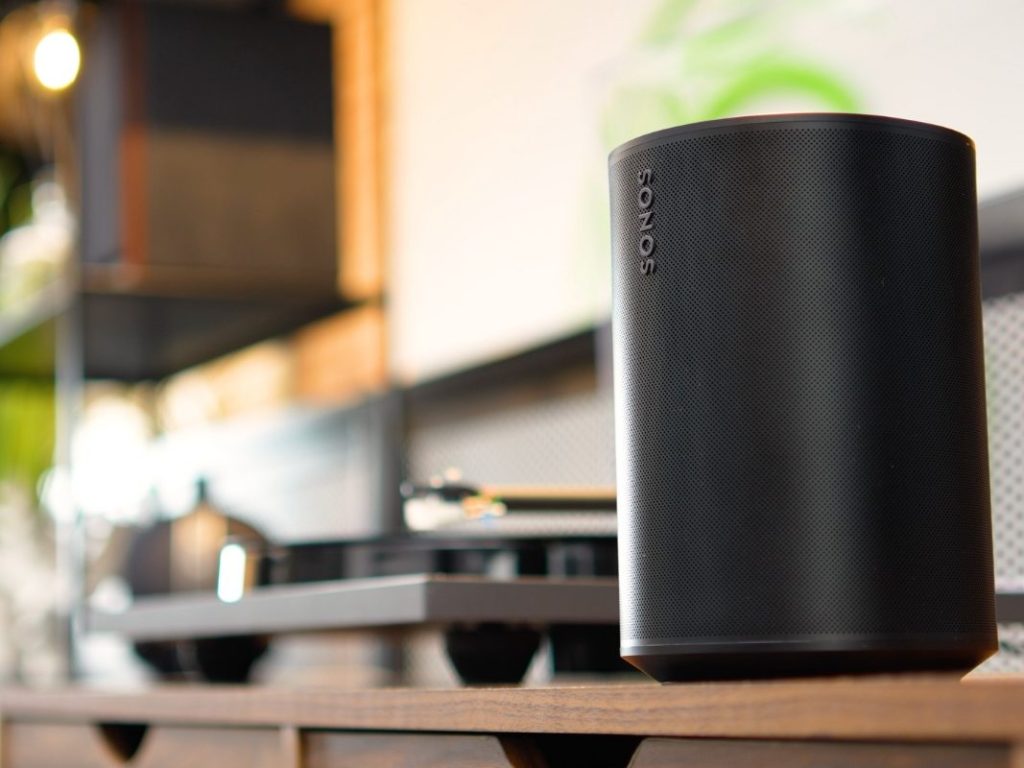
Sonos Era 100: Bluetooth 5.0, dedicated line-in for wired devices using Sonos Line-In Adapter (sold separately), Quick Tuning for Android, Trueplay for iOS, voice assistance (no Google Assistant).
Sonos One (Gen 2) / Sonos One SL: No Bluetooth or line-in; Trueplay Tuning for room tuning (iOS only). Full voice assistance (Sonos One SL lacks voice control).
Enhanced Design:
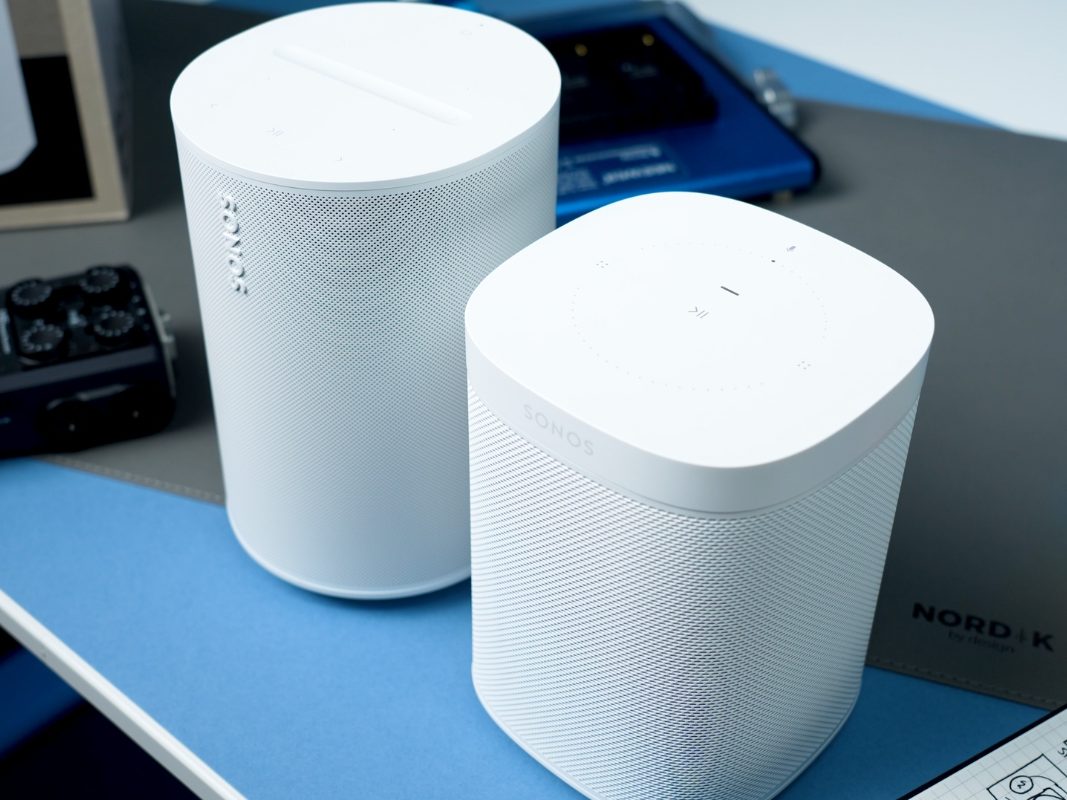
Sonos Era 100: New and improved cylindrical design and controls, perfectly matched to other new Sonos releases (Sonos Era 300, Sonos Move 2). It comes in black or white.
Sonos One (Gen 2) / Sonos One SL: Slightly more dated design. It comes in black or white.
Price:
Naturally, as a newer product, the Sonos Era 100 does boast a more expensive price tag. However, when you consider the benefits of sound performance, features and design, we would argue its worth it.
Sonos Era 100 RRP: £249
Sonos One (Gen 2) RRP: £199
Sonos One SL RRP: £179
We’ve covered all of the differences in our Sonos Era 100 Review: The Ultimate Smart Speaker video on YouTube below:
Remember, all Sonos products bought with Smart Home Sounds come complete with a FREE 6 year extended warranty, FREE delivery and with 0% finance available.
Sonos One & Sonos One SL Alternatives
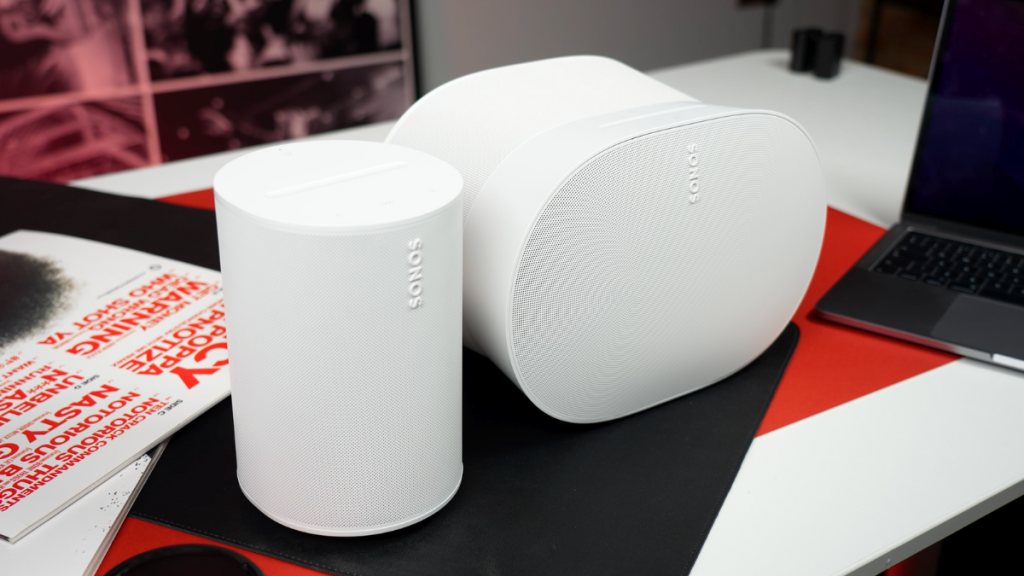
Sonos Era 300:
Priced at £449, the Sonos Era 300 introduces itself as a pioneering and premium option in the Sonos wireless speaker lineup. Thanks to its innovative driver array, the Era 300 features support for Dolby Atmos and spatial audio technology, all compactly delivered in a single unit.
Much like the Sonos Era 100, the Era 300 comes equipped with all of the same functionality, including Bluetooth 5.0, Wi-Fi 6, and the convenience of line-in connectivity through the dedicated Sonos line-in adapter.
Engineered with six drivers strategically placed to deliver sound in all directions, Sonos has designed this speaker to offer listeners an authentic and immersive experience regardless of which capacity you choose to use it in. Find out more in our dedicated Sonos Era 300 Review on YouTube.
Is The Upgrade Worth IT?
There’s no denying that the Sonos One (Gen 2) is still a brilliant speaker, and there was a reason it was so popular. Although its a shame to see it go, looking at both options side-by-side, the Sonos Era 100 offers a clear step up across the board in comparison to its predecessor.
So, if you’ve already invested in or liked the performance of the Sonos One (Gen 2) and are looking to upgrade, then we have no doubts that you’ll love the performance of the Sonos Era 100. However, if this is your first investment in the Sonos ecosystem, you really can’t go wrong with it and the Era 100 will be a great starting point in a budding Sonos home.
Other UseFul Content
Blog: The Best Sonos Speakers to Buy In 2024
Blog: Sonos Era 100 Review: Truly Impressive Stereo Sound
Blog: Sonos Era 300 vs Sonos Five: Which Premium Speaker is Best?
We hope you find this helpful, but of course, we realise that purchasing a new speaker is a big decision, so we are more than happy to assist with any queries you may have.
Please reach out on:
| info@smarthomesounds.co.uk | |
| Live Chat on our Website | |
| 0800 677 1100 |
Following the news that the Sonos One (Gen 2) and Sonos One SL are set to be discontinued, we explore what’s the next best wireless speaker option for you and your home.
Which Sonos Speaker IS Best For Your Home?
Sonos’ ever-expanding lineup of smart speakers, soundbars, portable speakers and subwoofers has rightly asserted itself as one of the best audio options around. Promising stunning sound, second-to-none multi-room functionality, a simple setup and more, there’s plenty to choose from, but which is the best Sonos speaker for you?
Most people have a broad idea of what they’re looking for - a smaller soundbar, a speaker for the kitchen, or something to take on the go, for example. With so much choice at a range of different prices (in a lineup that’s only getting bigger), landing on the perfect product can be a little harder than you’d think.
We’ve tested every Sonos wireless speaker extensively, and we’ve created this blog to narrow down the options and help you find the best Sonos speaker for every use case so you can spend less time fretting and more time enjoying the audio you love.
Best Sonos Speakers to Buy In 2024
Questions TO Help Find the Best Fit
| What space are you filling? Sonos offers a variety of spaces that vary in size and sound performance. The first thing to consider is what your space looks like and what sort of audio device you need. Do you have an open-plan living area, or are you looking to fill a study? Both options can drastically change what speaker is right for you. What's your budget? This is an obvious question, but not one to be overlooked. Budget is often one of the main barriers when picking the perfect speaker for your space. However, sticking to a budget can help narrow down the options a lot. Thankfully, Sonos offers plenty of high-performing speakers at a range of prices to ensure there is something right for everyone. Are you planning on expanding your system in the future? The beauty of Sonos is its adaptability. Adding extra components to create a home cinema is ridiculously simple, and moving the speakers around to fit different purposes is easy too. The opportunities are endless with Sonos, but its worth having a rough idea of your plan so you can make the right decision the first time around. Is this speaker for movies, music or both? Sonos speakers are extremely versatile and offer high fidelity for both movies and music. However, if either one is a priority, there are specific options that can fit both use-cases better than others. For example, the Sonos Arc is a no-brainer for movies (and music), whereas the Sonos Five is a killer option for Hi-Fi-like music quality |
Best Sonos Speaker to Get Started With:
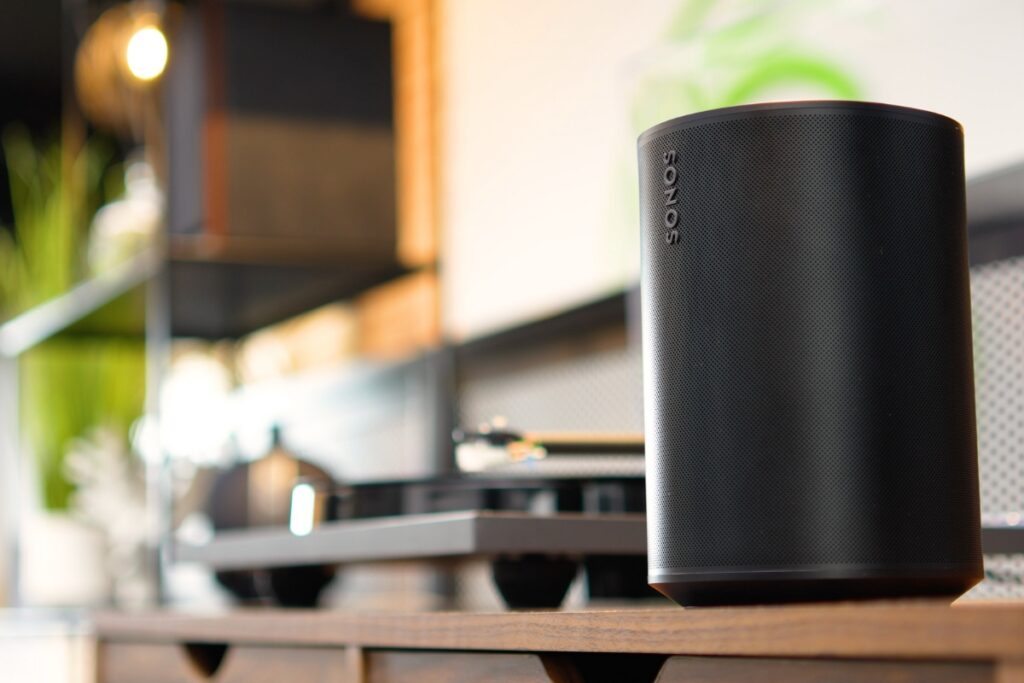
Sonos Era 100 (RRP £249)
| See Latest Price: Available at Smart Home Sounds - Includes Free 6 Year Extended Warranty Available at Sonos.com Available at Amazon.co.uk |
The Sonos Era 100 is the brand’s new and improved smart speaker. It replaces the older Sonos One (Gen 2) and has a 25% larger woofer for deeper bass and two angled tweeters offering stereo sound. This new-look speaker also features a refreshed appearance and better connectivity, including Wi-Fi 6, Bluetooth support, and the ability to play audio from a wired source using the optional Sonos Line-In Adapter.
The Era 100 has taken everything good from the Sonos One (Gen 2) and made it even better. Its refreshed topside controls and compact footprint still make it the perfect companion for your bedside table, desktop or kitchen counter. While the improved stereo performance gives this speaker an edge over its predecessor when it comes to sound.
Along with the improvements to the sound quality, the Era 100 is now an even more versatile option too, offering support for both Bluetooth and line-in (which wasn’t available on the Sonos One). This means playing the music you love on Sonos is easier and more accessible than ever before.
Era 100 also maintains hands-free voice control via Sonos Voice and Amazon Alexa. However, there’s no support for Google Assistant.
The Era 100 is the easiest Sonos speaker to integrate into the home, and because it can be stereo paired or used as surround sound rears in a Sonos home cinema, it can be easily expanded on too. It’s the perfect starting point for a budding Sonos ecosystem, no doubt about it.
More: Sonos Era 100 Review: Truly Impressive Stereo Sound
Best Sonos Speaker For A Small Room
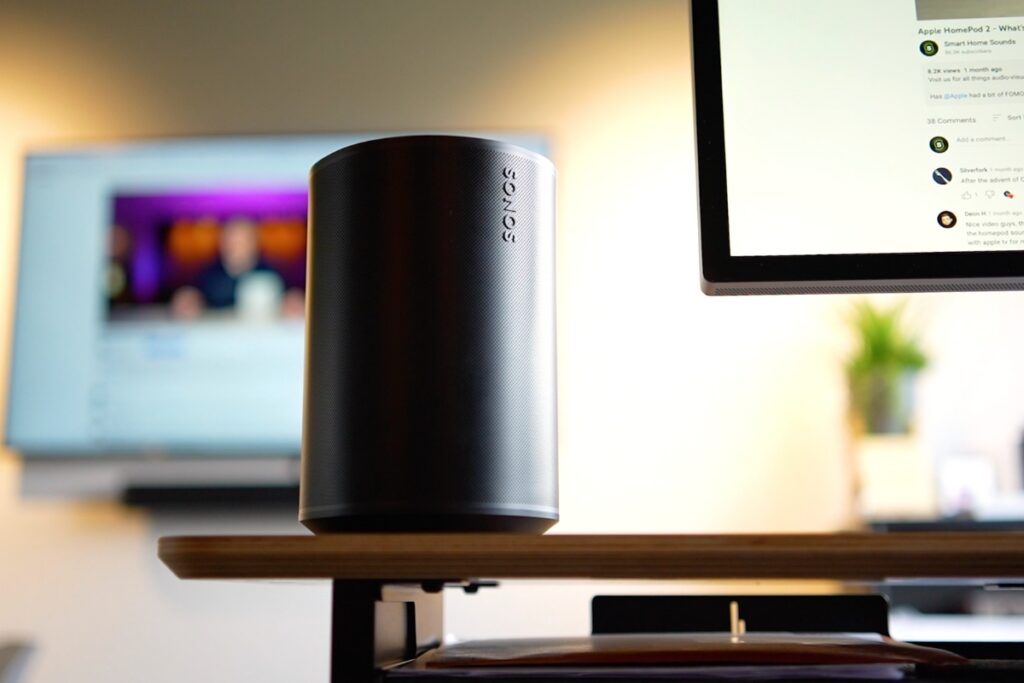
Sonos Era 100 (RRP £249)
| See Latest Price: Available at Smart Home Sounds - Includes Free 6 Year Extended Warranty Available at Sonos.com Available at Amazon.co.uk |
For all of the reasons mentioned above, the Era 100 is also our top choice for small spaces. Packed full of smarts and possessing upgraded sound performance to match, this will be a worthy single speaker solution for almost every small room.
Best Sonos Speaker For Spatial Audio
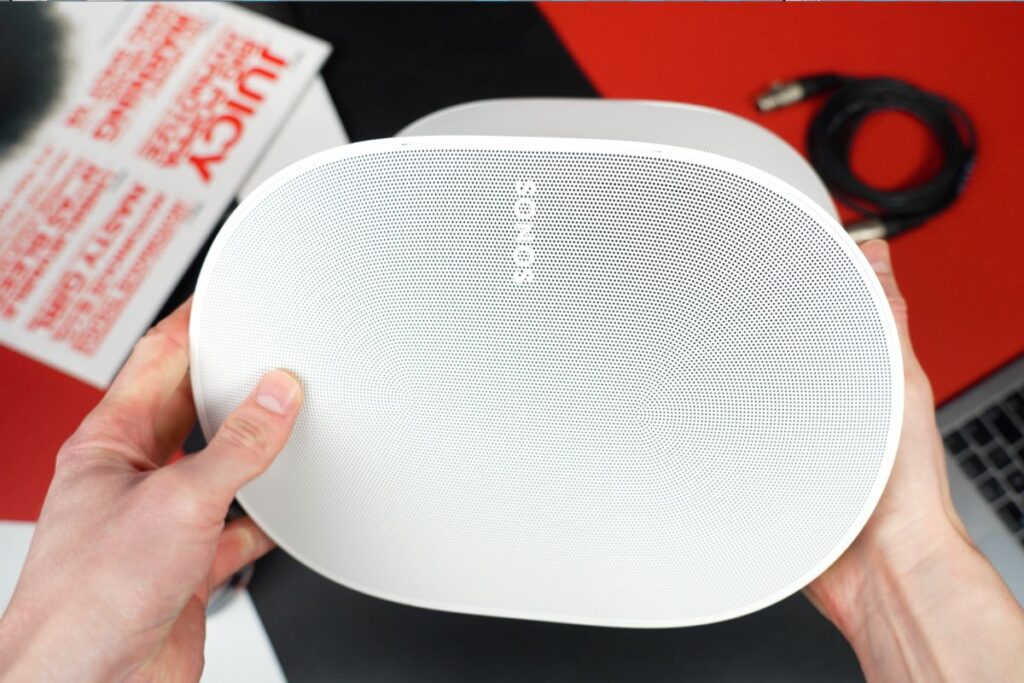
Sonos Era 300 (RRP £449)
| See Latest Price: Available at Smart Home Sounds - Includes Free 6 Year Extended Warranty Available at Sonos.com Available at Amazon.co.uk |
The Sonos Era 300 treads new ground for a Sonos smart speaker, casting its sights on the world of spatial audio and Dolby Atmos. Featuring the same line-in and Bluetooth support as the Era 100, this speaker is equally versatile yet considerably more immersive.
Offering a sneak peek into the future of music, the Era 300 features six drivers that fire in all directions, including upwards, to demonstrate the immersive potential of spatial audio and Dolby Atmos. The Sonos Era 300 effortlessly delivers a three-dimensional sound signature that will take your favourite spatial tracks from the likes of Apple Music or Amazon Music to the next level.
Convincing sound that comes from all around you has never been better replicated by a single unit (hence why producers are using these in the spatial audio mixing studios themselves). The Era 300 bounces sound off the walls and ceiling in your listening zone to create a compelling and all-encompassing audio experience that only gets better when you stereo-pair two together.
You can also pair two as surround sound rears with a Dolby Atmos soundbar in a Sonos home cinema, making this Sonos’ only upward-firing rear option available. Naturally, this offers a mind-blowing level of immersion. However, this is a luxury deployment of these speakers, and if you don’t have the budget to spare, a pair of Sonos Era 100’s will be more than sufficient.
Spatial audio is still a little hit and miss and isn’t yet widely available, but if you’re looking for the best way to enjoy this new format, the Sonos Era 300 is the way to go.
More: Sonos Era 300 Review: One Month On...
Best Sonos Speaker For Hi-Fi Listening
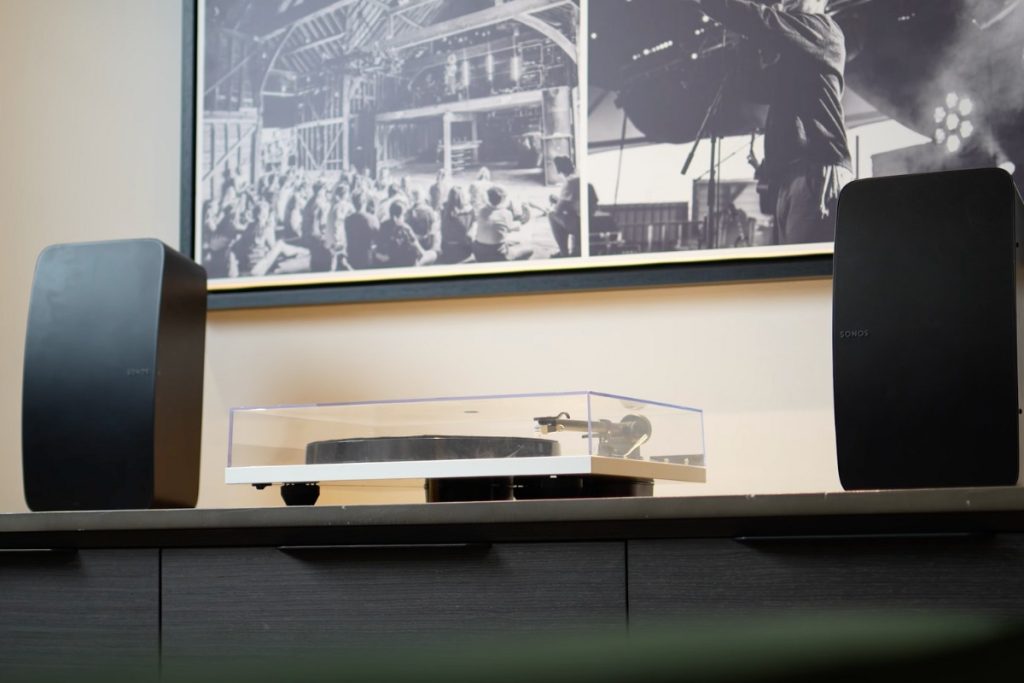
Sonos Five (RRP £549)
| See Latest Price: Available at Smart Home Sounds - Includes Free 6 Year Extended Warranty Available at Sonos.com Available at Amazon.co.uk |
Sitting as the powerhouse in the Sonos lineup, the flagship Sonos Five is the brand's biggest and most room-filling speaker (excluding soundbars, that is). Released as a replacement for the Play:5 in 2020, the Sonos Five preserves a lot of the essential features that its predecessor was well known for and builds on them.
The driver array follows a very similar blueprint to the Play:5, with six class-D amplifiers powering three 10cm mid-woofers and three tweeters. There’s still a 3.5mm aux line-in to connect an external device, and you can still orient the speaker in three different ways. However, the Sonos Five includes improved wi-fi connectivity and improved processing to step up the performance even further.
The Sonos Five is the flagship option in the Sonos lineup, and you can tell. No, it doesn’t offer the same depth and immersion as something like the Sonos Era 300. But the Five is capable of unleashing some detailed rip-roaring power that’s perfect for traditional hi-fi and for listening loud.
Admittedly, it lacks the versatility of some of the newer Sonos speakers (there’s no voice control, bluetooth or spatial audio). But if you’re on the lookout for a more traditional stereo speaker that offers pure hi-fi quality without any of the fuss, the Five will be a great option.
More: Sonos Era 300 vs. Sonos Five: Which Premium Speaker is Best?
Best Portable Sonos Speaker
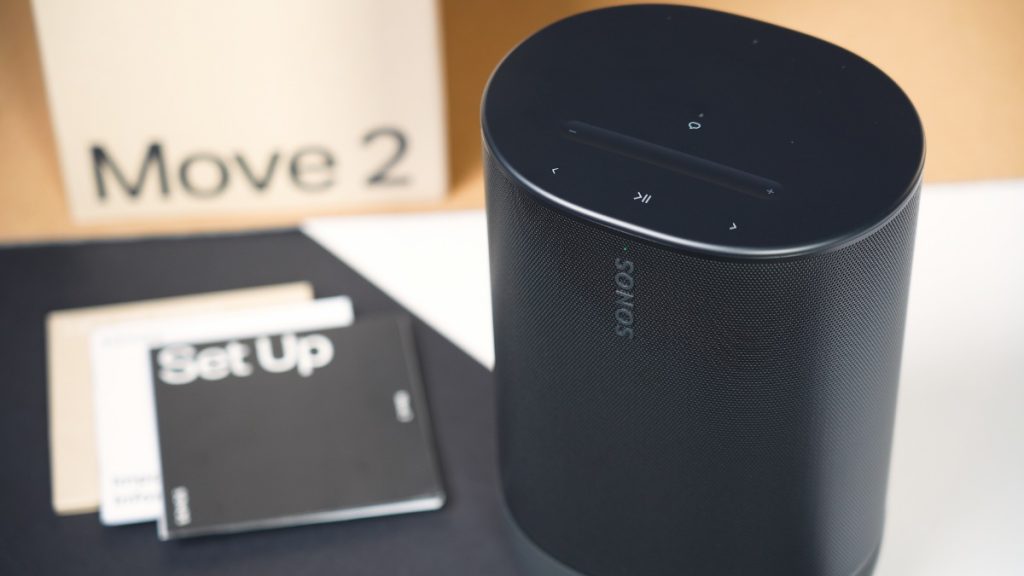
Sonos Move 2 (RRP £449)
| See Latest Price: Available at Smart Home Sounds - Includes Free 6 Year Extended Warranty Available at Sonos.com Available at Amazon.co.uk |
The Sonos Move 2 is the second iteration of Sonos' popular portable speaker, and it's an all-around improvement over its predecessor. It offers up to 24 hours of playback on a single charge (double the battery life of the original Move), as well as stepped-up stereo sound thanks to new dual-tweeters. Sonos has also expanded the USB-C functionality of the Move 2 and given it a refreshed design that's just as durable as the original.
The Move 2 is what we'd call a "hybrid portable speaker." It's not quite as compact and lightweight as the Sonos Roam, making it less suitable for tossing in a backpack and taking on the go. But it's still easy to move around the house and garden, thanks to its built-in handle and IP56 weatherproof rating.
It also comes with an upgraded charging dock as standard, making it easy to keep it topped up when you're not using it. There’s also support for Bluetooth, line-in via USB-C and powerbank functionality too.
Performance-wise, the Move 2 sits somewhere between the Sonos Era 100 and the Sonos Era 300. The updated internals ensure the bass output is punchy, the soundstage is full, and the details are crisp and clear too. Bundle all of that with the added functionality, and you’re looking at a very successful sequel that can deliver signature Sonos quality in every room in the house. Sounds like a no-brainer, right?
More: Sonos Move 2 Review: Premium Portability Perfected?
BEst SOnos Speaker For Taking on The Go

Sonos Roam (RRP £179)
| See Latest Price: Available at Smart Home Sounds - Includes Free 6 Year Extended Warranty Available at Sonos.com Available at Amazon.co.uk |
The Sonos Roam is a small, lightweight, and versatile portable Bluetooth speaker that's perfect for bringing signature Sonos sound everywhere you go. It's IP67 weatherproof rated, so you can use it in the bathroom, kitchen, or even outdoors. And when you're at home, it can connect to your Wi-Fi network and be used as part of your wider Sonos system.
You can stream music to the Roam from your phone, tablet, or computer, or even play your vinyl collection from a Bluetooth-enabled turntable. The Roam also features built-in mics for voice control, but if that’s not for you, you could opt for the Sonos Roam SL, which goes without voice control and comes in at a cheaper price of £159.
As the smallest speaker in the lineup, the Sonos Roam won’t offer the same impactful sound as some of its bigger counterparts. But the audio is clean, detailed and very impressive for such a small unit. If you’d like a little more, you could always pair two together for a more immersive stereo performance too.
The Roam is the out-and-out portable option from Sonos, and quite frankly, its hard to argue with. If you’re always on the go and need a compact and reliable sound companion, the Roam will tick the majority of your boxes.
More: Sonos Roam Review: The Best Portable Speaker in 2023?
Best Budget Sonos speaker
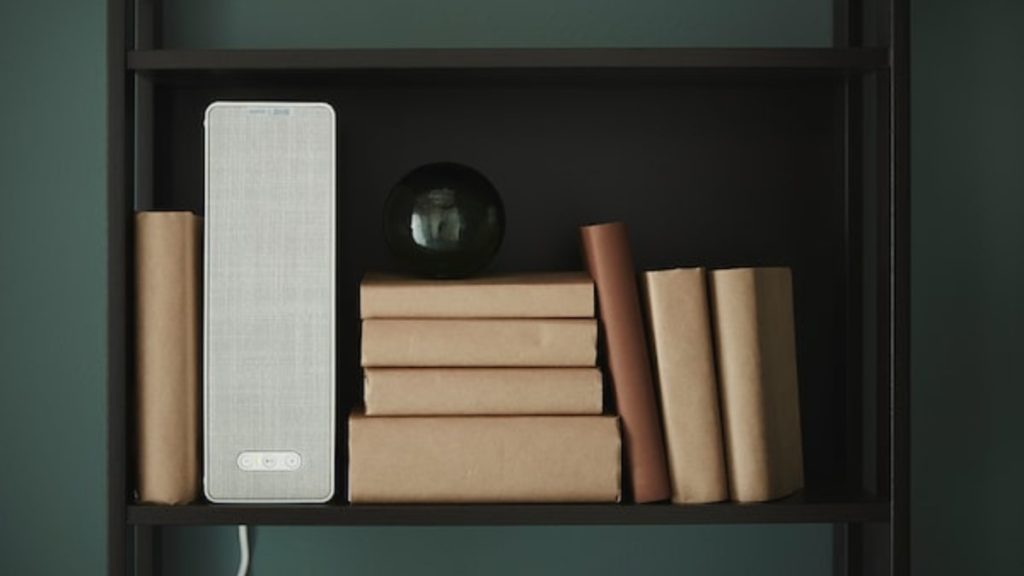
IKEA Symfonisk Bookshelf Speaker (RRP £115)
| See Latest Price: Available at ikea.com |
A joint venture between IKEA and Sonos, the IKEA Symfonisk Bookshelf speaker is the perfect entry-point into the Sonos ecosystem if you’re looking to spend under £150.
This stylish lifestyle-focused bookshelf speaker offers a pretty similar performance to the fan-favourite Sonos One (Gen 2) and can be stereo paired or used as rear surrounds in a Sonos Home Cinema. No, this won’t be for everybody, but if you’re looking for an easy and low-risk way to get into Sonos, this will be it.
IKEA also offers a variety of accessories to seamlessly integrate this speaker into your home, which is an added bonus too.
Best Sonos Dolby Atmos SOundbar
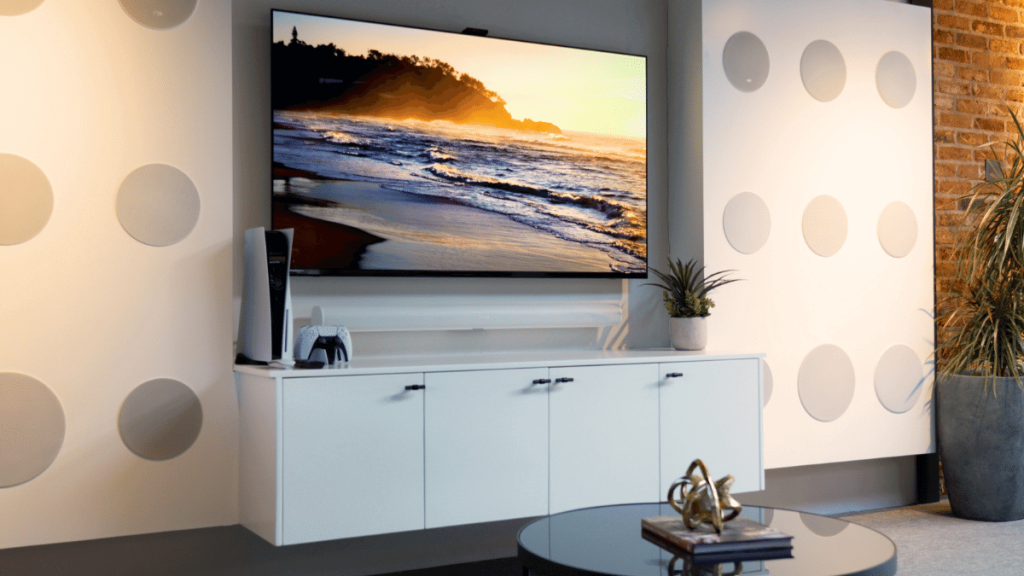
Sonos Arc (RRP £899)
| See Latest Price: Available at Smart Home Sounds - Includes Free 6 Year Extended Warranty Available at Sonos.com Available at Amazon.co.uk |
Sonos’ flagship Dolby Atmos soundbar is everything you’d expect and more. The Sonos Arc is expensive, but if compelling surround sound performance in a stylish one-bar package is what you’re after, nothing matches it at this price point.
It’s a big unit that we recommend for TVs that are 55 inches or bigger, but this size is necessary to accompany the 11-driver phased array.
The Arc’s dedicated upward, side and front-firing drivers all help to deliver one of the most convincing three-dimensional Dolby Atmos surround sound presentations we’ve heard from a single soundbar, with a wider soundstage than any other Sonos soundbar in the lineup.
Of course, Sonos has also long been the gold standard for usability, and the Arc follows this same mantra with all the usual Sonos functionality built-in. Setup is super simple, and adding additional components like a Sonos Sub (Gen 3) for added bass or a pair of Era 300’s for enhanced surround performance is easy too.
The Arc is easily the best soundbar in the Sonos lineup, and we’d go as far as to say its the best standalone Dolby Atmos soundbar at its price point in the wider market too. It’s a phenomenal performer for all types of audio, and although there may be better out there, you need to be prepared to spend even more to get your hands on them.
More: Sonos Arc Review: Is It Worth It In 2023?
Best Compact Sonos Dolby Atmos Soundbar
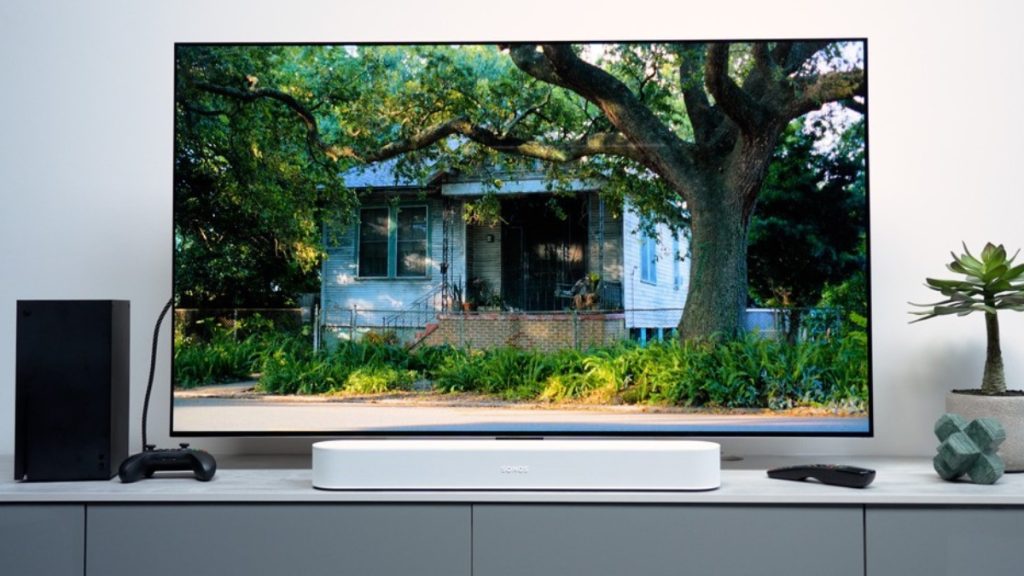
Sonos Beam (Gen 2) (RRP £499)
| See Latest Price: Available at Smart Home Sounds - Includes Free 6 Year Extended Warranty Available at Sonos.com Available at Amazon.co.uk |
Don't let the Sonos Beam (Gen 2)'s compact size fool you. This is a multi-award-winning soundbar that doesn’t just talk the talk; it walks the walk too.
Despite lacking physical upward-firing height speakers, the Beam (Gen 2) offers a thoroughly convincing presentation of Dolby Atmos surround sound, even though the height channels are delivered virtually.
Atmos aside, whether you’re enjoying TV audio, music or radio, it will feel both crystal clear and expansive, making it an excellent option for filling small-to-medium-sized rooms. In our opinion, this is comfortably the best compact Dolby Atmos soundbar at this sort of price.
No, it's not quite the Sonos Arc, but the Beam (Gen 2)'s compact dimensions make it super easy to integrate into your home. Factor in the fact that you're getting all of Sonos' multi-room and streaming features for a more wallet-friendly price; I can assure you, you won’t wish you had gone any bigger.
More: Sonos Beam (Gen 2) Review: Is It Worth It In 2023?
Best Sonos Soundbar For A Small Room
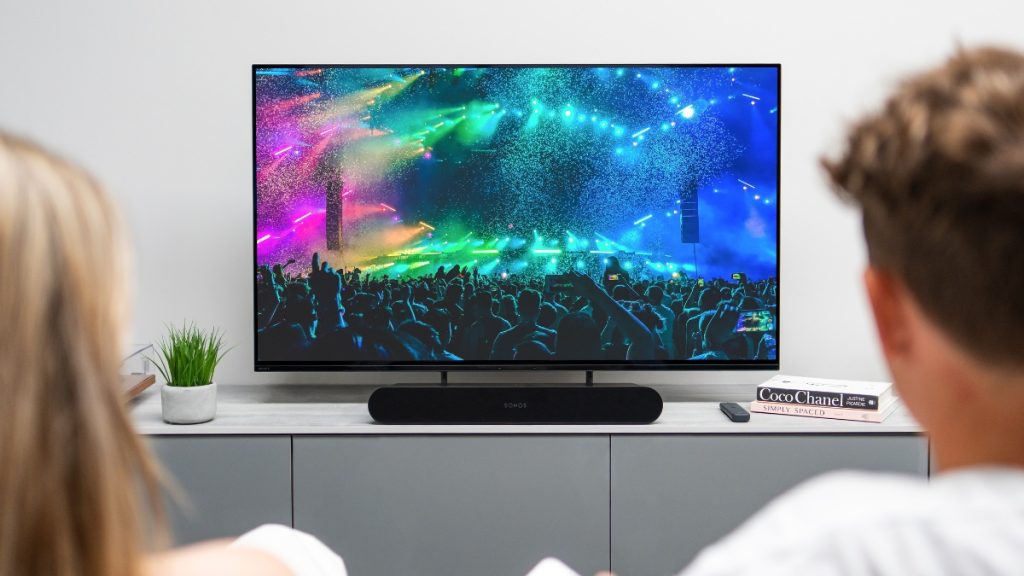
Sonos Ray (RRP £279)
| See Latest Price: Available at Smart Home Sounds - Includes Free 6 Year Extended Warranty Available at Sonos.com Available at Amazon.co.uk |
The Sonos Ray is Sonos’ entry-level soundbar that’s ideal for the smaller spaces within your home. Coming in at £279, this will be a neat option to improve the vocal and mid-range performance of any secondary TV’s within your space.
There’s no HDMI connection (the Ray uses optical), Dolby Atmos support or dedicated centre channel for dialogue. However, the Ray will deliver Dolby Digital audio and a balanced, size-defying sound quality that will undoubtedly give your TV a much-needed boost.
The Ray does fall short of the other Sonos soundbars, but it's a smart choice if you’re looking for a simple solution to achieve good sound for both music and movies in the smaller spaces in your home. You can create a full home cinema with the Ray, but our advice would be to save for the Beam (Gen 2) if that’s your plan, budget-providing, of course.
More: Our Comprehensive Sonos Ray Review
Best Sonos Surround Sound Rears
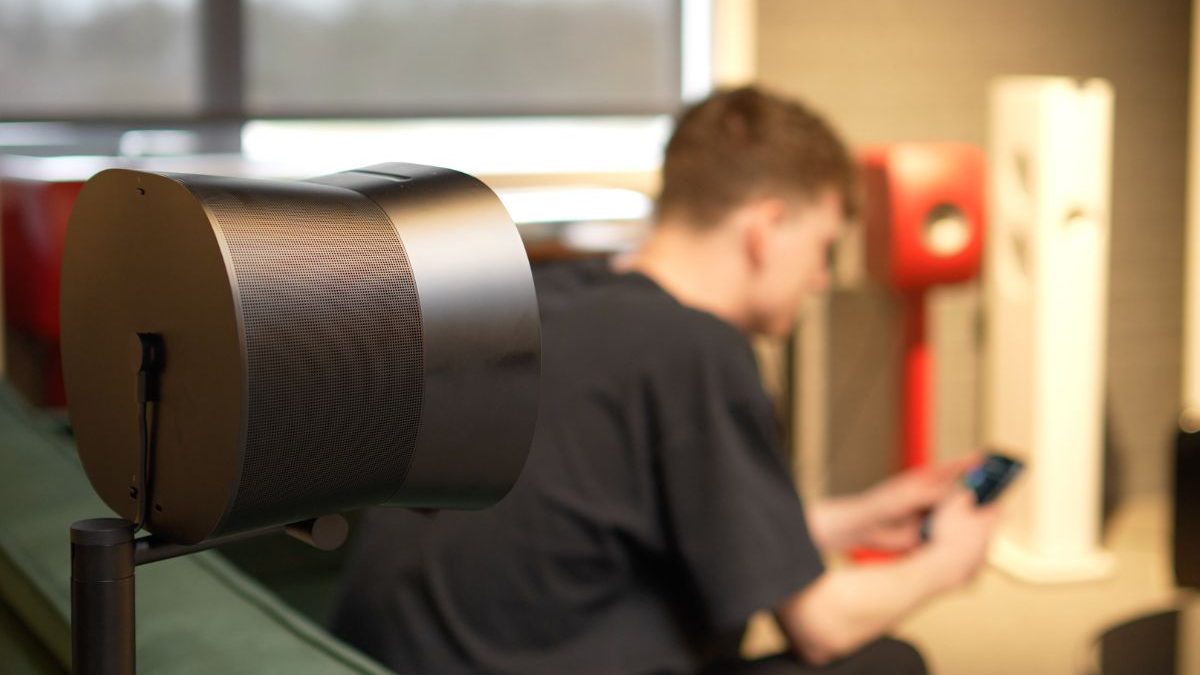
2x Sonos Era 300 (RRP £898)
| See Latest Price: Available at Smart Home Sounds - Includes Free 6 Year Extended Warranty Available at Sonos.com Available at Amazon.co.uk |
The Sonos Era 300’s may not be the most cost-effective surround-sound rear option, but when it comes to pure performance, they are the best. As Sonos’ only upward-firing rear option, they deliver a level of immersion that is unmatched by any other choices within the Sonos lineup, and if money was no object, they’d be our go-to option every time.
Its worth remembering that the Era 300’s are only compatible with Sonos’ Dolby Atmos sounbars. So, if you’re planning on using these as surround sound rears, you’ll need a Sonos Arc or Beam (Gen 2) to do so. We often recommend the Sonos Arc and a pair of Sonos Era 300’s as our killer combination, as it delivers a truly immersive cinematic experience that Sonos has never offered before.
Of course, if this feels slightly out of budget, the option of a pair of Sonos Era 100’s is also very tempting. Despite not offering the same immersive potential as the Era 300’s, the Era 100’s will offer more than enough performance to feel truly captivating at an even more affordable price point.
More: Adding Sonos Surround Sound Speakers: Our Top 3 Tips
Best Sonos Subwoofer
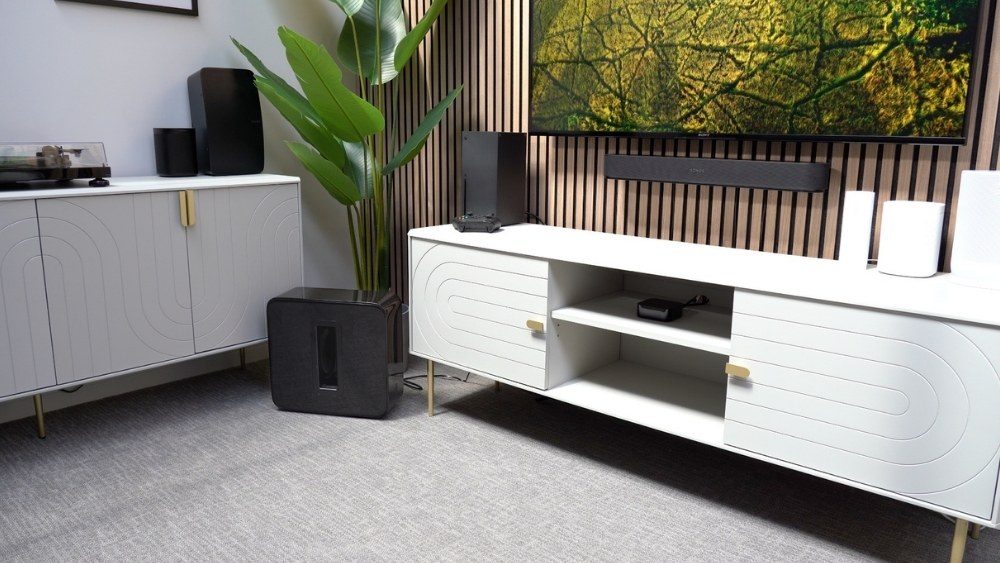
Sonos Sub (Gen 3) (RRP £799)
| See Latest Price: Available at Smart Home Sounds - Includes Free 6 Year Extended Warranty Available at Sonos.com Available at Amazon.co.uk |
Unlock the full power of your Sonos home cinema with Sonos’ flagship subwoofer. The Sub (Gen 3) will take your audio to the next level, adding new layers and rumbling bass to your favourite music and movies. If you love your bass-heavy music and high-octane blockbusters and you’re willing to look past the premium price tag, this will undoubtedly be the right option for your space.
Compatible with all Sonos soundbars, this is the best choice if your looking to add bass that you can really feel. The Sub (Gen 3) is also capable of being positioned upright or flat on the floor, so this Sub can be neatly tucked under furniture if need be to keep the bass discrete yet uncompromisingly bold.
We normally suggest this as the perfect partner for the Sonos Arc, as their expansive and powerful performances compliment each other exceptionally well, especially in large open-plan living spaces.
More: Sonos Sub Review: Boost Your Setup With Big Bass
Best Budget Sonos Subwoofer
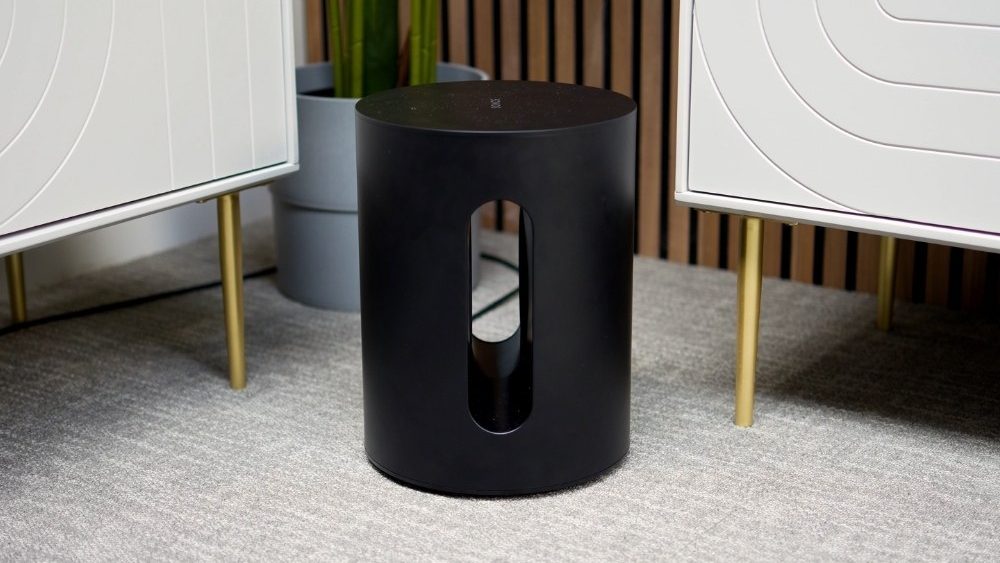
Sonos Sub Mini (RRP £429)
Despite not matching the heights of the Sonos Sub (Gen 3), the Sonos Sub Mini is a compact subwoofer option that still delivers snappy and impactful bass that goes as low as 25 Hz.
Perfect for bringing big sound to smaller spaces, the Sub Mini has been designed to maximise its bass output from its compact form factor, pushing its bigger brother surprisingly close at lower volumes. Admittedly, its not quite as dynamically nuanced as the Sub (Gen 3), but it offers impressively clean and tight bass that will unleash more depth from all of your films and music.
Its compact, cylindrical shape also makes it the perfect subwoofer to tuck in the corner of your room and forget about while you sit back and enjoy the show.
We tend to recommend pairing the Sub Mini with the Sonos Beam (Gen 2), as they’re brilliantly matched tonally. The larger Sonos Arc can often feel slightly overpowering, so we’d suggest stepping up to the bigger Sub (Gen 3) if you want optimum performance.
More: Sonos Sub Mini Review: The Right Sonos Subwoofer For You?
More: Sonos Sub Mini vs. Sonos Sub (Gen 3): Which Subwoofer is Right For Me?
Best Sonos Setup For A Living Room
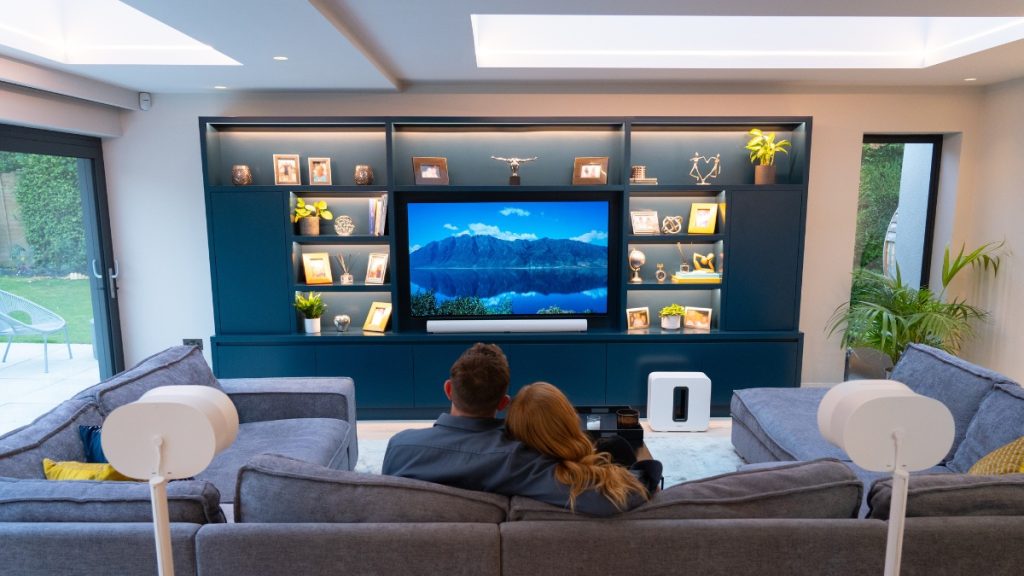
Sonos Arc, Sonos Sub (Gen 3) & 2x Sonos Era 300's (RRP £2,596)
| See Latest Price: Available at Smart Home Sounds - Includes Free 6 Year Extended Warranty Available at Sonos.com Available at Amazon.co.uk |
A film fanatics dream, this is the best Sonos Home Theatre setup you can buy from Sonos, no doubt about it. However, you’ll be paying a stiff premium to get your hands on one. That being said, if money’s no object and a comprehensive home cinema is what you’re after, then you’re looking in the right place.
With all three Sonos flagship home cinema components working together, you can expect the most immersive sound possible from a complete Sonos surround sound system.
The Sonos Arc and the new upward-firing Sonos Era 300s combine their overhead channels to deliver stunningly detailed and accurate Dolby Atmos height effects, while the Sub (Gen 3) offers ground-shaking bass that will transport you to the centre of the action.
More: Testing EVERY Sonos Arc Home Cinema Setup
Best Budget Sonos Setup For A Living Room
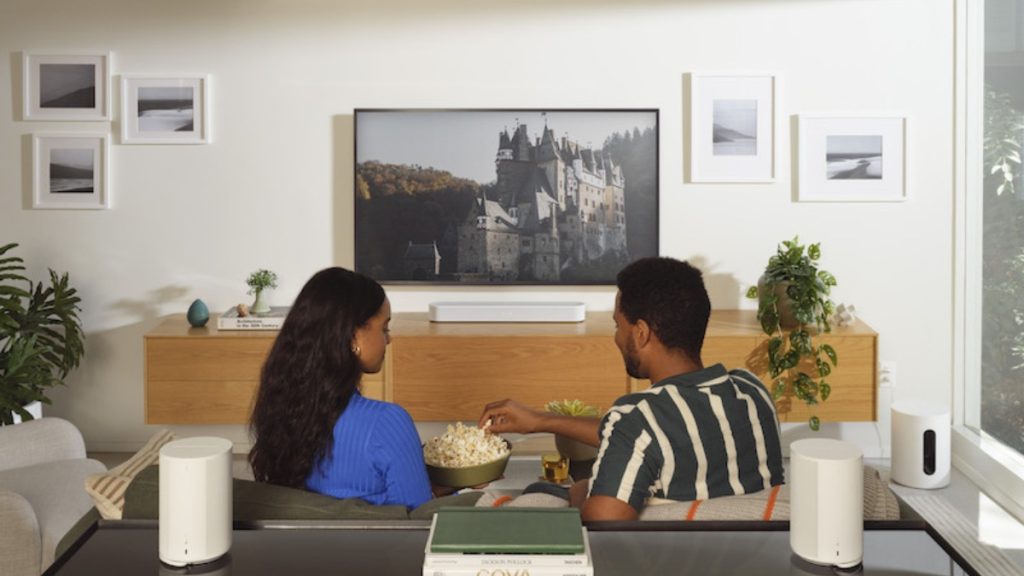
Sonos Beam (Gen 2), Sub Mini & 2x Sonos Era 100's (RRP £1,426)
| See Latest Price: Available at Smart Home Sounds - Includes Free 6 Year Extended Warranty Available at Sonos.com Available at Amazon.co.uk |
As one of the most popular options when it comes to Sonos Home Cinema, this compact bundle combines three exceptional Sonos speakers that are more manageable, more discreet and, most importantly, more affordable than their flagship counterparts.
This bundle is perfect for those with small-to-medium-sized rooms looking for a complete home cinema package and offers a performance that is very hard to beat at this price point.
The multi-award winning Beam (Gen 2), Sonos Era 100 pair, and Sonos Sub Mini are all perfectly matched to deliver captivating Dolby Atmos audio with clean and tight low-end in an impressively compact package. No, it won’t compete with its larger peers, but if space is limited, this is the best way to achieve optimum immersion.
More: Testing EVERY Sonos Beam (Gen 2) Home Cinema Setup
Best Sonos Accessory
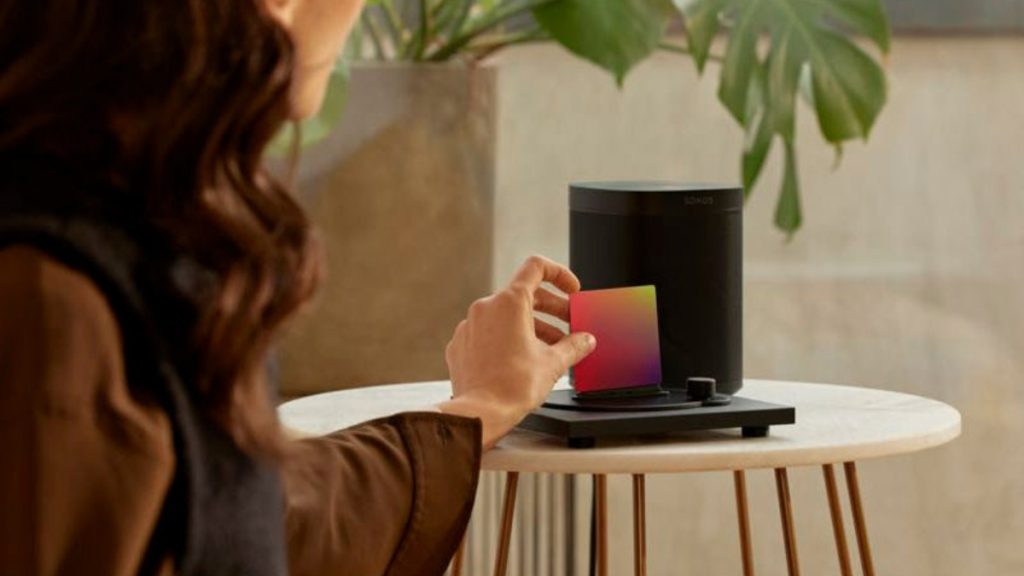
MoodPlay (RRP £223)
| See Latest Price: Available at moodblocks.com |
A brand-new take on music, MoodPlay brings the tactile joy of traditional music listening to the digital world through your Sonos speakers.
‘Works With Sonos’ certified, this device works with MoodBlocks, which are uniquely designed smart cards with built-in NFC technology. These can contain thousands of songs, as well as albums, audiobooks and playlists.
Combine this with your Sonos speaker, and you’ve got a stunning physical copy of your favourite music that feels worth having on show. It’s unique, fully customisable and an exciting product that we think has a big future in the world of Sonos.
Best Turntable To USe With Sonos

Pro-Ject T1 Phono SB (RRP £379)
| See Latest Price: Available at Smart Home Sounds - Includes Free 6 Year Extended Warranty Available at Amazon.co.uk |
Built with no plastic parts, an aluminium tonearm and an Ortofon OM 5E cartridge fitted as standard, this turntable is a standout entry-level performer that combines both convenience and ease of use in a stunning, premium-feeling vinyl package.
The Pro-Ject T1 Phono SB also features an integrated bypassable preamplifier for simple connection to any hi-fi system, which is the main reason why this is our go-to choice for combining with a Sonos system.
More: Pro-Ject T1 Phono SB vs. Rega Planar 1 Plus
Best Sonos Product In 2024
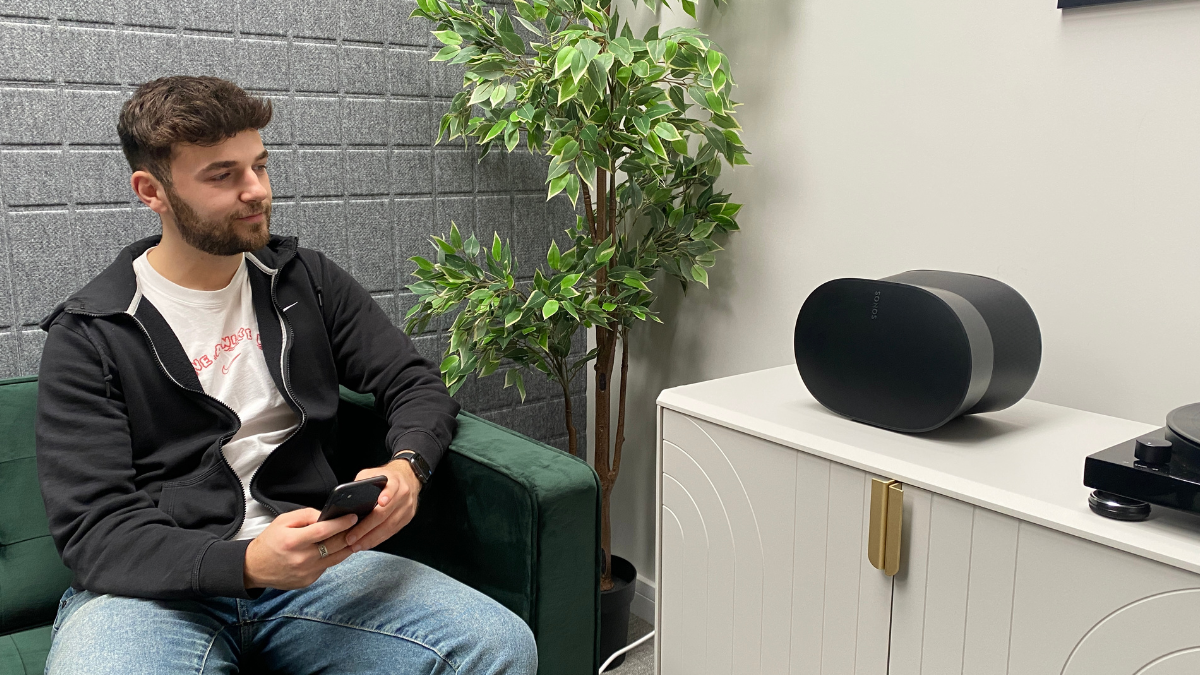
Sonos Era 300 (RRP £449)
| See Latest Price: Available at Smart Home Sounds - Includes Free 6 Year Extended Warranty Available at Sonos.com Available at Amazon.co.uk |
As a completely new entry for Sonos back in 2023, its hard to argue with the Sonos Era 300 being our best pick overall. Spatial audio support, enhanced connectivity and the joy of upward-firing surround sound rears have been on our wishlist for a while now. So, to see this put into practise makes this more than a worthy choice as our best Sonos product this year.
More: Sonos Era 300 Review: Game Changer
We hope you find this helpful, but of course, we realise that purchasing a new soundbar is a big decision, so we are more than happy to assist with any queries you may have.
Please reach out on:
| info@smarthomesounds.co.uk | |
| Live Chat on our Website | |
| 0800 677 1100 |
There’s a Sonos speaker perfect for the occasion, discover which one is right for your space.
The Complete Sonos Beam (Gen 2) Buyers Guide
Released to replace the original Sonos Beam in 2021, the Sonos Beam (Gen 2) is a multi-award-winning compact soundbar that is still widely regarded as one of the best value-for-money options on the market right now.
Featuring a five-driver multidirectional array, Dolby Atmos, HDMI eARC support, and a sleek and stylish design, the Sonos Beam (Gen 2) is a more than convincing sequel that has well and truly earned its place in compact soundbar folklore.
However, with the likes of the Sennheiser Ambeo Mini and the Bose 600 hot on its heels, it begs the question, is the Beam (Gen 2) still worth it in 2024? Well, considering it's been ranked as What Hi-Fi's best entry-level Atmos soundbar for 2024, we'd suggest this is a clear indication that the Beam (Gen 2) is still a more than worthy option this year.
Despite not featuring the same hard-hitting bass output or dedicated upward-firing drivers as its bigger brother, the Sonos Arc, the Beam (Gen 2) has redefined the mid-range soundbar game, and the best thing is, thanks to the great performance, the small dent made in your wallet will definitely feel worthwhile.
We've put the Sonos Beam (Gen 2) to the test in a range of home cinema applications for the purpose of this review to help you decide if it's worth the money and if its still the best compact soundbar for your space.
Article Breakdown:
Haven't got the time to read? Watch our Sonos Beam (Gen 2) Review on YouTube.
Sonos Beam (Gen 2): Strengths & Weaknesses
| Sonos Beam (Gen 2) Strengths | Sonos Beam (Gen 2) Weaknesses |
| ✅ Size-defying sound performance ✅ Supports Dolby Atmos and more ✅ Sleek & Compact design ✅ Simple to setup and upgrade | ❌ No HDMI Passthroughs ❌ No dedicated up-firing speakers ❌ No Bluetooth functionality |
Sonos Beam (Gen 2) - RRP: £499 (See Latest Deals)
Price
When it was released, the Sonos Beam (Gen 2) launched with an original price tag of £449, which was only slightly more expensive than its predecessor. However, following a price adjustment that affected many Sonos products, the Beam (Gen 2) underwent a price increase and now retails at £499.
That being said, as one of the longer standing products in the Sonos range, the Beam’s price does tend to fluctuate, and it’s worth keeping an eye on the market to see if any deals arise. (See Latest Deals)
Why buy from Smart Home Sounds?
We offer an Extended 6 Year Warranty on all Sonos products, as well as 30 Day Extended returns and Free Next Day Delivery*. Looking for more personal advice? Contact our team of experts today.
Shop all Sonos Wireless Speakers.
Design
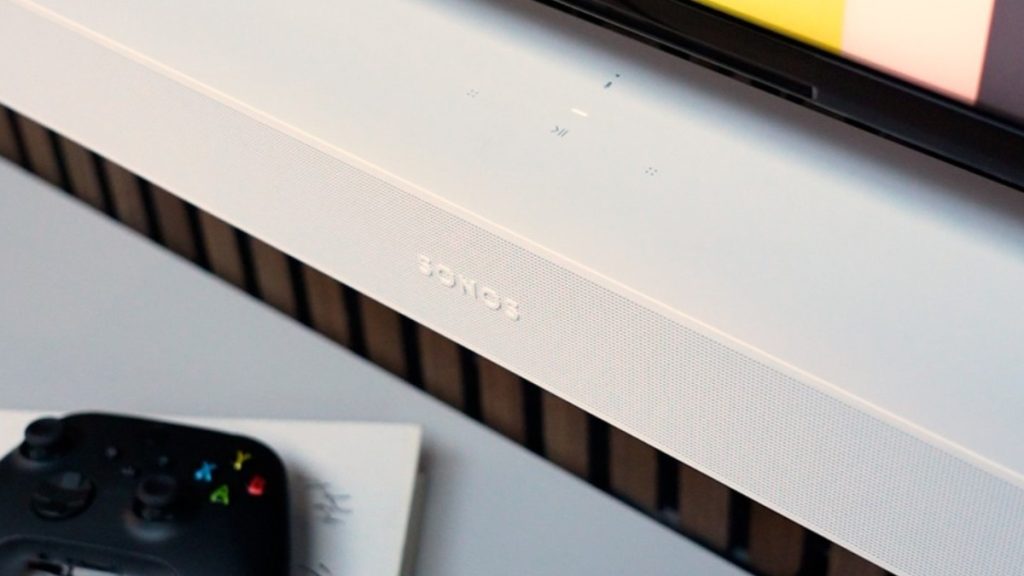
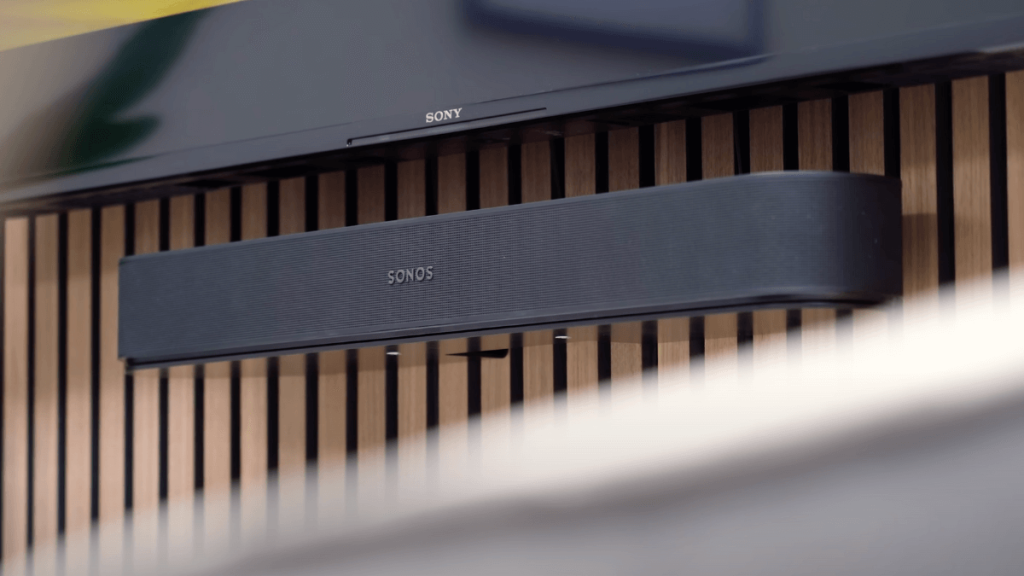
Available in both matte black and matte white, the Sonos Beam (Gen 2) is sleek, compact and remains cohesive with the entire Sonos wireless speaker range.
At a glance, the Beam (Gen 2) looks almost identical to the original Beam, sporting the same compact footprint as its forebear. The most notable difference between the two is its polycarbonate wraparound grille, which has been designed to be easier to clean and more durable than the fabric grille found on its predecessor.
With a width of 65.1cm, we often suggest the Sonos Beam (Gen 2) is best suited for TV’s 55 inches and smaller. However, this is just general advice, and its performance is more than suitable to match a larger TV.
The top panel remains the same, featuring the capacitive touch controls we have become accustomed to seeing with Sonos, including volume, play/pause, skip/previous, and a microphone privacy button for voice control.
On the rear, things remain nice and simple too. You will find your HDMI connection point, an Ethernet port, a join button and the AC power input for straightforward setup.
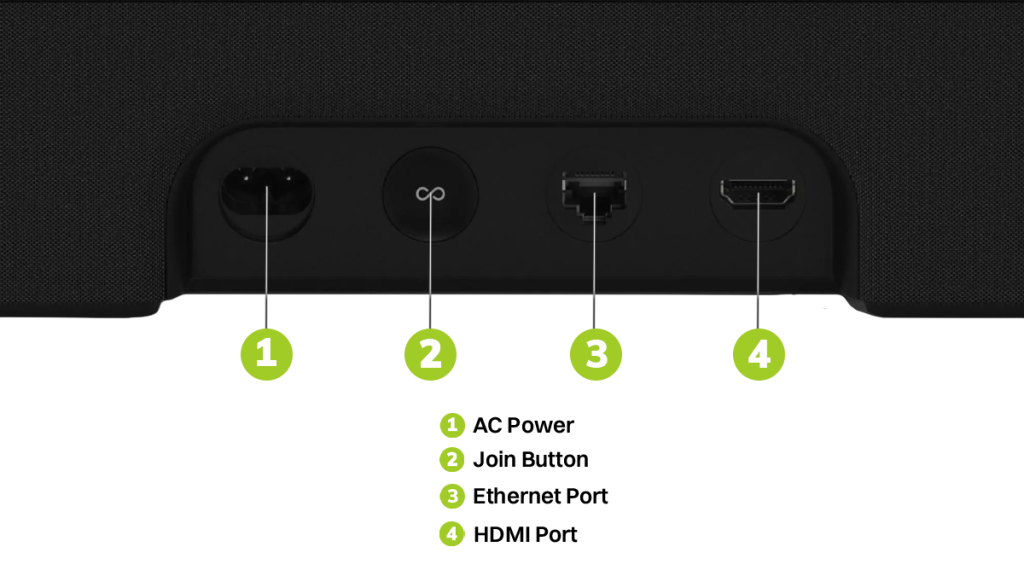
Internals
Internally, the Sonos Beam (Gen 2) has four front-facing elliptical mid-woofers and an improved centre tweeter that has been designed to produce crisper and clearer dialogue than the original Beam.
The Beam also utilises five Class-D amplifiers, while three passive radiators provide reinforcement for the low-end frequencies.
You may notice that the Beam (Gen 2) doesn’t feature any upward-firing drivers yet can deliver three-dimensional Dolby Atmos surround sound. Well, thanks to the 40% faster CPU than its predecessor and five-channel array, the Beam (Gen 2) relies on innovative psychoacoustic technology to create “phantom height channels” that blend with the rest of the audio channels to simulate overhead sounds virtually and create an encapsulating multi-dimensional soundstage.
Audio Performance

Despite its compact form factor, the Sonos Beam (Gen 2) delivers impressively immersive and size-defying sound that goes far beyond its form factor and is more than capable of filling the majority of spaces.
The Sonos Beam (Gen 2) is very versatile and supports a wide range of audio formats, including stereo PCM, Dolby Atmos, Dolby Digital, Dolby Digital Plus, Dolby TrueHD, multichannel PCM, and Dolby Multichannel PCM. This means that you can enjoy your favourite music, movies, and TV shows in the highest possible audio quality, regardless of the source. Its worth noting that there is decoding for DTS digital surround; however, this doesn’t extend to DTS:X.
For us, the vocals and centre channel clarity are phenomenal on the Beam and are undoubtedly this soundbar's standout features. Having tested the Beam (Gen 2) with a variety of different content, ranging from action-packed blockbusters to contemplative character-driven dramas, we love the way the centre channel clarity and dialogue help to cut the noise and deliver depth and details to scenes that you wouldn’t necessarily hear on many other soundbars of this size and price.
The Beam (Gen 2) is also capable of delivering a bass output that is clean and punchy straight out of the box. No, its not quite rumbling in your chest bass, but for a soundbar of this size, it offers plenty enough to fill small or medium-sized rooms.
Of course, you have the option to add either the Sonos Sub Mini or Sub (Gen 3) to really kick the bass up a notch. You could also opt to step up to the larger and more powerful Sonos Arc, which is another personal favourite soundbar of ours.
More: Sonos Arc vs. Beam (Gen 2) & Sonos Sub Mini: Which To Buy?
Although the Beam (Gen 2) doesn’t boast the same Dolby Atmos handling as the Arc (with dedicated upward firing drivers), it still handles the format much better than the majority of soundbars in its respective price range. For example, the Beam managed the dynamic scenes of James Bond: No Time to Die with ease, adding lifelike immersion to the hectic car chases and more depth and detail to the more nuanced and emotive scenes too.
Despite countless new competitors intent on taking its crown, there’s no doubt the Beam is still a class-leader in this department, with audio positioning that feels accurate, expansive and ultimately offers a realistic and compelling audio performance that’s hard to beat.
Along with being impressive for movies, TV and gaming, the Beam (Gen 2) is also a very musical soundbar in its own right. Once again, the centre channel clarity is partly to thank here, delivering vocals that feel both pure and pronounced. Dolby Atmos and spatial audio tracks are also impressive and deliver a lifelike, rich and immersive experience.
Want to hear the Sonos Beam (Gen 2) for yourself? Skip to 13:03 of our Sonos Beam (Gen 2) Review.
Dolby Atmos Enabled - What Does This Mean?
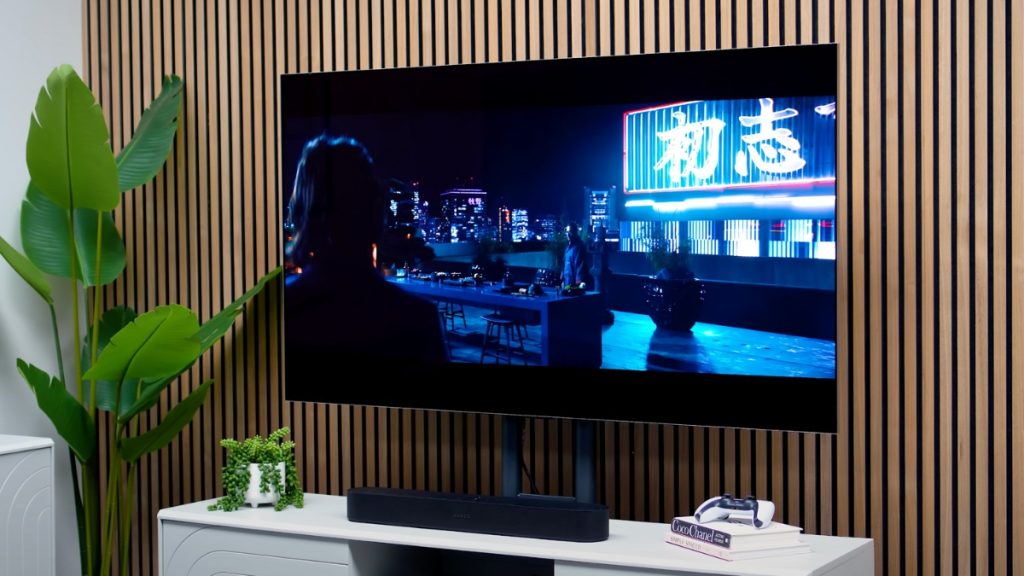
Dolby Atmos is arguably one of the most impactful surround sound formats for home cinema, and it's quickly becoming a must-have feature for soundbar users.
As an object-based sound format, Atmos allows audio producers to have more control over what you hear so they can create a soundstage that better replicates what’s happening on screen.
Dolby Atmos adds height channels, which allow sounds to be interpreted as three-dimensional objects. This makes for a much more immersive audio experience, as sounds can now come from above, below, and all around you.
To put this into context, imagine watching a movie scene with a helicopter flying overhead. With Dolby Atmos, the phantom height channels from your soundbar will activate to create the sound of the helicopter flying directly above you. It's like having your own private IMAX cinema in your living room.
Dolby Atmos is already supported by a wide range of soundbars and TV’s. With more and more content being released in Dolby Atmos every year, there's no better time to upgrade your home cinema system.
How Do I Get Dolby Atmos On My Sonos Beam (Gen 2)
Dolby Atmos requires you to have an HDMI eARC connection on your TV. This is because Atmos uses a higher data transfer rate than Dolby Digital or traditional stereo sound which are playable with a standard HDMI ARC.
Unfortunately, we can’t guarantee that every TV model with an HDMI eARC port supports Dolby Atmos. However, 99% of TVs with this connection option do support Atmos. If you're not sure or your TV has a standard HDMI ARC port, it's worth contacting your TV's manufacturer or the retailer you bought it from. They should be able to help you determine whether or not your TV supports Dolby Atmos.
Should You Add Rears Or A Subwoofer To The Sonos Beam (Gen 2)
If you’re looking for a simple to set up, compact device that can bring cinema-quality audio to your home, the Sonos Beam (Gen 2) will be a great option.
However, the real beauty of Sonos lies in the ecosystem itself. With the option to seamlessly integrate a Sonos Subwoofer, a pair of Sonos Surround Sound Rears, or both to form a complete Sonos home cinema, its understandable to be torn trying to figure out which is the best way to go.
Truthfully, there is no right or wrong here; each element will enhance your home cinema’s performance, but we recommend picking the components that match your listening preferences, space and budget.
More: Sonos Home Cinema Upgrades | Sub vs. Surrounds
Adding a Subwoofer
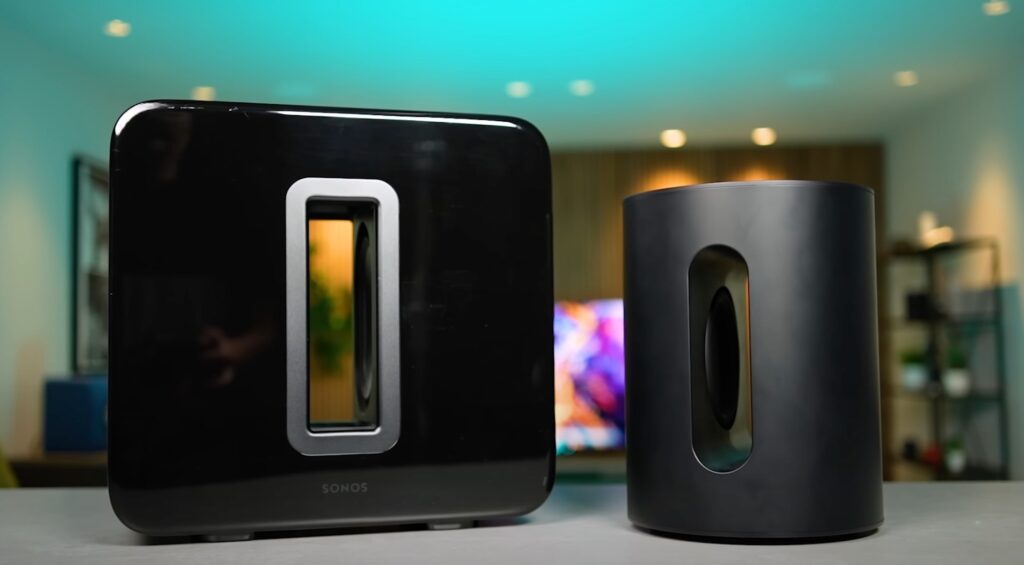
Sonos offers two compatible subwoofers for your home cinema, the compact Sonos Sub Mini and the Sonos Sub (Gen 3). Built to deliver more than just bold bass, these subwoofers are also designed to take the load of the lowest frequencies from your soundbar and other Sonos speakers. This in turn, affords your Sonos Beam more processing power to deal with dialogue and mid-range much more effectively.
From our extensive testing, we’d suggest the Sonos Sub Mini is the best match for the Beam (Gen 2); along with both being relatively discreet options, the pair compliment each other exceptionally well and make for a killer combination in those smaller or medium-sized home cinema setups.
More: Sonos Sub Mini vs. Sonos Sub (Gen 3)
Adding a Pair of Surround Sound Rears
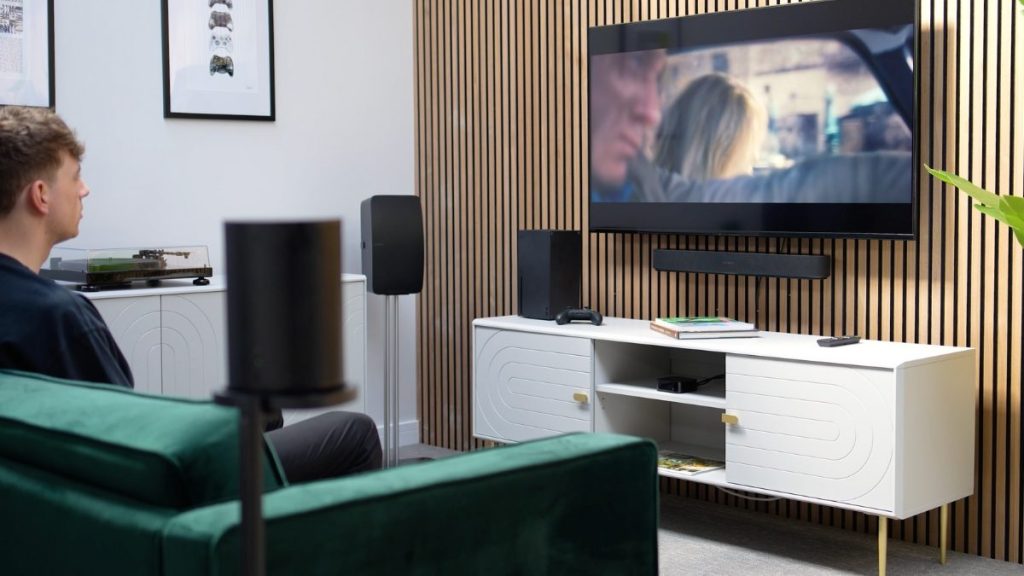
If rears are added to your Sonos home cinema, the Beam (Gen 2) will automatically adjust its audio output to stop using two of its arrays for surround sound audio and pass that duty over to your dedicated rear surround speakers. This frees up the processor in the Beam G2 to maximise height channel performance.
Sonos offers a great selection when it comes to rear surrounds, and the most popular option for adding an extra layer of immersion are the Sonos Era 100’s. Coming in at £498 a pair the Era 100's are compact, yet powerful speakers with a new acoustic architecture that enables stereo sound and rich bass.
If you’d like to take the immersion to another level, you can add a pair of Sonos Era 300’s instead, which are Sonos’ first ever upward-firing Dolby Atmos wireless speakers. These will come at the premium price of £898 a pair and may not be a necessity for most setups, but if you want unmatched immersion, this is the way to achieve it. You'll also benefit from our 6 Year Extended Warranty with any of these Sonos speakers when shopping with us as well as Free Delivery which is worth §considering.
| Other Sonos Rear Speaker options: Sonos One SL's Sonos Five's Ceiling Speakers In-Wall Speakers IKEA Symfonisk Range |
Note: To use in-wall or in-ceiling speakers, you will need a Sonos Amp to connect them wirelessly for a completely clutter free setup.
More: Adding Sonos Surround Speakers: How To Choose
More: Testing Every Sonos Beam (Gen 2) Home Cinema Setup
Sonos Beam (Gen 2) Additional Features
The Beam (Gen 2) is quick and easy to set up. Simply connect the power cord into the mains and the HDMI into your TV. Once connected, you will want to download the Sonos S2 app and follow the on-screen instructions to complete the setup. Once you’re finished, you can take your sonos speaker even further with the below features:
Voice Control
The Sonos Beam (Gen 2) features voice control built-in via Sonos Voice, Amazon Alexa and Google Assistant. Whether you want to turn the TV on and off, shuffle through your favourite tracks, or play your favourite podcast, you can do it all without lifting a finger. Of course, if voice assistants aren’t your thing, you can skip the setup process all together or simply mute the microphone for extra privacy.
Limitless Streaming
As well as being the perfect companion for your TV, the Beam (Gen 2) can also stream endless amounts of music, radio, podcasts, audiobooks and more straight to your speaker. You can stream directly from the Sonos S2 app or via the latest streaming platforms, like Spotify Connect and Apple AirPlay 2.
TruePlay Tuning
Sonos’ TruePlay Tuning is the quickest way to give your soundbar an instant boost. By using test tones to measure how sound reflects around the room, TruePlay fine-tunes your audio to the unique dimensions of your space and provides optimal performance. Unfortunately, you will need an iOS device in order to do it, but it’s definitely worth doing if you have access to a compatible device.
Speech Enhancement & Night Mode
The Sonos Beam (Gen 2) also features a speech enhancement feature to make vocals easier to hear and add an extra layer of clarity to the dialogue in your favourite films and shows.
If you enjoy late night watching, you’ll appreciate Sonos Beam (Gen 2)’s Night Mode. This essentially dampens the loudest parts of your audio and enhances the quieter tones to produce a more stable output. It’s the perfect solution if you’ve got neighbours nearby or just put the kids to bed.
Gaming Benefits
The Sonos Beam (Gen 2) is a great soundbar for gaming. With a wide range of codec support, more surround sound options are compatible, meaning that you can now play a variety of games in all of their glory. The faster processing chip also improves performance for gaming audio, while the dedicated 5 GHz Wi-Fi radio will minimise lag.
In our own tests, we found that the immersion and clarity of the Beam (Gen 2) were great when gaming. Its compact size makes it well-suited to smaller gaming TVs, and its expansive feature set make it a great option overall.
More: Top 10 Sonos Soundbar Tips (Ray, Beam & Arc)
sonos Soundbar ComparisonS

Sonos Beam (Gen 2) vs. Sonos Ray
Sonos’ entry-level and smallest soundbar, the Sonos Ray, is the perfect choice for secondary spaces in the home like a bedroom, office or gym.
Performance-wise, the Beam (Gen 2) is the bigger and better soundbar and delivers a much more immersive experience for those with smaller to medium sized rooms. If you can justify spending the extra budget, its a no brainer, the Beam (Gen 2) is the one for you.
That’s not to say the Ray isn’t worth it. It’s still one of the best entry-level soundbars on the market, and it will be a great upgrade from standard TV audio alone, especially if you’re looking to upgrade the rooms you don’t spend the most time in.
It’s versatile, can be recessed into a media unit with ease, and it’s a great wallet-friendly alternative to the Beam (Gen 2). So, if you’re the type of person who’s got a limited budget or a smaller space to work with, the Ray will definitely be worth considering.
It’s worth bearing in mind that the Sonos Ray doesn’t have voice control or support for Dolby Atmos. It can cope with 5.1 surround sound formats like Dolby Digital, but it must downmix it into stereo in order to play it.
More: Sonos Ray Review
Sonos Beam (Gen 2) vs. Sonos Arc
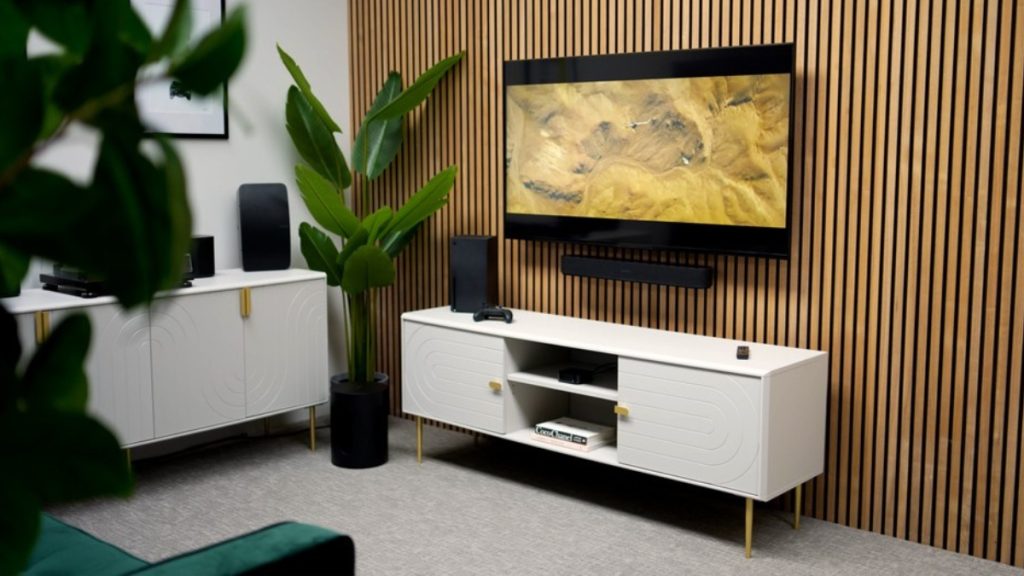
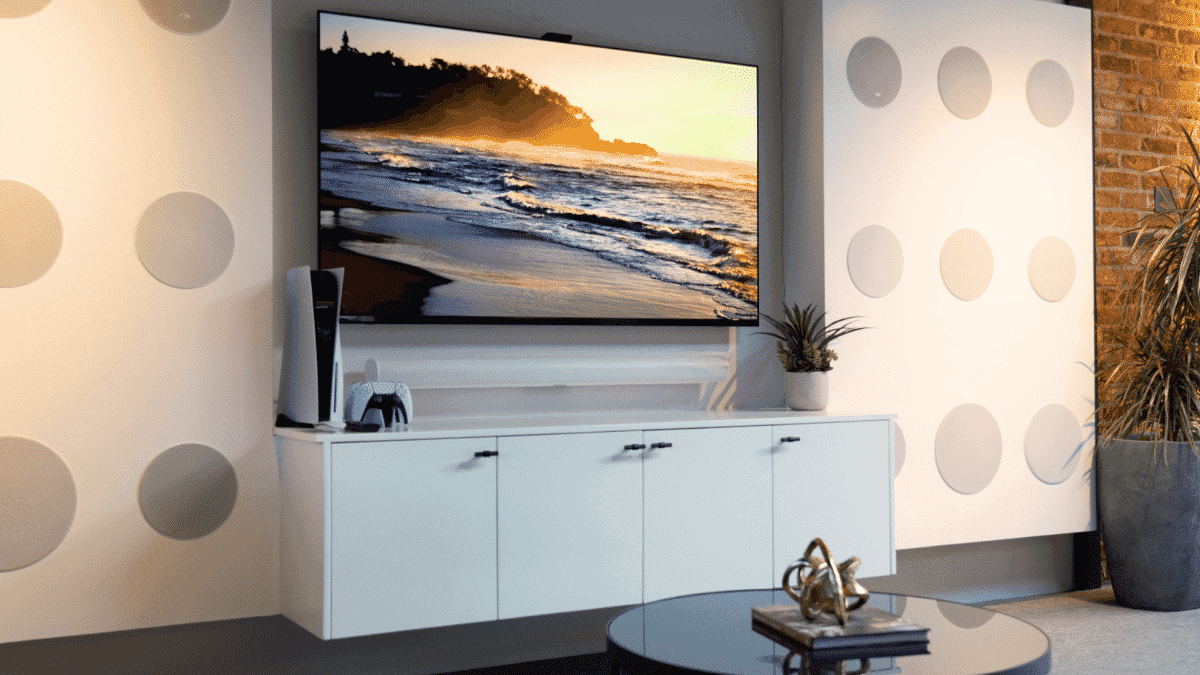
| Sonos Beam (Gen 2) | Sonos Arc (See Latest Deals) | |
|---|---|---|
| Price | £499 | £899 |
| Dolby Digital | ✅ | ✅ |
| Dolby Atmos | ✅ | ✅ |
| HDMI ARC Support | ✅ | ✅ |
| HDMI eARC Support | ✅ | ✅ |
| Number of Speaker Drivers | 5 | 11 |
| Upward-Firing Drivers | ❌ | ✅ |
| Recommended TV Screen Size | 55" and below | 55" and above |
The Sonos Arc is Sonos’ flagship and best-selling soundbar, and it's undoubtedly one of the most immersive soundbar options currently available on the market. The Arc is bigger, broader and a better package all-round. However, as is expected with a step up in performance, you will also notice a step up in price.
Featuring an 11-speaker array, this soundbar is a serial award-winner and delivers near-complete home cinema surround sound from a standalone speaker. Dedicated upward, sideways and front-firing drivers help to deliver exceptional three-dimensional Dolby Atmos surround sound with a wider soundstage than any other soundbar in the Sonos range.
The Beam isn’t a slouch with Dolby Atmos content, but its virtual psychoacoustic technology struggles to match the immersion levels of the Sonos Arc with its dedicated height channels. The Beam does offer exceptionally detailed and room-filling audio that’s hard to beat at its price point, but due to its smaller size, it can’t match the broadness or power of its much larger peer.
Other than the obvious differences in form, these soundbars do feature a range of similarities too, including Apple Airplay 2 and Voice Control capabilities via Amazon Alexa, Google Assistant & Sonos Voice.
More: Sonos Soundbar Buying Guide
Sonos Beam vs. Sonos Beam (Gen 2)
As one of the most popular soundbars under £500, there wasn't a great deal wrong with the original Sonos Beam. However, it wasn’t perfect and the Beam (Gen 2) has simply taken some learnings from the original Beam's failures and enhanced its best features to ensure its compact acoustic architecture performs even better.
No, the original Beam isn’t a bad piece of tech; it just lacks the modern edge needed to be a success in today's market. As expected, with more innovative technology under the hood, the Beam (Gen 2) is capable of creating a more immersive three-dimensional soundstage that will add extra layers to your listening experience regardless of what you're watching.
Other Sonos Beam (Gen 2) Comparisons
At Smart Home Sounds, we don’t take soundbar testing lightly. So, in order to really understand if the Sonos Beam (Gen 2) is right for you, we’ve also put it head to head with some of the best options from other brands like Bose and Sennheiser on our YouTube channel.
Watch: Bose 600 vs. Sonos Beam (Gen 2): The Best £500 Soundbar?
Watch: Sennheiser Ambeo Mini Review | Sonos Beam Killer?
Watch: Bose 300 vs. Sonos Beam (Gen 2): Battle of the Compact Soundbars
Should We Expect A Sonos Beam (Gen 3) in 2024?
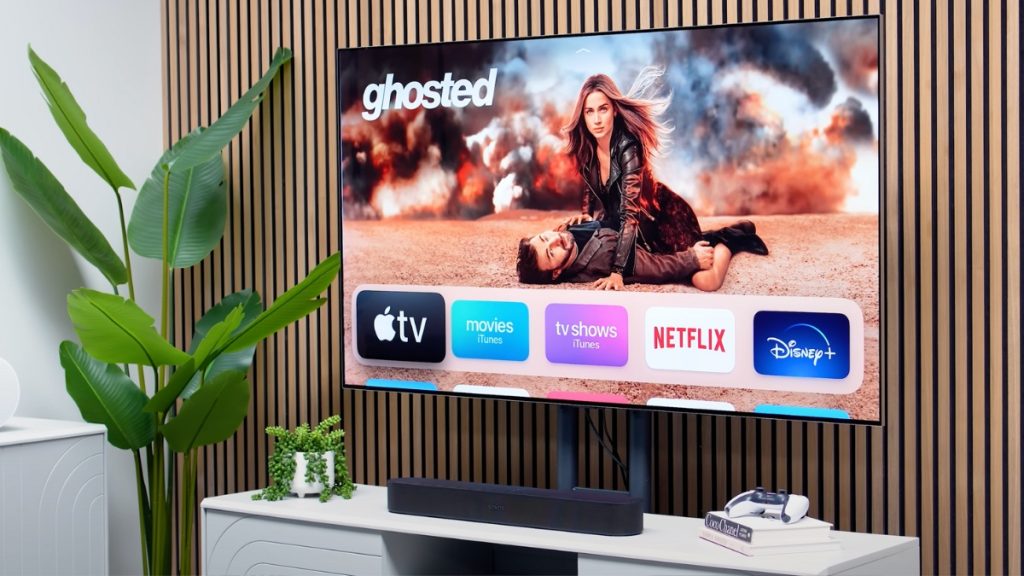
Disclaimer: Anything mentioned here is purely speculation and doesn’t represent what we’re going to see from Sonos in 2024.
Despite getting an upgrade in 2021, following the successful launches of the Sonos Era 100, Era 300 and Sonos Move 2 in 2023, it begs the question: could Sonos’ class-leading compact soundbar get a trilogy?
Unfortunately, although there’s a clear sense that Sonos may be shifting their style slightly with their latest releases, the Beam (Gen 2) is still too young in its lifecycle to warrant a full-scale upgrade in our opinion.
The original Beam lasted a good four years before getting a refresh, and with so little coming close to the Beam (Gen 2) performance-wise at this pricepoint, its hard to imagine them rushing to make that change.
If anything, the Sonos Arc looks like the most likely soundbar of the trio to experience an upgrade, but even that doesn’t feel due anytime soon. If you’d like to find out more about the Arc, read our Sonos Arc Review: Is It Worth It in 2024 blog.
The jury’s still out at the minute, but the only thing we can say for certain is that at the moment, all three Sonos soundbars are more than capable of offering top-tier performance for their respective use cases, so right now seems like as good a time as any to get your hands on one of them.
Our Verdict: Is The Sonos Beam (Gen 2) Worth It?
The Sonos Beam (Gen 2) is more than capable of handling your TV's audio on its own, but it's even more comfortable in a wider Sonos home cinema. It’s the perfect entry point to the world of home cinema, which only improves with the addition of any of the brand’s subwoofers or rear surround speakers.
Admittedly, it would’ve been nice to have dedicated upward-firing drivers on this one. However, for the price you’re paying, its very hard to argue with this soundbar.
Despite being released back in 2021, the Beam (Gen 2) is still young at heart and If you’re looking for a brilliant all-rounder that is versatile enough to handle anything you throw at it, you’re in the right place. The Beam is still big enough to deliver your audio with serious power, but small enough to leave you astounded once you hear it (even 2 years on). If that’s not a good sign that it's here to stay, we’re not sure what is.
Other Useful Content
Video: Sonos Soundbar Buying Guide 2023: Spend Wisely!
Video: Sonos Arc vs Sonos Beam (Gen 2): Closer Than We Thought?
Video: Sonos Arc vs Beam (Gen 2) & Sub Mini: Which To Buy
Blog: Sonos Beam Gen 1 vs. Sonos Beam Gen 2: Is It Worth The Upgrade
Blog: Sonos Home Cinema: The Complete Setup Guide
We hope you find this helpful, but of course, we realise that purchasing a new soundbar is a big decision, so we are more than happy to assist with any queries you may have.
Please reach out on:
| info@smarthomesounds.co.uk | |
| Live Chat on our Website | |
| 0800 677 1100 |
Find out if Sonos’ multi-award-winning compact Dolby Atmos soundbar is right for your home.
Is The Sonos Move 2 A Worthwhile Upgrade?
The secret to a successful sequel is all in the execution. So, as a portable speaker billed with double the battery life, dual tweeters for stereo sound, expanded USB-C functionality and a refreshed design, there’s no doubt that the Sonos Move 2 is set to be a worthy upgrade on its predecessor. But, we will be uncovering whether it really warrants upgrading from the original Sonos Move (Gen 1) and if it's worth its more premium price tag of £449 throughout this review.
The original Sonos Move, which launched back in 2019, was a staple example of what we’d call a ‘hybrid portable speaker’ that was equally as comfortable playing music in the bedroom as it is in the garden. Sonos have since released the Sonos Roam and Roam SL which are more lightweight, portable speaker options and come with a more affordable price tag for those looking under the £200 price point.
The Move 2 sits in the middle ground between the range of Sonos portable speakers and Sonos wireless speakers, bringing blended functionality to perform impressively both indoors and out.
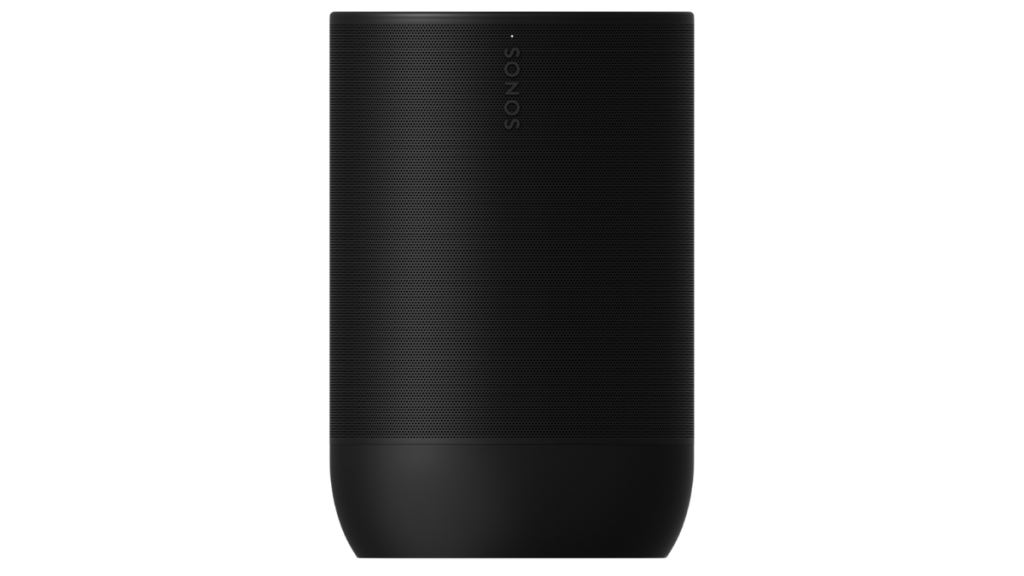
| Sonos Move 2 Price: £449 (See Latest Pricing) |
| Pros | Cons |
|---|---|
| ✅ Powerful stereo sound ✅ Brilliant battery life when playing & idle ✅ Impressive stereo sound and upgraded bass response ✅ WiFi 6 & Bluetooth 5.0 connectivity ✅ USB-C connectivity & power bank charging | ❌ No support for Google Assistant ❌ No Sonosnet ❌ Bluetooth disabled when used as rears |
Want to find out more? Watch our Sonos Move 2 Review: What Sonos Didn't Tell You... Again video on YouTube
Design
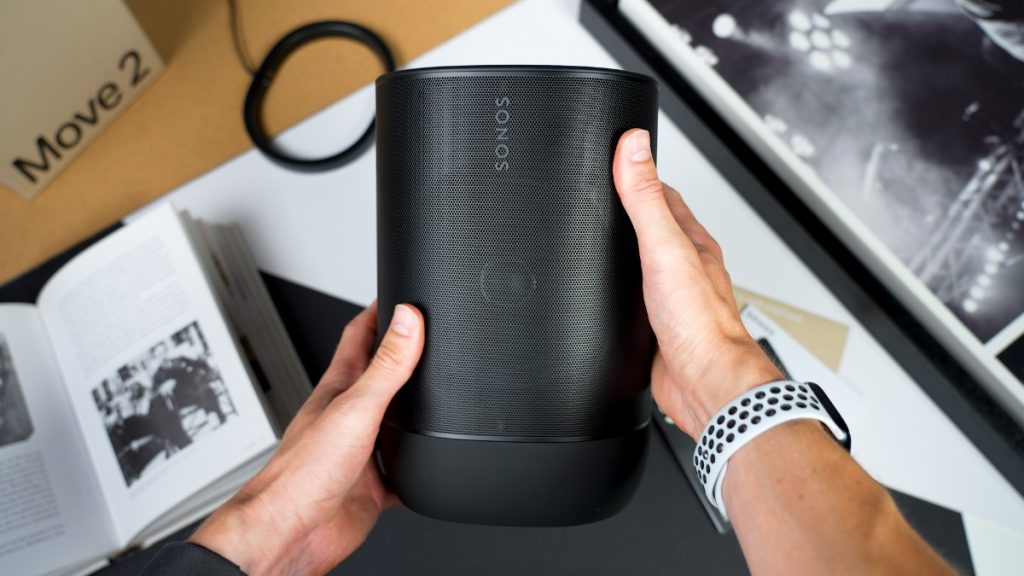
Side by side, you’d be forgiven for thinking there’s not a huge difference between the original Move and the Sonos Move 2. It’s still got all the same dimensions and weight, as well as the same silicone base, wraparound grille and integrated carry handle on the back. However, there have been a few reviews and revisions made that are worth pointing out.
Firstly, the Move 2 has experienced a slight colour change. Shifting away from the original ‘Lunar White’ (that was really more of an off-grey colour), the Move 2 now neatly matches the ‘Sonos White’ that we see on the rest of the wireless speakers in their lineup, which helps to make the speaker’s branding feel slightly more discreet.
Sonos has also released an ‘Olive Green’ model that will sit nicely alongside the standard black and white options to offer even more choice within the range to suit your style.
On the top panel, along with the usual touch controls, Sonos have also added the volume slider that was introduced with the Sonos Era products, as well as a speech bubble icon to turn off voice assistants. Alternatively, you can use the switch at the rear of the device to completely cut the power to the mics to ensure total privacy.

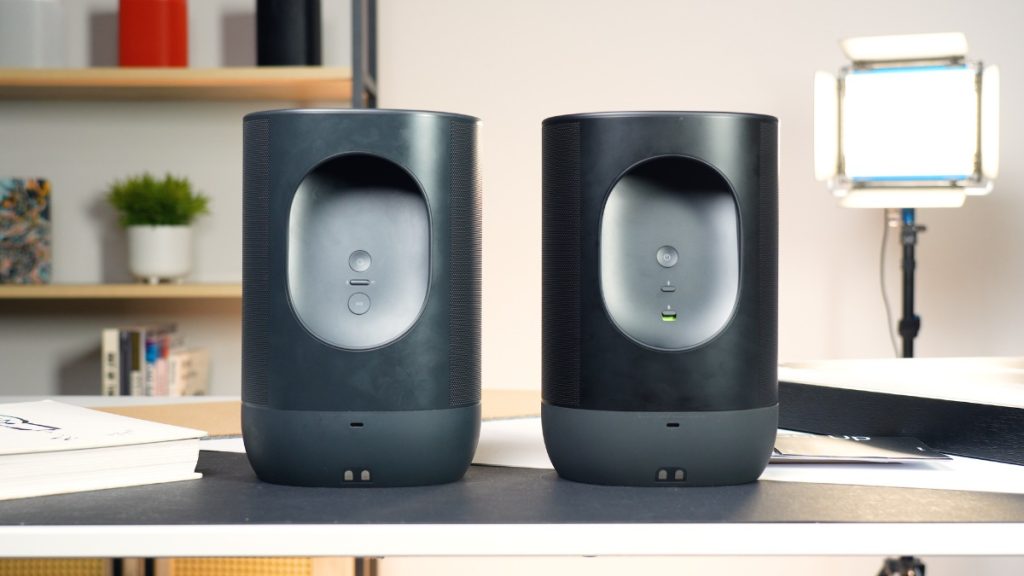
Along with the aesthetic and functional changes to the speaker itself, Sonos has also upgraded the Sonos Move charging base in order to improve general day to day usage.
The Move 2's new charging dock follows a pretty similar blueprint to the original charging base but instead features a smaller and detachable plug. It sounds like a small change, but the original Move plug wasn’t the easiest to fit behind a unit or bedside table and was always a bit bulky to throw into a bag, so it’s a welcome addition in our eyes.
Durability

Much like the original Sonos Move, the Move 2 hasn’t been designed as an out and out portable speaker. It is made from durable materials to withstand the inevitable knocks and drops we all experience on a day-to-day basis though.
We tested this out fully during our Sonos Move 2 Review on YouTube, and although we noticed some slight scuffs and scratches on the top edges of the speaker after some big drops, the metal grille and rubber base were left totally unscathed, which was a big plus.
In terms of the Move 2’s ability to withstand all weathers, we also tested its IP56 rating outside in a heavy rain shower. Just like its predecessor, the Move 2 performed really well, which is great news if you’re looking to take this speaker outdoors, especially in the British summertime.
Connectivity
The original Move already ticked a lot of boxes when it came to connectivity. However, the Move 2 now steps up to WiFi 6 and Bluetooth 5.0 connectivity for the best of both worlds when at home or out and about.
With Move 2, there’s still control via the Sonos S2 app, Spotify Connect and AirPlay 2 and we also have voice control options with both Amazon Alexa and Sonos Voice. However, Google Assistant isn’t available due to ongoing relationship issues between the two brands.
This won’t be ideal for those of you who have other Sonos speakers using Google Assistant, as you can only use Amazon Alexa or Sonos Voice control when you’re connected over WiFi. There’s also no functionality to use your voice to control your playback over Bluetooth just yet either, so that's something to bear in mind.
Now, just as with the Sonos Era products, there’s also no Sonosnet on the Move 2, but with Wi-Fi 6 and the rumours of Matter Thread in the future, we think you’ll be more than future-proofed connectivity-wise around the home.
Additional Features
The headline feature of the Sonos Move 2 is its enhanced battery life, making an already great companion for partying throughout your home, even better. For reference, the Move (Gen 1) launched with a battery life of 10 hours, which was later upgraded to 11 hours via a software update.
However, the Sonos Move 2 trumps this, benefitting from a more powerful battery, which is supposedly capable of up to 24 hours of playback when listening at moderate volumes, connected over Wi-Fi and with voice assistant enabled.
We put this to the test and found that Move 2 lasted 22 hours with those same parameters. It's worth noting that this was in our colder studio with the Wi-Fi power saving mode turned off. So, in a warmer environment with that mode turned on, we’d suggest the Move 2 would achieve the expected 24 hour battery life, if not exceed it.
We also checked the recharge time and found that a 2 hour charge restores you to 100 percent, which was better than we initially expected. Unfortunately, there’s no quick charge feature on this model, which would’ve been a nice plus, but overall, we’ve been happy with the performance.
An additional plus for the Move 2 is its power bank charging capabilities via the USB-C port, meaning you can charge a phone or smart device when on the go. In our testing, we charged a phone for two hours and it gained 66% battery during that same timeframe, the Move 2 lost 18% battery. Its worth noting the Move wasn't playing music during this period, so we’d expect it to lose more if this were the case.
The other USB-C upgrade for the Move 2 is that you can now use this as a line-in to connect up a turntable, computer or other audio source. However, you will need to get your hands on an additional Sonos Line-In Adapter to do so.
We've tried other USB-C adapters but haven’t found one that works yet. Previously, if you wanted to use your Move to connect to a turntable, you would have needed to use Bluetooth, so this new functionality gives you much more versatility, and we can see this being a popular option for bringing vinyl into your Sonos ecosystem.
This is a great use case for this speaker, in our opinion and from testing it out via Bluetooth, it’s safe to say it worked really well with no delay whatsoever. It’s worth knowing that this did disable the mic on the Move for Zoom calls, which could be a problem if you use these often.
The new Move 2 is also set to be 40% more energy efficient than the original, and in our testing, we found this to be true with the below results.
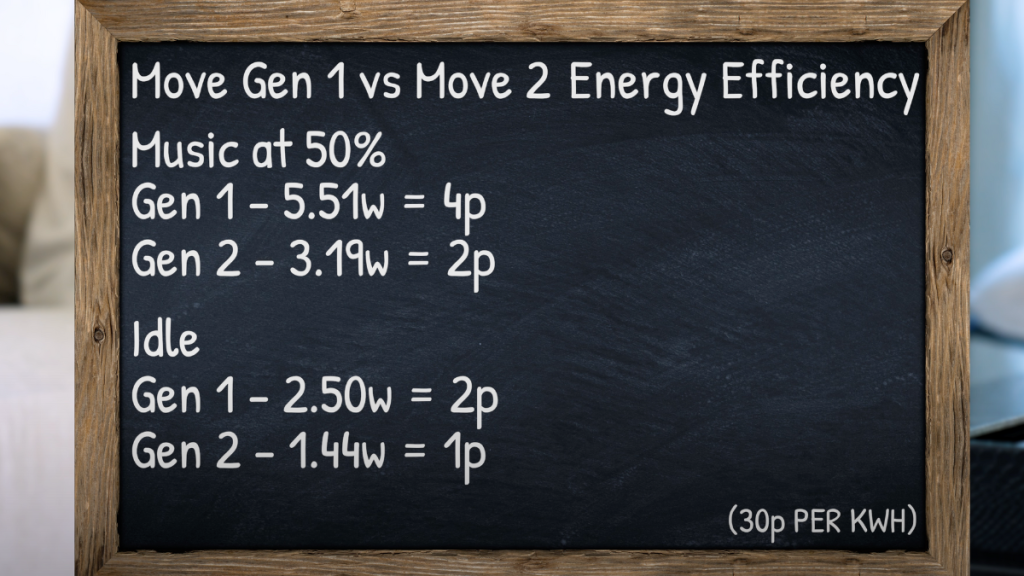
Internals
Internally, the Sonos Move 2 has undergone a full-scale refresh in order to deliver stereo sound. Featuring three Class-D amplifiers powering dual tweeters and a mid-bass woofer, this new-look speaker offers a completely different performance from the mono Sonos Move 1 which offers a single tweeter and single woofer.
Sonos have also added custom waveguides to the Move 2, which have been optimally designed to control both the direction and dispersion of frequencies to give us a wider and more balanced soundstage.
Sound Performance

| ✅ Well balanced, powerful sound performance ✅ Wider stereo soundstage ✅ Impressive details and track separation ✅ Improved mid-bass performance |
In signature Sonos style, the Move 2 is an impressively balanced unit that's more than powerful enough to fill a decent-sized space and pack a punch when you’re outside too.
The dual tweeter configuration helps to effortlessly distribute a wider and bigger sound than its predecessor. The vocals feel more open and projected, and they come through tracks cleaner and with more prominence.
We’ve been really impressed with the details of the stereo sound presentation, and we’ve found the separation between the layers of tracks to be great too.
Of course, choosing to stereo pair two Sonos Move 2s will deliver an even more accurate stereo sound performance and take the soundstage width to another level. But we think you’ll be more than happy with this speaker's performance as a standalone unit too.
Sonos Move vs. Sonos Move 2 - Which Portable Speaker Is Better?
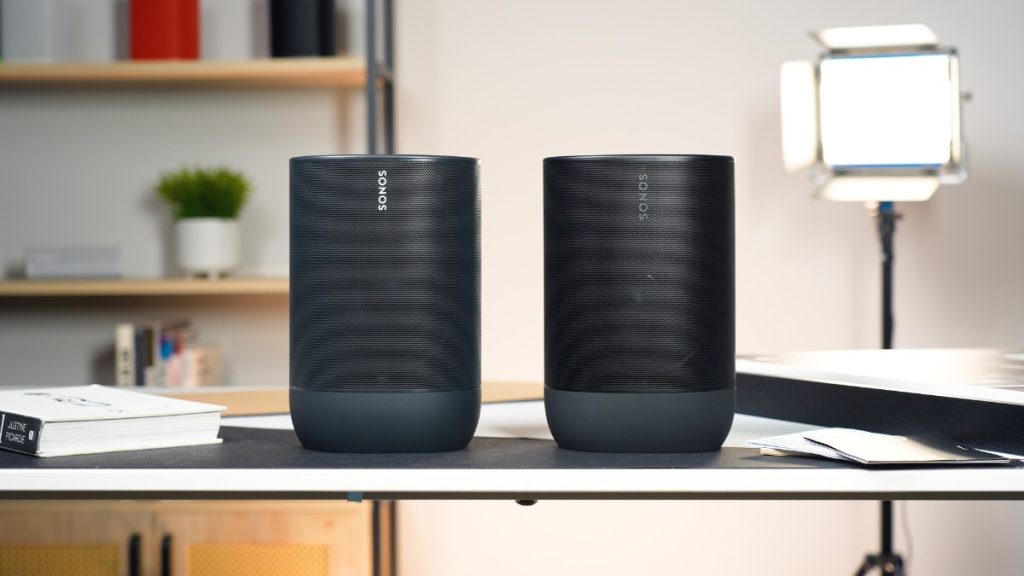
After numerous hours spent listening side-by-side to a variety of different tracks and genres of music, there’s no doubt that the Sonos Move 2 is a significant upgrade on its predecessor.
Catching us well and truly off guard, we‘ve been pleasantly surprised by the bass performance of this new-look portable. Given both the original Move and the Sonos Move 2 have a single woofer (and there haven't been any mentions of upgrades in this department), we weren’t expecting any difference here. However, it definitely feels like there's a better mid-bass performance on the Sonos Move 2.
The bass output on both Moves is punchy and powerful, but it feels tighter on Move 2 and the extra mid-bass almost gives an extra layer to tracks that makes the overall performance feel even more impressive.
Unfortunately, as we found with the Sonos Move 1, the bass output does seem to get clipped at higher volumes. The low end still sounds great at around 75% volume, but once we push past that 80% mark, there is slight clipping in the performance. We think the bass will still be enough to satisfy the majority of you, but it's something to bear in mind nonetheless.
So, should you upgrade from your original Sonos Move? Our initial thought is no. I don’t think there’s a big enough jump in performance to warrant an upgrade here, and I still think the Move (Gen 1) offers a great experience and sounds great too.
However, if you think that the Move 2 ticks a big box for you, such as the USB-C line-in functionality, then you might want to add one to your home, and you could always look to sell your older generation Sonos Move on.
Given how much we like to use the Move away from the dock, having double the battery life with the Move 2 is a big plus for us and would be what tempts us.
Sonos Move 2 vs. Sonos Era 100 vs. Sonos Era 300
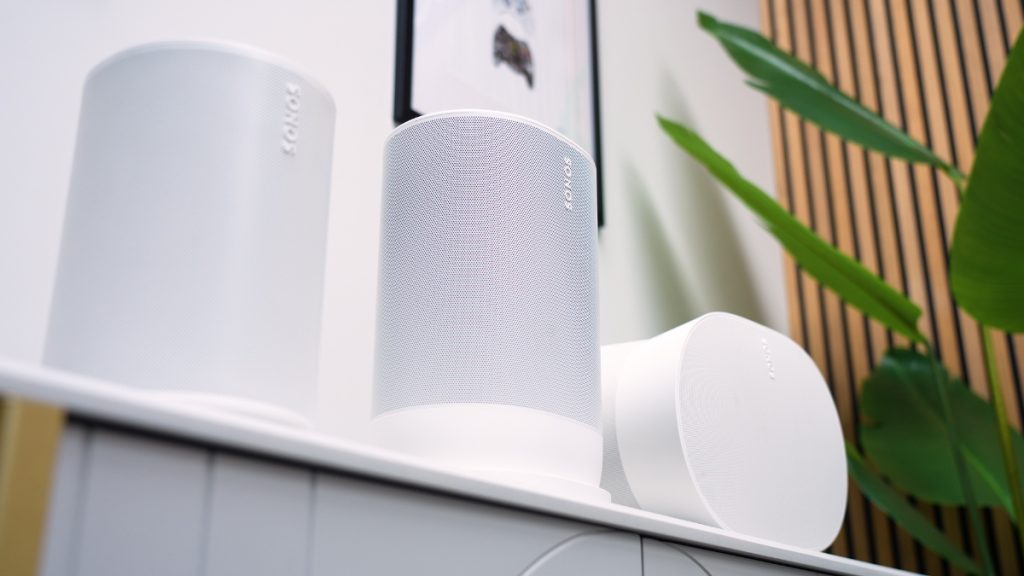
The Sonos Move 2 sits right in the middle of the Sonos Era 100 and Era 300, and you could argue it's almost the perfect ‘Era 200’ when it comes to sound performance.
There’s a step up in performance when it comes to power and bass from Era 100 to Move 2, and then another step up again when it comes to Era 300, which offers a far wider and more room filling sound.
The Move 2 is £200 more expensive than the Era 100, and we would say it’s around £100 better in terms of sound performance, so you’re paying a £100 premium there for portability, which makes sense.
The Era 300 is also £449, so you have to weigh up if you want a more premium sound performance and the ability to experience spatial audio with the Era 300 or if you’ll get more for your money with a speaker that you can move around and make the most of in multiple rooms of your home, as well as take away with you for the weekend.
Watch our dedicated Sonos Era 100 Review and Sonos Era 300 Review on YouTube.
Our Verdict - Is THe Sonos Move 2 Worth It?
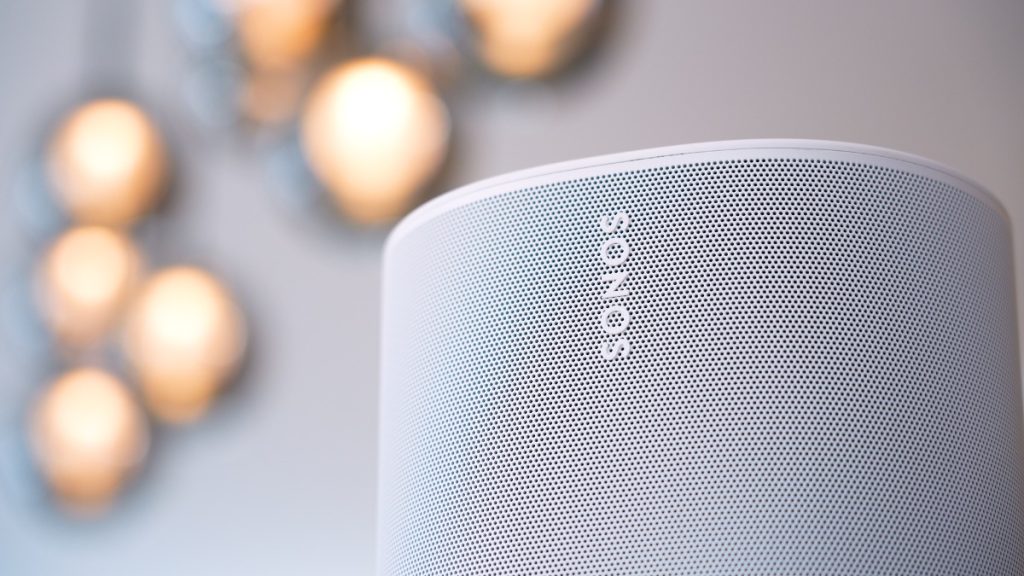
Offering some promising upgrades over its predecessor, this portable addition to your Sonos home is jam-packed with the latest functionality and provides impressive, powerful sound performance to match. So, if you’re in the market for a speaker that is equally comfortable around the home as it is in the garden, then the Sonos Move 2 is going to be a great option for you.
Is it worth £449? Well, that’s still up for debate. But if you were happy with the price tag of the original Move, which retailed at £399, then it’s definitely worth the additional £50 upgrade. However, if you’re the type of person who thought the Gen 1 version was a little pricey, then chances are you’ll have similar thoughts about this one.
If you put it into the context of the Sonos Era 100, although it’s a step up in price, it's also a step up in performance and because of the added portability, you’ll reap the benefits of having a (more powerful) Era 100 in your bedroom, bathroom, kitchen and garden.
Of course, Move 2 isn’t going to be for everyone. You are paying a premium for the Sonos ecosystem, and if you’re not already invested in it, you may be better served with a different heavy duty portable speaker option such as the JBL Xtreme 3 or Marshall Middleton.
There will be some of you out there who might not be as bothered by portability and would rather spend £449 on an Era 300 and benefit from a superior sound experience.
Ultimately, this speaker is for those who have been waiting for Sonos’ premium portable speaker to tick certain boxes or for new Sonos users looking to take the plunge in a way that gives Sonos sound in multiple areas of their home without needing to fork out for 4 or 5 speakers at once.
Sonos MOVE 2 FAQ's
Can you stereo pair the Sonos Move 2 with a Sonos Move (Gen 1)?
While you can group the Sonos Move 2 with the Sonos Move (Gen 1), you won’t be able to make a dedicated stereo pair as one of the speakers is mono and the other is stereo.
Can you use a pair of Sonos Move 2s as rear speakers in a Sonos Home Cinema?
Unfortunately, you cannot use a pair of Sonos Move 2 speakers as rear speakers in a Sonos Home cinema. Sonos has said this is because you could take one away and it would cause issues with the setup, but our gut feeling is that they’d prefer to sell you a set of speakers as rears, such as the Era 100s or 300s, and then sell you another speaker for use as a portable Sonos speaker.
Can you add a subwoofer?
You can’t add either the Sonos Sub Mini or Sonos Sub (Gen 3) with the Sonos Move 2. Again, Sonos has said this is because you could take your Move out of the room, which would then cause connectivity issues and break the bond between the two products.
Can you stereo pair Sonos Move 2s over Bluetooth?
No, you can’t stereo pair two Sonos Move 2 speakers over Bluetooth. You must be connected to Wi-Fi to use a pair of Move 2s in a stereo pair; however, as long as you’re at home and connected to Wi-Fi you can then send audio via Bluetooth, which can then also be sent to any other Sonos speakers in your network.
Other uSeful Content
Video: Sonos Move 2 Announced: First Impressions
Video: Sonos Move: What Sonos Didn't Tell You (In-Depth Review)
Blog: Sonos Move 2 First Look: Launching 20th September for £449
Blog: Sonos New Products 2023: Sonos News
We hope you find this helpful, but if you have any more questions we are more than happy to assist with any queries you may have.
Please reach out on:
| info@smarthomesounds.co.uk | |
| Live Chat on our Website | |
| 0800 677 1100 |
Find out if Sonos’ second-generation portable Bluetooth speaker is the right choice for you.
Sonos Move 2 Announced: New Premium Portable Speaker
After a number of leaks and rumours, Sonos have finally announced their latest wireless speaker. The new Sonos Move 2 portable speaker is the second generation of the Sonos Move and brings a number of upgrades, including a 24 hour battery life, stereo sound, a refreshed design and USB-C line-in functionality.
This release comes 4 years after the launch of the original Move back in 2019, which is one of our favourite Sonos products and was Sonos’ first venture into the portable speaker market.
The Sonos Move paved the way for a new category of premium, heavy duty portable speakers designed to move around the home and out into the garden. This new update brings Move in line with more recent product launches from Sonos, most notably the new Sonos Era 100 and Era 300, which launched in early 2023.
Want more? Watch our Sonos Move 2 Announced: First Impressions video over on YouTube!
Sonos Move 2 Price And Launch Date
The new Sonos Move 2 will launch with an RRP of £449, a £50 increase on the original Move. With a new set of features and anticipated upgraded sound performance, we will be putting it to the test in our upcoming review to see if it’s worth the step up in price.
The Sonos Move 2 is set to launch on the 20th September 2023, and will be available to pre-order soon with our usual 6 Year Extended Sonos Warranty and 30 days returns policy.
Sonos Move 2 vs. Sonos Move: what's New?
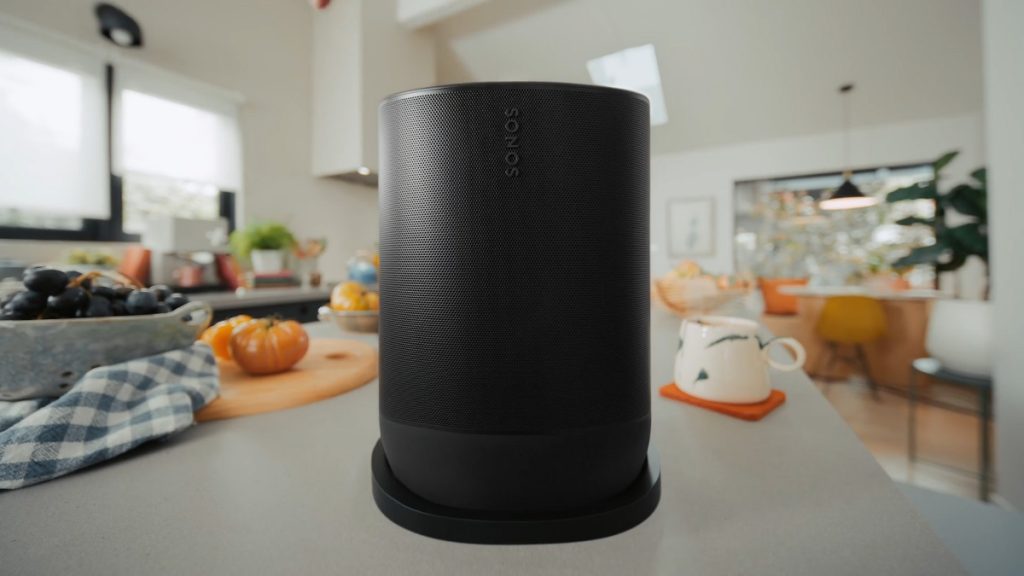
| Sonos Move | Sonos Move 2 | |
|---|---|---|
| Price | £399 (See Latest Pricing) | £449 (See Latest Pricing) |
| Audio | Mono | Stereo |
| Battery | Up to 11 hours of playback | Up to 24 hours of playback |
| Connectivity | Wi-Fi + Bluetooth 4.1 | Wi-Fi 6 + Bluetooth 5.0 |
| Durability | IP56 (water resistant) | IP56 (water resistant) |
| TruePlay Tuning | Automatic TruePlay | Automatic TruePlay |
| USB-C Line-in | ❌ | ✅ (with Sonos adapter) |
| Touch Controls | ✅ | ✅ Refreshed Touch Controls |
| Can Be Used As A Powerbank | ❌ | ✅ |
Sonos Move 2 Design: Refreshed appearance
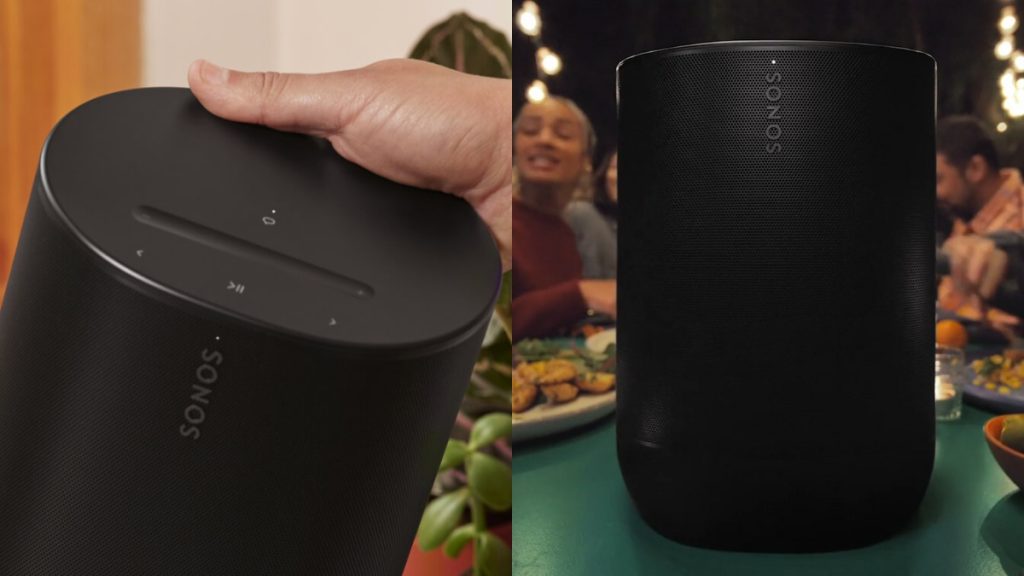
The Sonos Move 2 looks very similar to the original Move, and in terms of shape, size, and weight, everything will stay the same. But there have been a few changes to highlight.
Firstly, the Move 2 will be available in three new colourways. A new Black version will feature more discreet branding with a matching black logo, while the White Move 2 steps away from the more grey-toned “Lunar White”. Finally, there is now an Olive green colourway available for those looking to bring the outdoors in.
On the top, Move 2 now features a newly redesigned top panel and is very similar to the new Era 100 Sonos speaker with a volume slider and speech bubble icon on the top to activate or deactivate your voice assistant. There is also a new far-field microphone array on top, which uses something called advanced beamforming and multichannel echo cancellation to hear you better and quicker when using voice assistants.
As a portable speaker, there needs to be an element of durability factored into the design, and the Move is made from shock absorbing materials to withstand a few knocks or drops. Like the original Move, Move 2 is IP56 rated making it water resistant and suitable for taking outdoors in most weather conditions. It would have been nice to see them upgrade that to an IP67 rating like we’ve got on the Roam to give a bit more protection from the weather, but given the use-case of the Move, IP56 should be weather-proof enough.
Sonos have also redesigned the charging base, which also features a smaller, detachable plug. While a small change in the grand scheme of things, this updated design will make it easier to fit the plug behind a bedside table or unit and easier to chuck in a bag.
Sonos Move 2 Spec: Upgraded SOund Performance
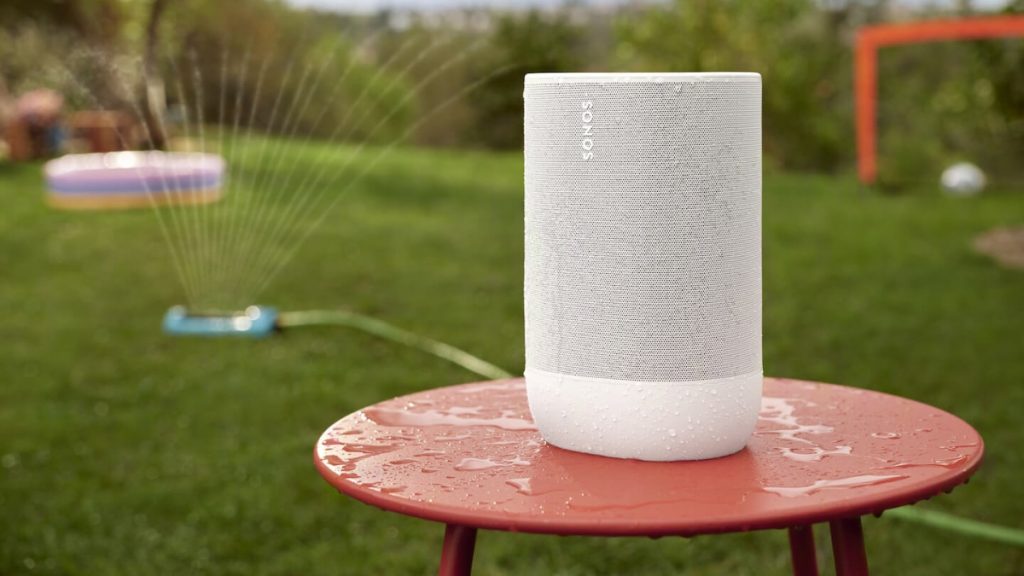
Onto the best part—the sound. Sonos have completely overhauled the internals of Move 2 for an all new acoustic architecture. The main difference is that the new Move 2 is a stereo speaker rather than mono like the Move (Gen 1).
Inside, we’ve got three class-D digital amplifiers powering two angled tweeters and one midwoofer. The dual angled tweeters should give us those nice, accurate high frequencies and crisp vocals and also provide a more spacious stereo sound, separating highs and vocal frequencies into left and right channels. The mid-woofer as far as we can see hasn’t changed from the first generation Move, so we’re expecting a similar bass performance, but we’ll test that out in our upcoming review.
Sonos have also said that there are custom waveguides to finely control the direction and dispersion of frequencies to give us a wider and more balanced soundstage.
The acoustic makeover Move 2 has received is similar to that of the Era 100 (minus the upgraded woofer size), which definitely gives a wider sound with better separation compared with the previous Sonos One (Gen 2), so we’re really looking forward to testing it out in our studio. We'll be comparing the new Move 2 with the original Move as well as other speakers in the Sonos lineup, including the Era 100 and Era 300 and the larger Sonos Five.
Can You Stereo Pair 2x SOnos Move 2's
While a single Sonos Move 2 will now deliver stereo sound, you can also choose to pair two Move 2 speakers to create a stereo pair, which will give you a much wider soundstage. As with Move (Gen 1), this will still only be possible over Wi-Fi, which we know a lot of people will find frustrating and something we were hoping would be brought to Bluetooth.
Sonos Move 2 Features: Added Functionality
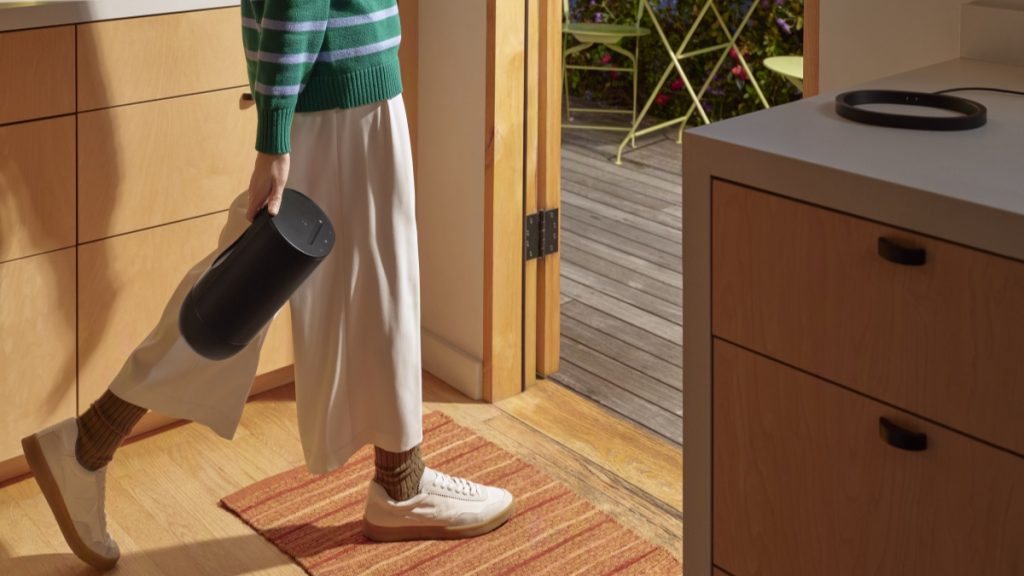
Updated Connectivity
Connectivity-wise, we still have Wi-Fi and Bluetooth for the best of both worlds when connecting at home or on the go. However, we step up to Wi-Fi 6 and Bluetooth 5.0 on the new Move 2. It still offers the usual options of Spotify Connect, AirPlay 2, and voice control via Sonos voice control or Amazon Alexa, but due to ongoing problems with Google, there won’t be Google Assistant available.
We are also presuming that the Sonos Move 2 will follow on from the Era products and also say goodbye to Sonos Mesh, though we are yet to confirm this.
USB-C Compatibility & Device Charging
Like the previous Move, the USB-C can be used for charging; however, it now offers extra connectivity and functionality. First things first, like the Era 100 and Era 300, you can purchase a Sonos Adapter to connect up to a turntable, computer, or another audio source, which will be a huge plus for a lot of Sonos users.
Previously, if you wanted to connect to a turntable with the Move, you would have needed to connect via Bluetooth to a Bluetooth turntable, so this should give a lot more flexibility.
Secondly, the USB-C port will now enable you to charge your phone on the go, acting as an on the go powerbank. It’s not clear how much this will affect battery life yet, but we will be testing this in our upcoming review.
Battery Life
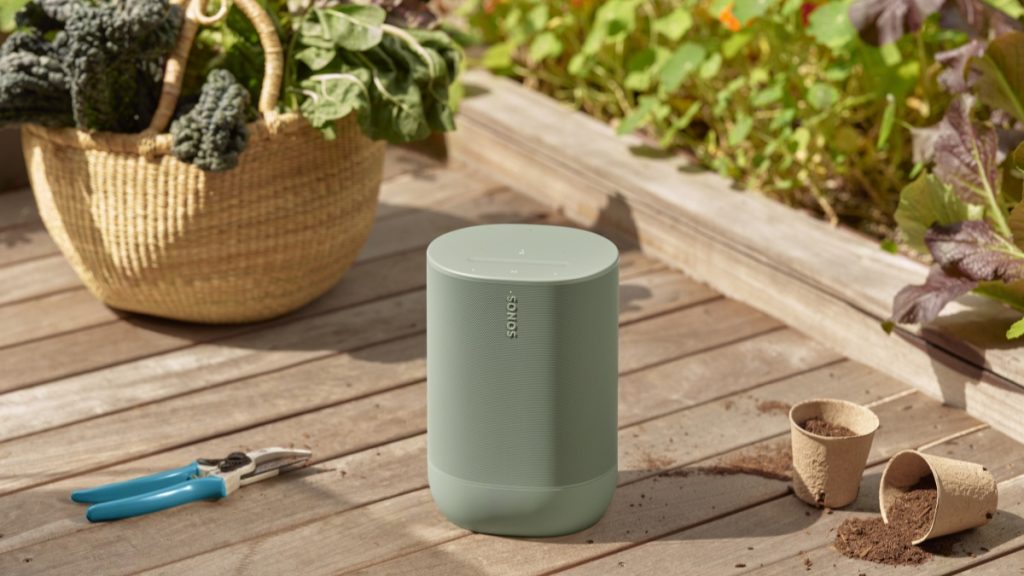
As a portable speaker, one of the biggest features is the battery life. The previous Move offered 11 hours, which is okay but fell behind a lot of competitors in this market. Sonos have since upgraded the battery in Move 2 from 18Wh to 44Wh and nearly doubled the battery life with up to 24 hours of playback when used continuously at a moderate volume while connected to Wi-Fi and with voice control enabled. Sonos haven’t shared the recharge time yet, and there’s no news on any quick charging feature, which is something we would have liked to see on this new update.
We have asked Sonos what the battery life will be like when the Move isn’t playing and were told that when it powers fully off, it should last months. When in its more responsive “Sleep Mode”, Sonos said it’ll last a few weeks, but again, this is something we need to test out. It’s also worth noting that the battery in the Move 2 is replaceable and can be swapped by the end user.
Automatic TruePlay Tuning
Move 2 offers Automatic TruePlay Tuning, the same as Move (Gen 1), which is clever technology that continually optimises the sound performance for your surroundings. The Move 2 uses its internal mics to measure the frequency response of the music in response to its surroundings.
Sonos have said that tuning will happen around every 60 seconds on Move 2, so you should always be getting the best sound for your environment. It’s not clear whether there have been any changes here with the new move, so again, this is something we need to test.
Sonos Move 2 FAQs
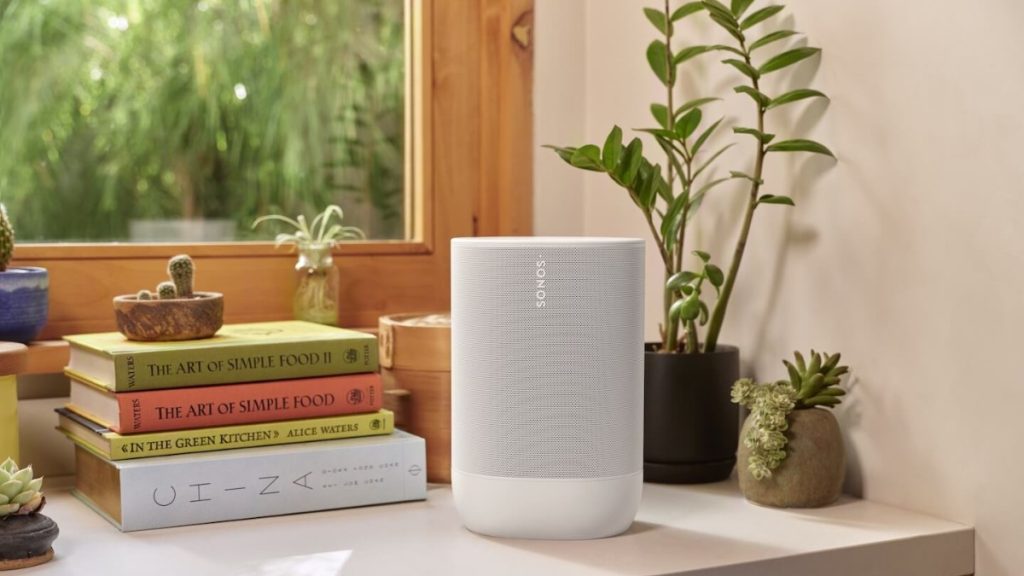
Can you pair a Move (Gen 1) with a Move 2?
You will be unable to stereo pair a Move 2 with a Move (Gen 1). This is due to the fact that one speaker would be mono and one would be stereo, which would give an unbalanced sound performance.
Can you use 2 x Sonos Move 2 as rear surround sounds to a Sonos soundbar?
You cannot use a pair of Move 2 speakers as rear speakers for a Sonos soundbar. Your options for rear surrounds are the Sonos One SL, Era 100, Era 300, or Sonos Five.
Can you add a Sonos subwoofer to the Move 2?
Unfortunately, you are unable to pair a Sonos subwoofer, either the Sonos Sub (Gen 3) or Sonos Sub Mini, with the Sonos Move 2.
Sonos Move 2 Initial Impressions
We have a lot of questions around the Sonos Move 2, but from our initial experiences, we think the changes Sonos have made will make this a much more attractive offer to a lot of people. Move 2 ticks a lot more boxes and should be a step up both in terms of sound performance and features. But what I want to know is, have they done enough to convince me to upgrade from my Move (Gen 1)? And is it worth that £449 price tag? Stay tuned for our upcoming review to find out.
For more information about the Sonos Move 2 or any other Sonos products, get in touch and one of our Tech Guides would be happy to help!
| info@smarthomesounds.co.uk | |
| Live Chat on our Website | |
| 0800 677 1100 |
Find out everything you need to know about Sonos’ new second-generation portable speaker set to launch on the 20th September for £449!
Is the Sonos Era 300 Better Than the Sonos Five?
| Strengths | Strengths |
| ✅ Immersive, Dolby Atmos sound | ✅ Impressive bass performance |
| ✅ Bluetooth 5.0 connectivity | ✅ Powerful sound performance. |
| ✅ Can be used as upwards firing rears | ✅ Direct 3.5mm Line-In |
| Weaknesses | Weaknesses |
| ❌ Can't be placed in a media unit | ❌ Overpowering in certain spaces |
| ❌ Divisive design | ❌ No Bluetooth connectivity |
Sonos has a history of delivering impressive wireless speakers to suit almost any situation and budget. However, with just £100 between Sonos' most premium offerings, is the Sonos Era 300 or the Sonos Five right for your home?
The Sonos Five has been around for a while now, and it sits at the top of the Sonos lineup as their most premium wireless speaker option. With a dedicated 3.5mm line-in and by far the biggest and most room-filling sound out of the Sonos collection, this more traditional speaker has definitely asserted itself as the powerhouse in the Sonos lineup. For more information about our other Sonos speaker recommendations, check out our complete Best Sonos Speakers to Buy guide.
The Sonos Era 300, on the other hand, specialises in delivering Dolby Atmos and Spatial Audio. This smart speaker offers a unique listening experience with drivers custom-built to fire sound to the front, sides, and upwards. Sitting just below the Sonos Five in the lineup, what it doesn’t offer in power, it makes up for in immersion. Check out our full Sonos Era 300 Review on YouTube if you'd like to go further in-depth.
Both of these speakers can be used standalone, as a stereo pair, or as rears to a Sonos soundbar, and of course, they can be grouped with any other Sonos speakers you have around your home to form part of a wider ecosystem or multi-room setup.
A little pushed for time? Watch our Sonos Five Vs Era 300: Clash of the Titans video over on YouTube instead!
Why buy from Smart Home Sounds?
We offer FREE 6 year extended warranty on all Sonos Products, 30 Day Extended returns and Free Next Day Delivery*. Looking for more personal advice? Contact our team of experts today.
Sonos Era 300 Vs Sonos Five: Design
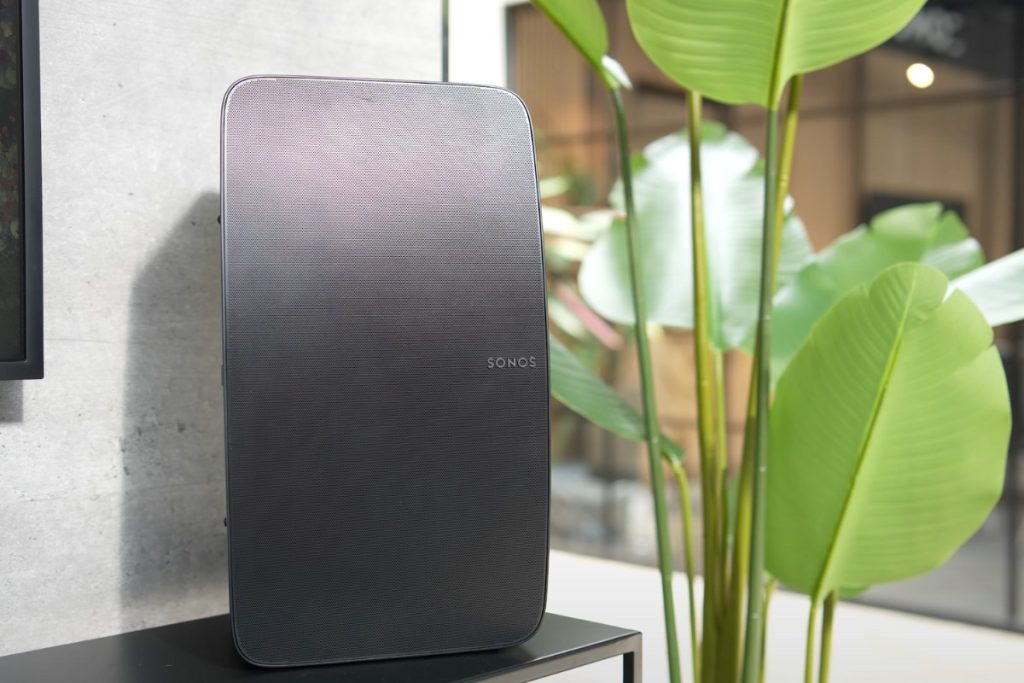
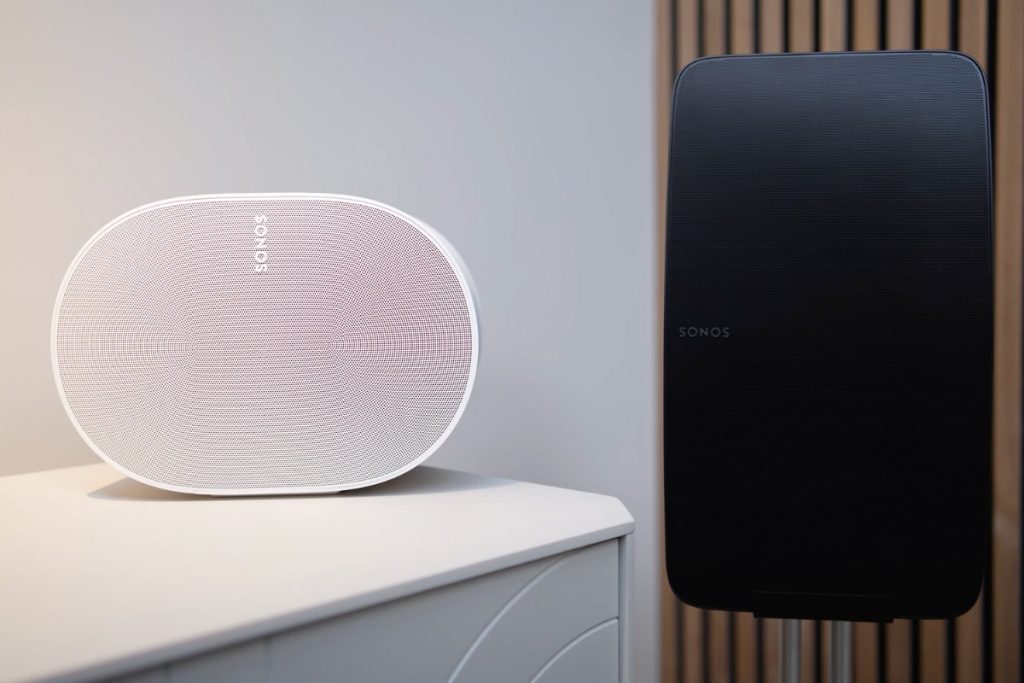

Side by side, you don’t need to be a genius to figure out that these two speakers don’t just sound different, but they look very different too.
Both speakers are available in black or white, but the Sonos Era 300 is a completely new take on the wireless speakers we’ve seen from Sonos in the past. Although the design might be a little divisive, it's definitely grown on us since its release earlier this year.
There are some really nice design features that Sonos has brought to the table with this next-gen Sonos design, like an enhanced volume slider and a modified power cable for ease of use, but it hasn’t moved too far away from the signature Sonos styling of recent years.
The Sonos Five has a little less flair than the Era 300. But, considering it still features a similar design to the original Play:5 which was released back in 2009, you could say it’s a design that’s aged extremely well.
The Five is considerably bigger than the Era 300, so you will need to think about the space needed to accommodate one of these (or two if you’re thinking about getting a stereo pair).
The Sonos Five isn’t quite the feature piece that the Era 300 is, but it’s a more traditional take on a Sonos speaker, and for some people, this will definitely have appeal.
One thing to bear in mind is the placement of these speakers. The Era 300 has drivers that fire sound in multiple directions, so you do need to leave space around the speaker to make sure you’re not blocking any of the drivers.
For example, you would sacrifice performance by placing an Era 300 in a bookshelf. The Five, while larger and possibly less practical, could be placed inside a bookshelf without impacting performance, so again, something else to consider.
Sonos Era 300 Vs Sonos Five: Internals
Sonos Era 300:
Featuring a total of six drivers made up of two sideways firing woofers, two sideways firing tweeters, one up firing tweeter, and one front facing tweeter, all powered by six Class-D amplifiers, the Sonos Era 300 has been designed to deliver a truly room-filling audio experience that fully immerses its listeners.
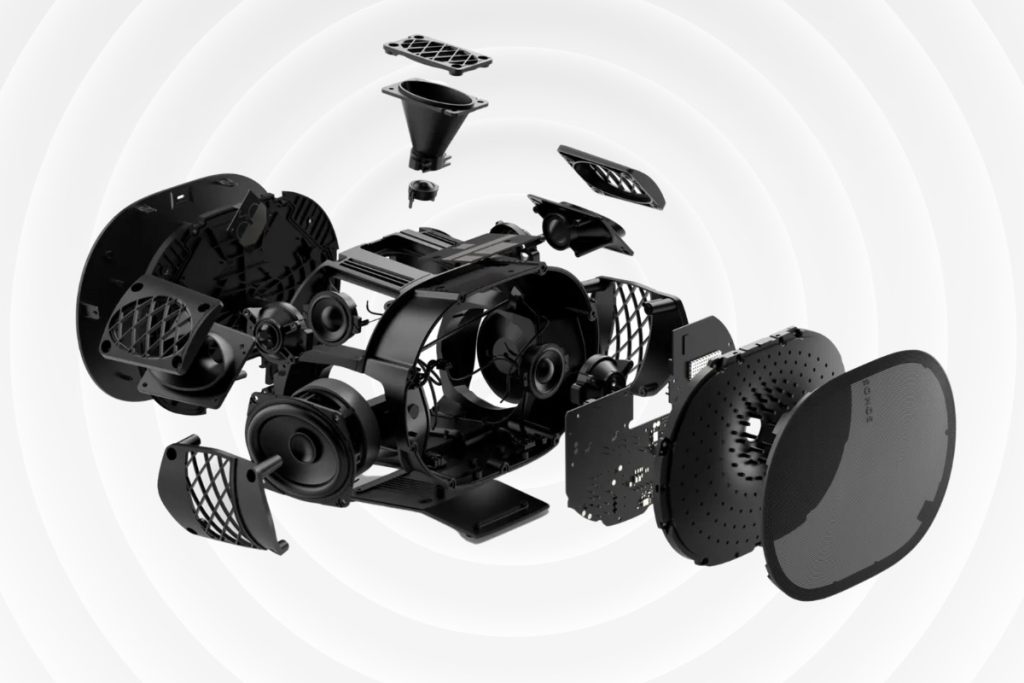
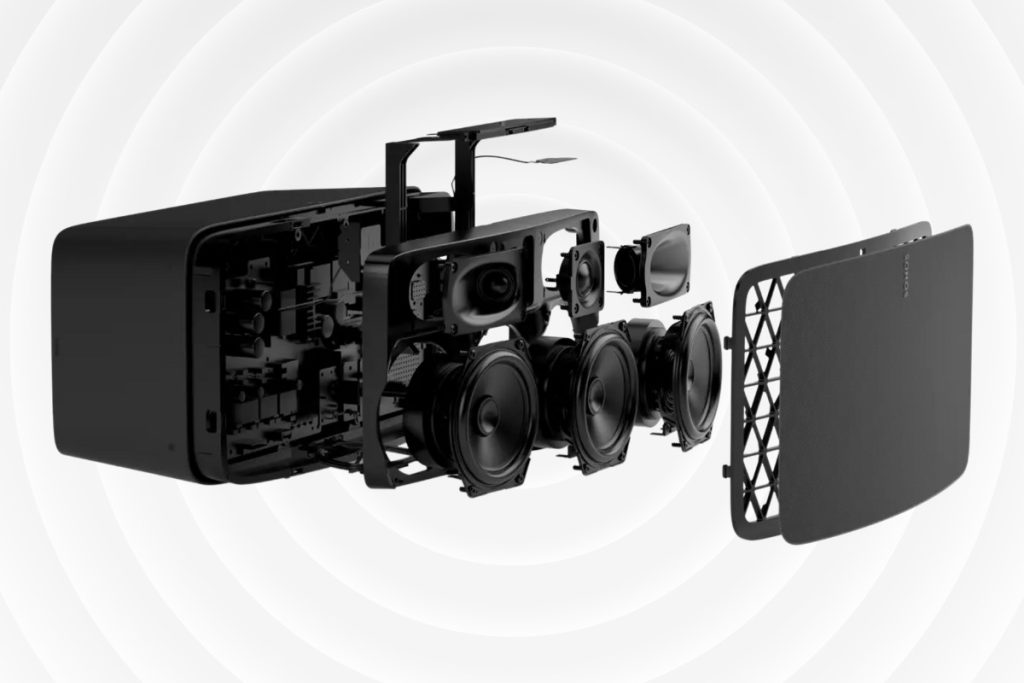
Sonos Five:
Consisting of six drivers, with three mid/bass units, two angled tweeters facing outwards, and a front facing tweeter too. The Sonos Five is primed for stereo listening, delivering a balanced sound signature with impressive weight and impact
Sonos Era 300 Vs Sonos Five: Features
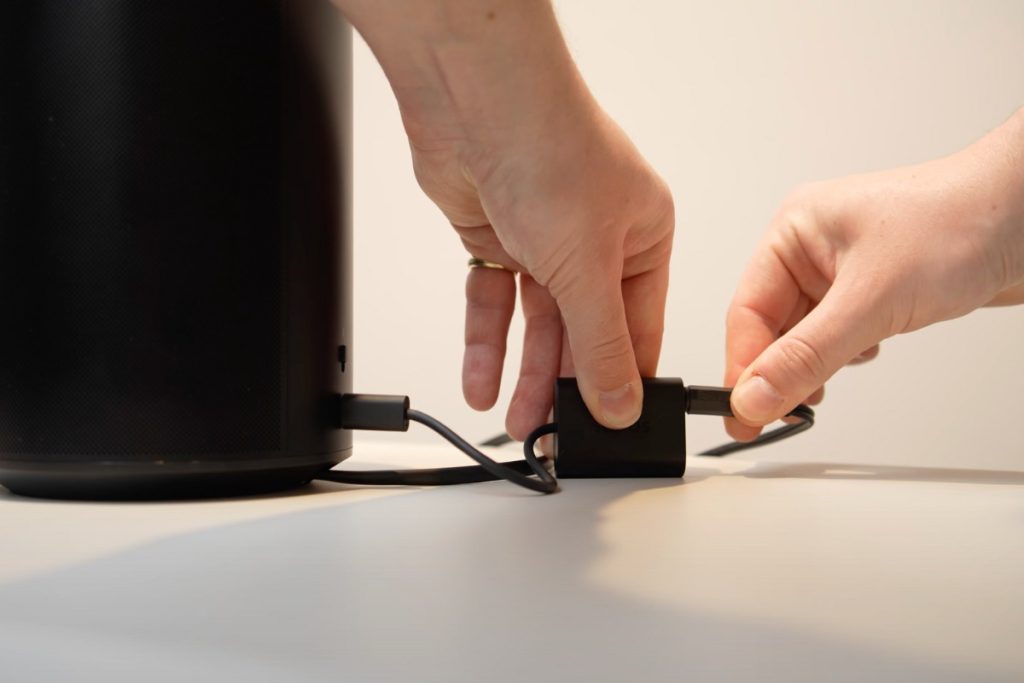

| Sonos Era 300 | Sonos Five |
|
Bluetooth: 5.0 Connections: Wi-Fi 6, AirPlay 2, Bluetooth 5.0, USB-C Port Line-In (via Sonos Line-In Adaptor) Voice Enabled: Yes (Sonos Voice & Amazon Alexa) Spatial Audio: Yes Best For: Spatial Audio and ultimate versatility and immersion |
Bluetooth: N/A Connections: Ethernet, Wi-Fi, AirPlay 2, 3.5mm line-in Voice Enabled: No Spatial Audio: No Best For: Pure Hi-Fi audio quality without any of the fuss |
As Sonos’ premium wireless speaker options, both the Era 300 and the Sonos Five have a lot to live up to when it comes to features. However, looking at both side by side, you’d be forgiven for thinking the Sonos Five struggles to compete when it comes to connectivity.
The biggest difference between these two speakers is their ability (or lack thereof) to support Spatial Audio. The Era 300 has been designed specifically for this purpose, with a multi-directional driver array that supports Dolby Atmos and other audio codecs to provide all-encompassing audio for music, movies, and TV.
The Era 300 is also the first non-Apple device capable of supporting Apple’s Spatial Audio technology. Delivering an immersive audio profile that offers a completely unique experience to what we’ve seen from a Sonos speaker before.
It's worth noting that we’re still early in the spatial audio lifecycle, meaning available content is a limiting factor. So, while you can enjoy spatial audio tracks on a few music streaming services like Apple Music, Amazon Music, or Tidal, to name a few, the list is still missing some big names like Spotify, for example.
Still unsure on Spatial Audio? Watch our Spatial Audio: Explained (Simply) video over on YouTube.

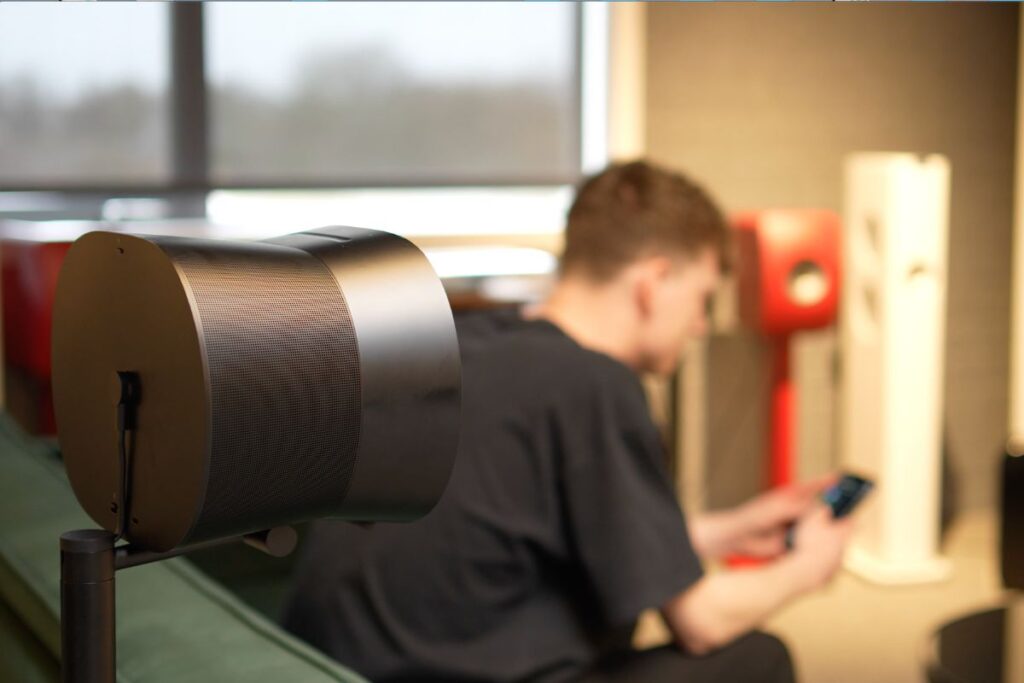
We do expect more services to join the bandwagon as time goes on, but if you’re a Spotify-only user right now or not subscribed to any streaming services with spatial audio support, it may be worth reconsidering if the Sonos Era 300 is right for you.
Along with that, the Era 300 also supports TruePlay Tuning, which has been updated for this model (and the Sonos Era 100). This enables Android users to get in on the act by using the new Quick Tuning feature to optimise the speakers for their space.
Naturally, advanced TruePlay Tuning is still the best method to get the most from your home audio, but like always, you will need an iOS device to get that done with the Era 300.
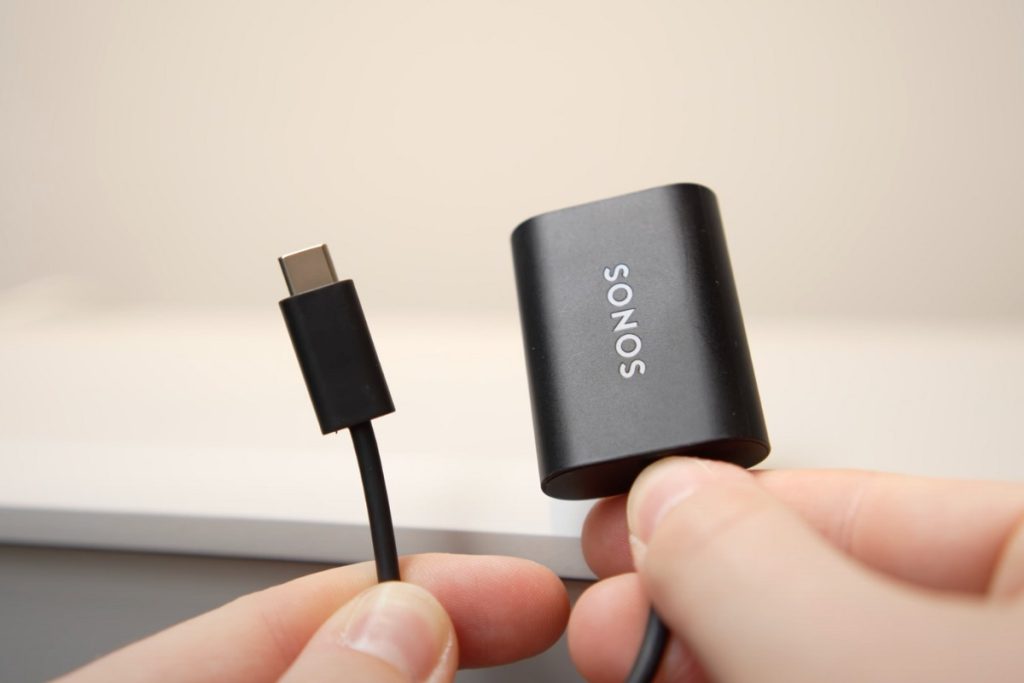
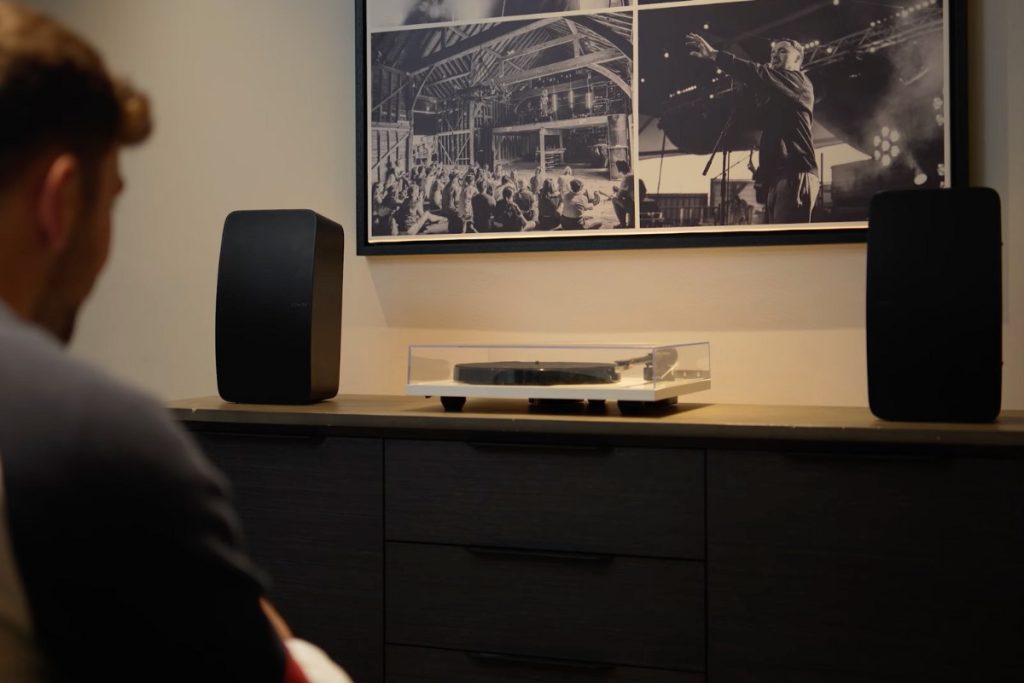
When it comes to the Sonos Five, there’s no Spatial Audio support, and internally, this speaker has a much more traditional makeup. The Five is primed for stereo listening, and features a direct 3.5mm line-in meaning you can hook up an external source device like a turntable with ease, without having to faff around with buying an additional Sonos line-in or combo adapter, which is a plus.
There’s support for Apple AirPlay 2 and TruePlay Tuning for iOS devices, but no Bluetooth, Quick Tuning, or any built-in mics for voice control.
| SHS TOP TIP 💡: If you’ve got this speaker paired up with another voice-enabled Sonos speaker, like a Sonos Arc, for example, you will be able to access that functionality. |
The Era 300 is the more versatile choice of the two. But, the Five still ticks a lot of boxes and, for most people, will be everything you could possibly need from a wireless speaker. The Era 300 does support Bluetooth, so if versatility is important to you, then that is the better option for sure.
Sonos Era 300 Vs Sonos Five: Sound Performance
As standalone speakers, there’s no doubt that the Five is punchier and bassier than the Era 300. The Era isn't a slouch in this department and offers more immersion, but the Sonos Five is bigger and handles higher volume listening much more effectively than the Era 300.
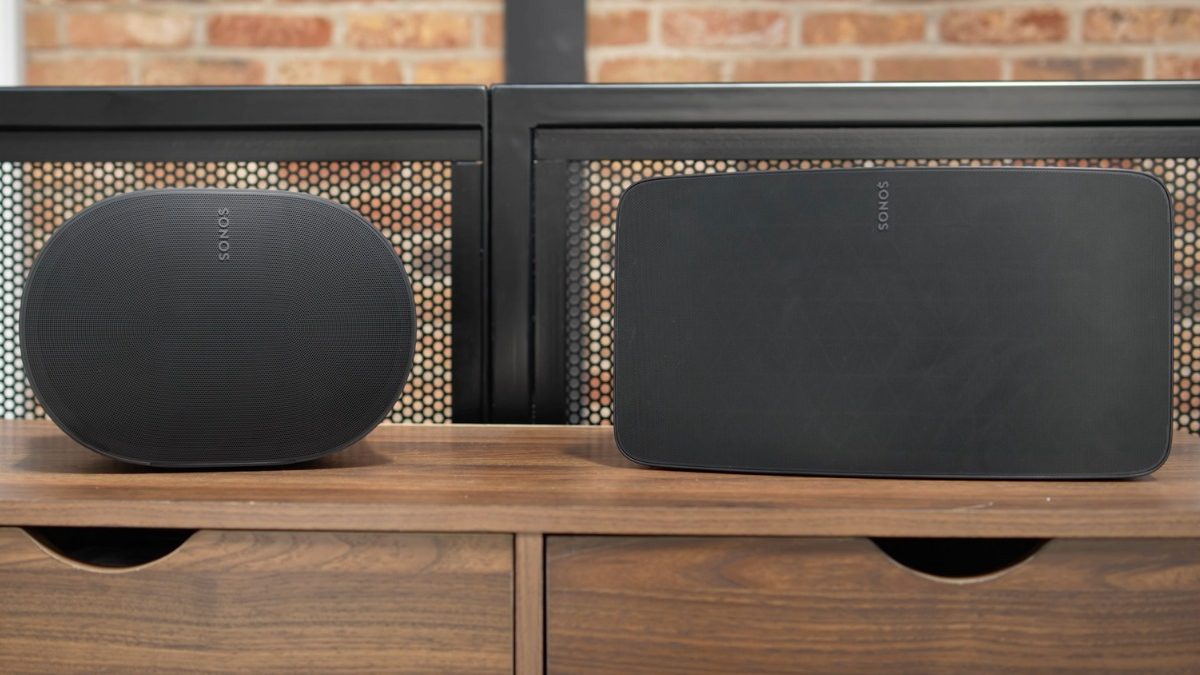
The Five doesn’t benefit from the multi-directionality of spatial audio like the Era 300 and doesn’t quite compete when it comes to spaciousness, or layering of sound. But, this speaker is the powerhouse of the Sonos lineup, and you can tell.
It's got power in abundance, and this is most obvious in bass heavy music. These types of tracks feel more precise and accurate, with more intent behind them, due to the traditional placement of sound.
On the other hand, the Era 300 stands out when it comes to the breadth and expansive nature of its performance. The multi-directionality of audio is the standout feature, which only gets better when you’re listening to Dolby Atmos tracks.
We’ve had the Era 300 since its release, and although the 360º soundscape was novel at first, it hasn’t lost any of its impact the longer we’ve been listening to it.
'Breathe' by Pink Floyd was a great example of the totally engrossing nature of the music presentation, which allows you to feel as if you’re watching a performance live. We can’t see ourselves getting tired of it, and as far as Spatial Audio goes, this is one of the best presentations we’ve seen of it to date.
Dolby Atmos tracks, especially, feel like they’ve got more depth, and the separation between the vocals and instruments helps to take things to another level too.
But it’s not just the broadness of the soundstage that’s impressive, either. Standard music from the Era 300 is dynamic, textured, and unlike anything we’ve ever heard from a Sonos wireless speaker.
If you're torn between the two, as a general rule of thumb, we suggest the Era 300 as the better option if you’re looking for a really unique and hands on listening experience. The Five though, is a better option if you’re the type of person who prefers a more traditional stereo listening experience.
Stereo Pairing
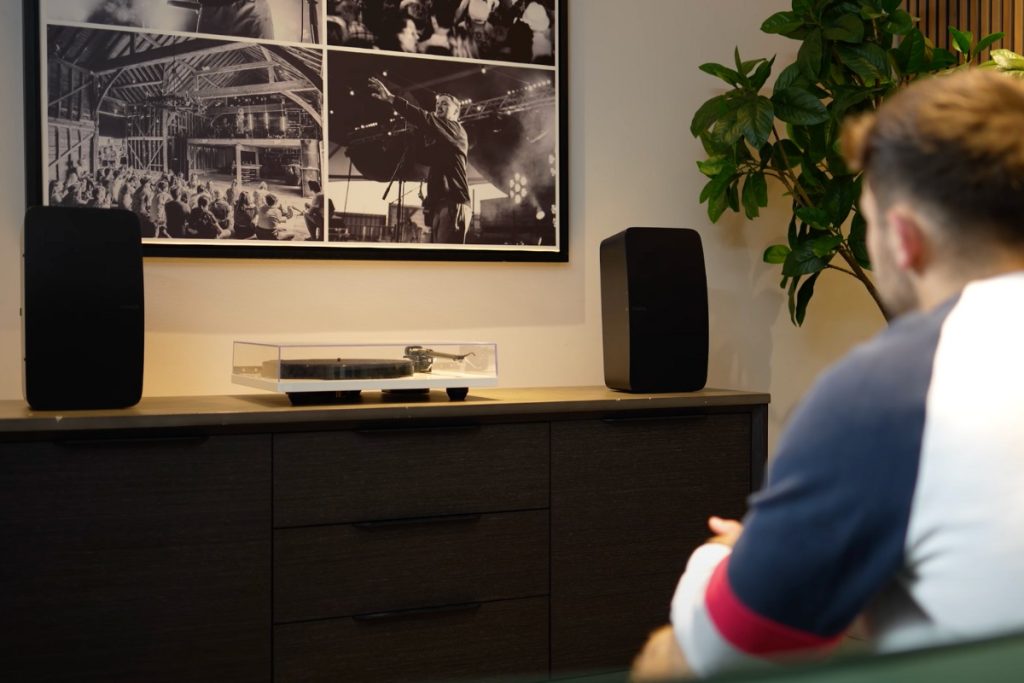
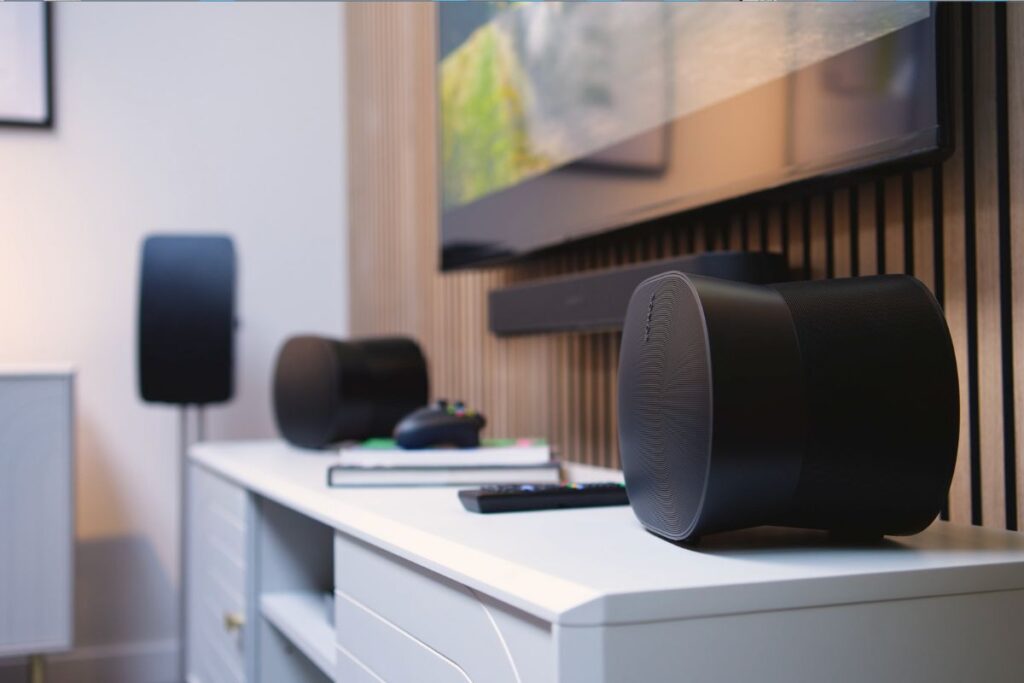
Both of these speakers form a formidable partnership when stereo paired with a second Sonos Five or Sonos Era 300, and this is the setup where they really excel.
As expected, a pair of Era 300’s offer impressively wide and expansive stereo imaging, and the levels of separation were absolutely brilliant throughout our testing.
Using these speakers in a stereo pair definitely helped create an even more immersive experience with sound that truly felt as if it was coming from all around you.
The low-end was more impressive in this setup too, and it stepped up nicely when it came to accuracy and depth. However, as mentioned previously, if you’re the type of person who’s looking to really push the low-end you’re better off going for the Fives here.
Thanks to their bigger and broader approach to music delivery, a stereo pair of Sonos Fives were really impressive on almost any music with a decent bass track.
Admittedly, you do miss out on some of the nuances and details that the Era 300’s pick up on here. But, you can push the Fives further, and if you’re all about volume when it comes to music listening, these will be the better option for you.
Both sets of speakers excel in different areas and deliver music in different ways, but both are worth their premium price tag in our book. The final decision about which stereo pair is right for you will depend on your own specific listening preferences.
As Surround Sound Rears
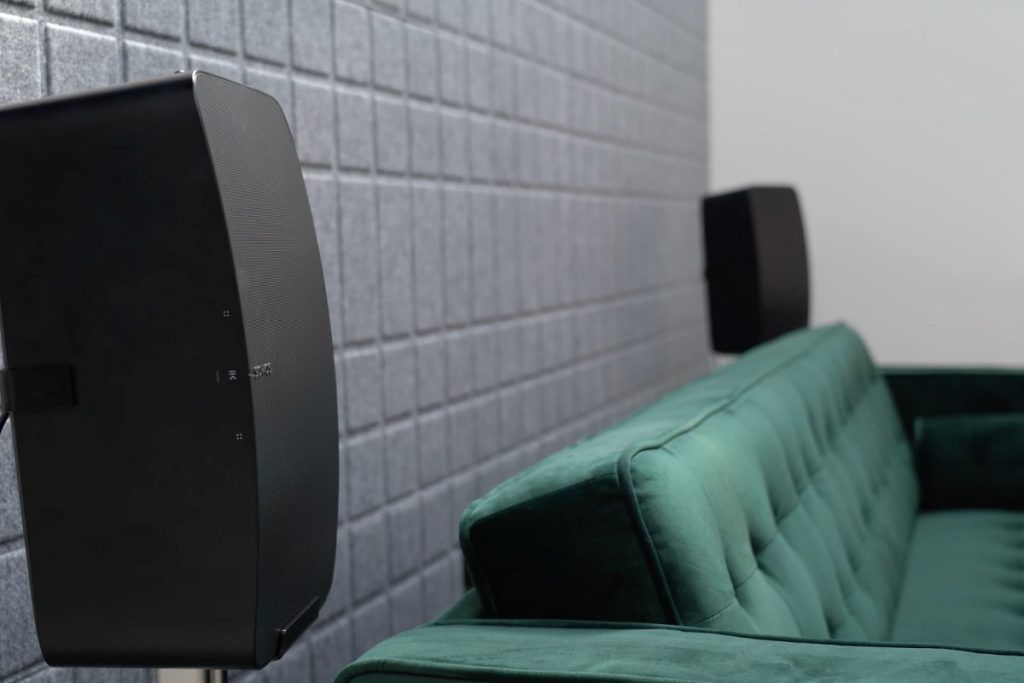
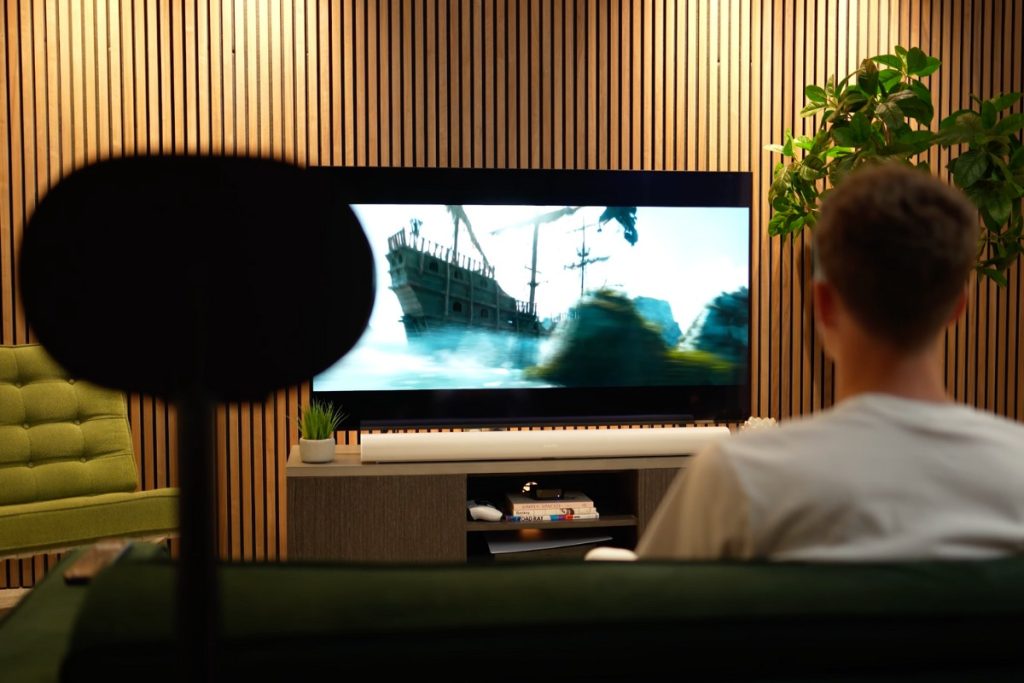
There’s also the option to hook up these speakers as rears in a Sonos home cinema, and although this might be a little overkill for some people, sometimes you can't help but just want the best.
If you're unsure about your rear surround choice, we've tested both the Sonos Arc and the Sonos Beam (Gen 2) with every Sonos home cinema setup over on YouTube which might simplify things.
Regardless of which rear surround sound speakers you go for, it's going to be a great solution for ramping up the performance of your Sonos soundbar, especially if you’ve got a Sonos Arc. However, as mentioned throughout this blog, you are going to get a slightly different performance from each option.
The Sonos Fives are capable of delivering a more traditional rear performance, making use of more forward and lean sound profile accompanied by impressive power.
Whereas the Era 300’s are in a league of their own when it comes to the immersion of Dolby Atmos movies. If cinematic-level immersion at home is what you’re after, this is the best way to achieve it.
Again, both of these are great surround sound rear choices for a Sonos home cinema, and if you’ve got the budget, by all means, treat yourself. But depending on what you’re actually trying to achieve from your home cinema setup, you might be better off going with one speaker over the other.
It’s also worth remembering that a pair of Sonos Era 100's is also a great option as surround sound rears and will offer more than enough immersion for most spaces. We'd recommend these for Both the Sonos Arc and the Sonos Beam (Gen 2) but it's worth taking a look at all of the Sonos Home Cinema Bundles on our website before making your final decision.
Should We Expect A Sonos Era 500 Soon?

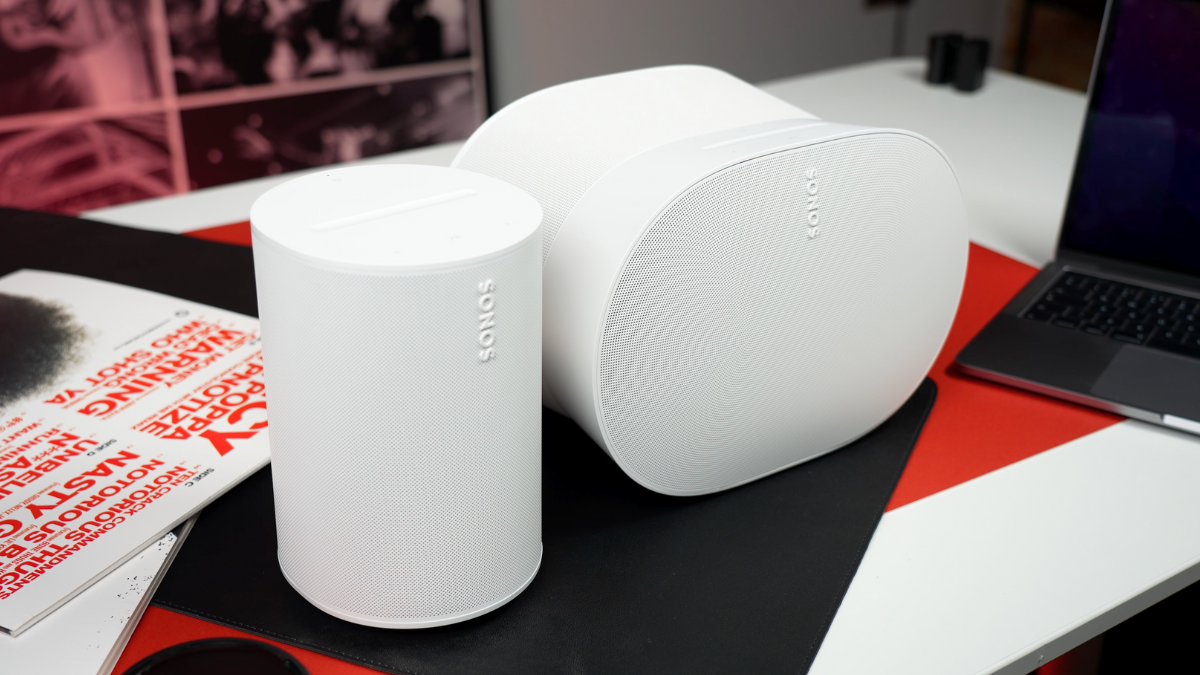
Disclaimer: Anything mentioned here is purely speculation and doesn’t represent what we’re going to see from Sonos in the future.
The addition of the Sonos Era 100 and Sonos Era 300 in March 2023 has naturally sparked rumours of a potential Era 500 being on the horizon. However, at present, there’s been no official announcement of a Sonos Era 500.
As the Sonos Five is already the second generation of its kind following its rebrand from the Sonos Play:5 back in 2020, we could see it being upgraded in the future to complete the Era lineup.
But truthfully, we don’t see this as a speaker in desperate need of an update right now, and although enhanced connectivity would be brilliant, considering the Era 100 and 300 are still early in their life cycles, we can’t see an Era 500 coming anytime soon.
So although, yes, it would make sense for Sonos if they were looking to reinvigorate their lineup, and yes, we can see it happening further down the road, all we know for sure right now is that the Sonos Five is here to stay and is still a worthy competitor for you to consider.
Our Verdict
When it comes to picking between the Sonos Era 300 and Sonos Five, both offer completely different experiences and tick different boxes, making this a really tough one to call.
You can’t ignore the Era 300 with its support for spatial audio because, when a Dolby Atmos track is mixed right, it really is hard to beat. That being said, if two-channel audio is the way you want to go, or you’re a Spotify-only user with no spatial audio release date on the horizon, then I can see why the Sonos Five would be the better pick hands down.
Either way, as Sonos’ two premium wireless speakers, they are both solid options. It's now a case of taking what we’ve shared throughout this blog and working out what’s most important to you, and of course, deciding whether the Five is worth the extra budget.
Other USeFul Content
Video: Sonos Era 300 Review: Game Changer
Video: Which Sonos Era speaker is right for you? Era 300 vs 2 x Era 100
Video: Sonos Five Hands-On Review: What's New?
Video: Sonos Five vs KEF LSX II: It's Complicated...
Blog: Sonos Era 300 Review: One Month On...
We hope you found this helpful, but of course, we realise that purchasing a new wireless speaker is a big decision, so we are more than happy to assist with any queries you may have.
Please reach out on:
| info@smarthomesounds.co.uk | |
| Live Chat on our Website | |
| 0800 677 1100 |
Torn between the Sonos Era 300 and the Sonos Five? Figure out which Sonos wireless speaker is right for your space.
One Month With The Sonos Era 300
It’s been a month since we finally got our hands on Sonos’ first ever upwards-firing Dolby Atmos Smart Speaker: the Sonos Era 300 and we have a lot of thoughts to share in this review.
The storm that was the Sonos Era 100 & Era 300 release has finally died down, the dust has settled and I'm sure by now you will have heard everyone’s initial thoughts. But the question is, is the Sonos Era 300 really worth buying one month on and is it living up to the hype?
In our initial Sonos Era 300 review, we tested it as a standalone speaker, in a stereo pair, as rears to a Dolby Atmos Sonos soundbar and grouped with other Sonos speakers for an extensive multi-room home audio system in our showroom.
Watch our Full Sonos Era 300 Review on YouTube below
But, nothing can really compare with real-life experience living alongside this speaker over a prolonged period of time. So, I took one home, lived with it for a month and think it’s time to finally share my first-hand experiences with you guys.
Sonos have a stellar reputation for producing top quality audio products and whether it’s their Dolby Atmos soundbars, portables or wireless speakers, expectations are always high and the Era 300 is no exception.
As a brand new entry into the Sonos lineup, built with 6 speakers firing sound to the front, sides and upwards, this Dolby Atmos speaker delivers a wide soundstage with a truly immersive and room-filling 3D audio that we haven’t seen before from a Sonos Speaker.
Of course, with a whole host of extended connectivity features including Wi-Fi 6, Bluetooth 5.0, Voice control with Amazon Alexa or Sonos Voice, Airplay 2 and a USB-C line-in for external audio sources too. Not to mention the brand new aesthetic and spatial audio functionality, we’ve had plenty to get our teeth into over the last month.
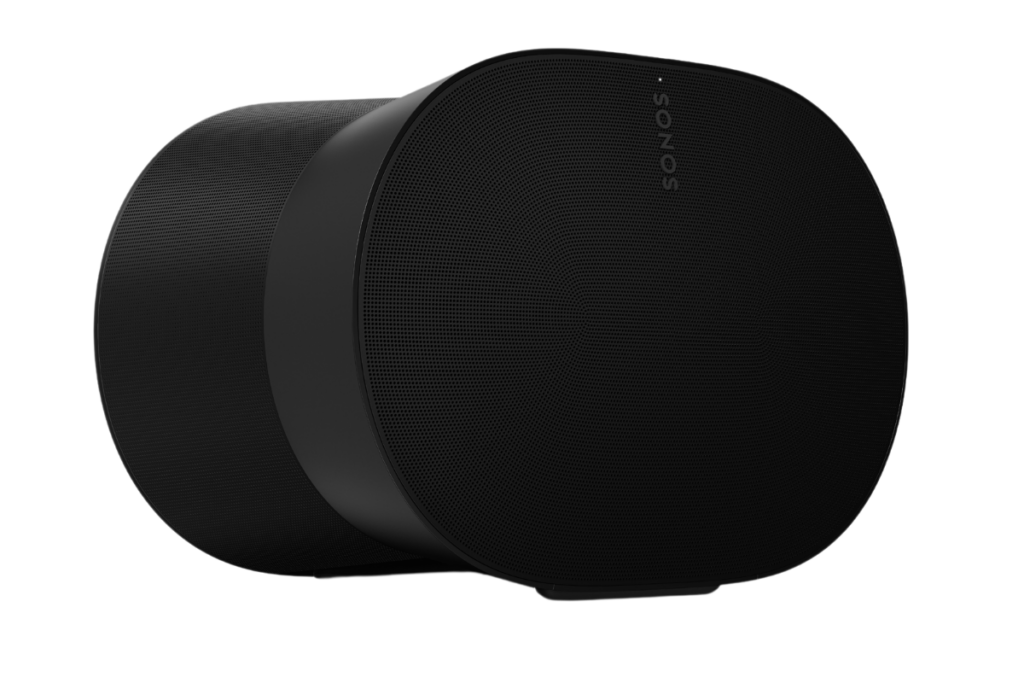
| Sonos Era 300 |
| RRP £449 (see latest pricing) |
1 DAY IN
Who Are You and What Have You Done With My Sonos Speaker?
Unbelievably clever packaging aside, this one took some getting used to. The overall design is… unique to say the least and some of you will love it others will loathe it.
It’s a little bigger than I expected and needs about 2 feet of clearance above the speaker and 8 inches on the sides for optimum performance which is something worth bearing in mind. Maybe I should have pre-planned where I was going to position it beforehand.
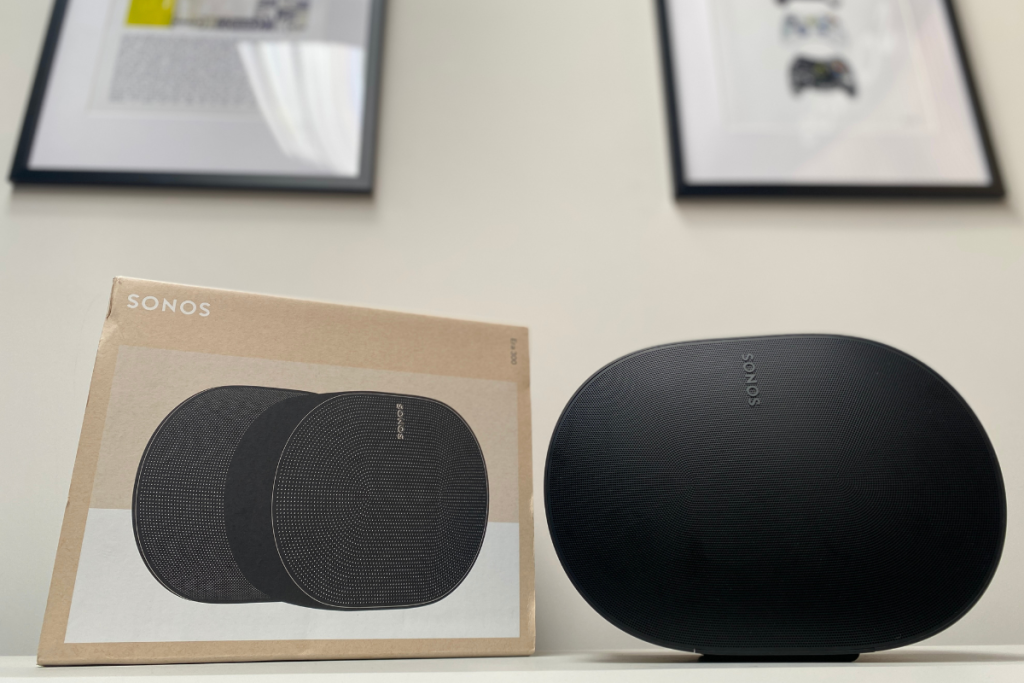
Setup’s been a piece of cake as always with the Sonos S2 app and I'm a big fan of the new top panel controls - especially that volume slider! (honourable mention to that rear mic mute toggle too)
I can’t wait to have a play around with all the enhanced functionality, that USB-C port is looking tempting. I might have to get that turntable back out again.
There’s plenty of music streaming services to choose from. Airplay 2 and Spotify Connect make playback really easy, but I genuinely can’t believe it's taken this long to get Bluetooth connectivity from a Sonos home speaker. Little tip, you can use the Era 300’s Bluetooth 5.0 connectivity to act as a bridge for the rest of your system so you can stream Bluetooth throughout your entire multi-room system which is a nice little plus too.
I’m not too sure how I feel about spatial audio just yet though. I’ve found the Spatial Audio Playlists on Apple Music and Amazon Music but some tracks sound great and others aren’t as impressive. Am I even doing this right? I think I need to do some research on that one.
1 Week In
It’s Turntable Time, Baby!
I’ve loved listening to the Era 300 as a standalone speaker over the past week. The experience definitely felt different to something like the Sonos Era 100 or Sonos One (Gen 2). It’s not quite as powerful as a Sonos Five but the multi-directionality of the Era 300 makes this feel like a completely unique listening experience which I'm slowly falling in love with.
I think it’s time to bite the bullet though and get my hands on a Sonos Line-In Adapter (even if it is an extra £19). I wasted a couple of days trying to find a cheaper 3rd party adapter on Amazon and none of them worked. I should’ve just gone for the Era 300 and Line-In Adapter bundle.
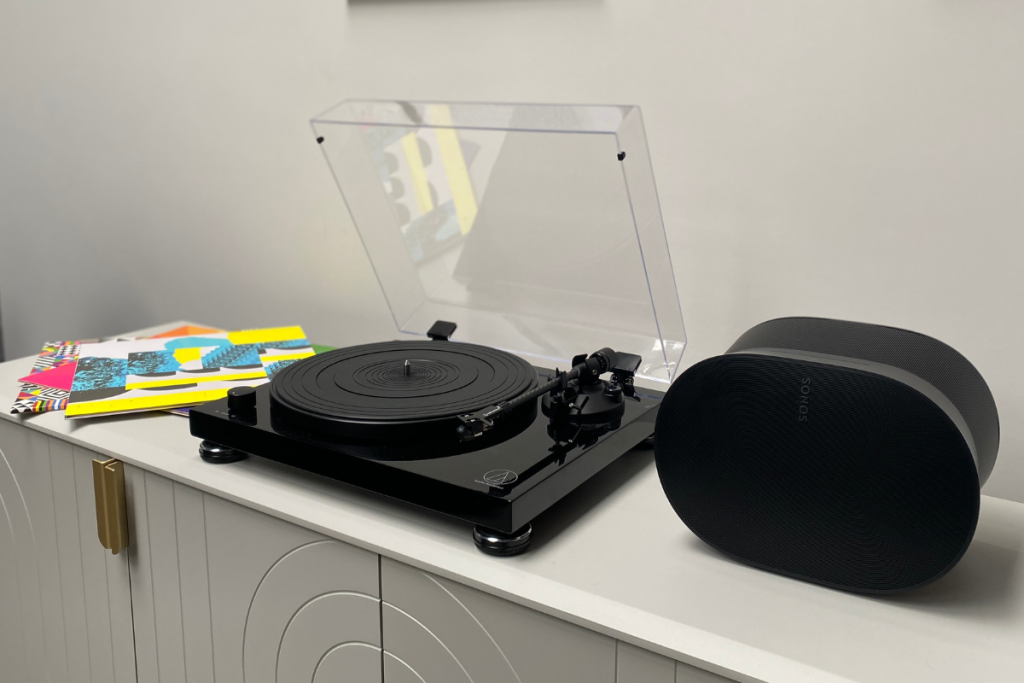
I’m not a huge vinyl enthusiast but it’s a nice addition to get some proper use out of my Audio Technica AT-LPW50PB by connecting it up with my Sonos system. I’ve added some more vinyl to the collection too, so I'm not complaining.
I’m a sucker for voice assistance but the absence of Google Assistant is definitely a miss. Sonos Voice is an OK voice assistant in comparison and I think if you want the best, you’re going to have to go for Amazon Alexa.
Advanced Trueplay Tuning has helped kick things up a gear and it's nice to see Android users can finally join in too with the new Quick Tuning feature. I’m hoping this is something they update across the board so i don’t have to keep going to my parents house and Tune their other Sonos speakers.
2 Weeks In
Spatial Audio IS the Future
I'm finally getting to grips with the whole spatial audio concept. Despite regular stereo listening being enjoyable with the Era 300, Spatial Audio is something else.
I’ve figured, a lot of what makes a great spatial audio track comes down to the creative interpretation of the producers back in the studio. Hence, why some mixes sound great and others are a little less impressive.
Still unsure what Spatial Audio is? Watch our Spatial Audio Explained video.

My general rule of thumb for finding the best mixes though is to look out for the Dolby Atmos logo on my chosen streaming platform as these tend to be the better constructed mixes with a more dynamic listening experience that’s overall just more impressive.
Apple Music is probably the best place to listen to spatial audio tracks in my opinion because pretty much all of them are mixed in Dolby Atmos. Beyond Apple themselves, no one else has a dedicated link to the Apple Music server apart from Sonos, making the Era 300 the only other way to experience Apple Music Spatial Audio from a single speaker right now so I'm loving life being a subscriber.
There’s still no support for spatial audio on Spotify which I can see being really frustrating for a lot of people. It feels like this is the direction audio is going though, so surely it can't be too long until they jump on board? Until then we’ll just have to make do with Apple & Amazon Music.
Spatial Audio aside, the Sonos S2 App is still as good as always. There’s plenty of customisation options to really optimise the listening experience and get great audio even in standard stereo. I feel like I could spend a good couple of days testing out the different EQ settings and height channel adjustments.
3 Weeks IN
All About Marginal Gains
After a lot of thinking, I think it’s time to say goodbye to my original placement of the Sonos Era 300. My media unit has been great but I’m all about optimisation and I want this speaker at optimum listening height so it’s got to be floor stands for me.
Getting the very best performance is no mean feat though, especially considering a single Sonos Era 300 Floorstand comes in at around £149 RRP (it might be back to the drawing board).
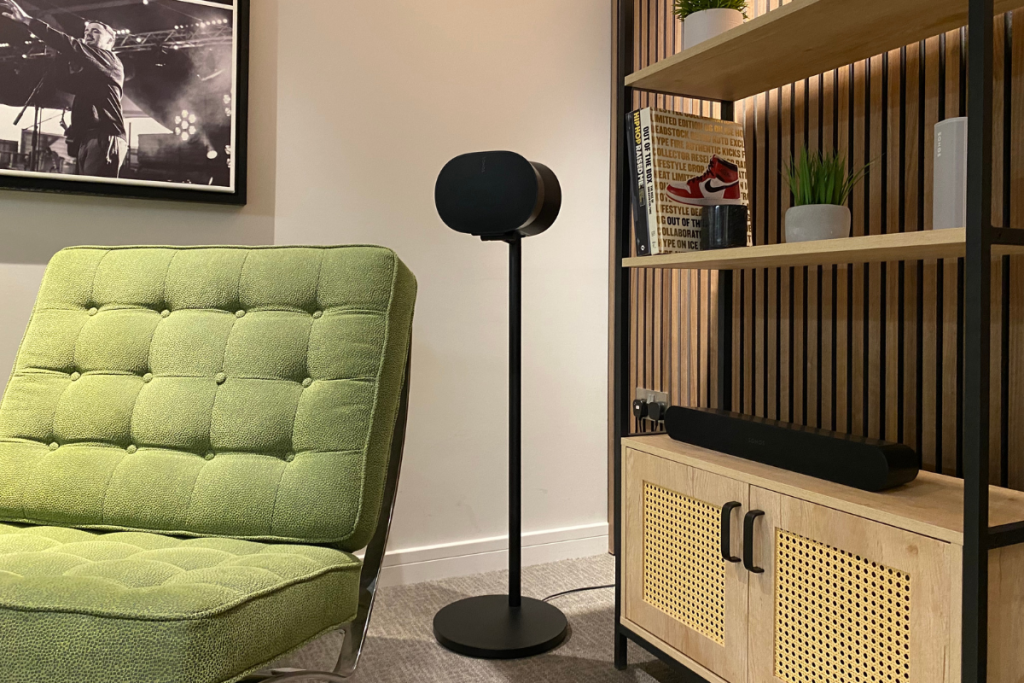
I ended up picking up a cheaper Sanus Floor Stand for £99 that is still custom-made for the Era 300. There were some other options from Mountson & Flexson but I just thought this one suited my space the best.
After all the dithering I’m glad I went for it to be honest. I’m already halfway there if I ever want to add a second Era 300 to my home and have two stand mounted rears in a home cinema setup for example.
ONE MONTH IN
We Want More!
I’m loving spatial audio - I just wish there was more of it. I can’t fault the fun I've had listening to my favourite tracks in a completely new way. But there’s nothing worse than finding a track you’d love to hear in spatial and it not being there (trust me, it’s worse than heartbreak).
Maybe it's a little early to be on the bandwagon just yet, but there’s nothing wrong with being early to a party. Especially when it sounds this good! Plus, there is enough out there to make the most of it right now.
I can see why a lot of you would be worried that without a subscription to a streaming service that supports spatial audio and Dolby Atmos tracks, this speaker wouldn’t be a worthwhile purchase. But it’s still a great option for those of you looking to enjoy a more immersive music experience, even in traditional stereo.
What Does The Future Hold?
I’ve had the pleasure of testing the 2x Sonos Era 300's in a stereo pair as well, and I've got to say that at this rate, I'm going to struggle not to add a second one of these when I get the chance.
I think the design of this speaker has definitely grown on me and it definitely feels like a next-generation Sonos speaker and I’m pretty chuffed now it's settled in. If I had it my way, I'd already have a second one at home. My partner on the other hand… might need a little more convincing.
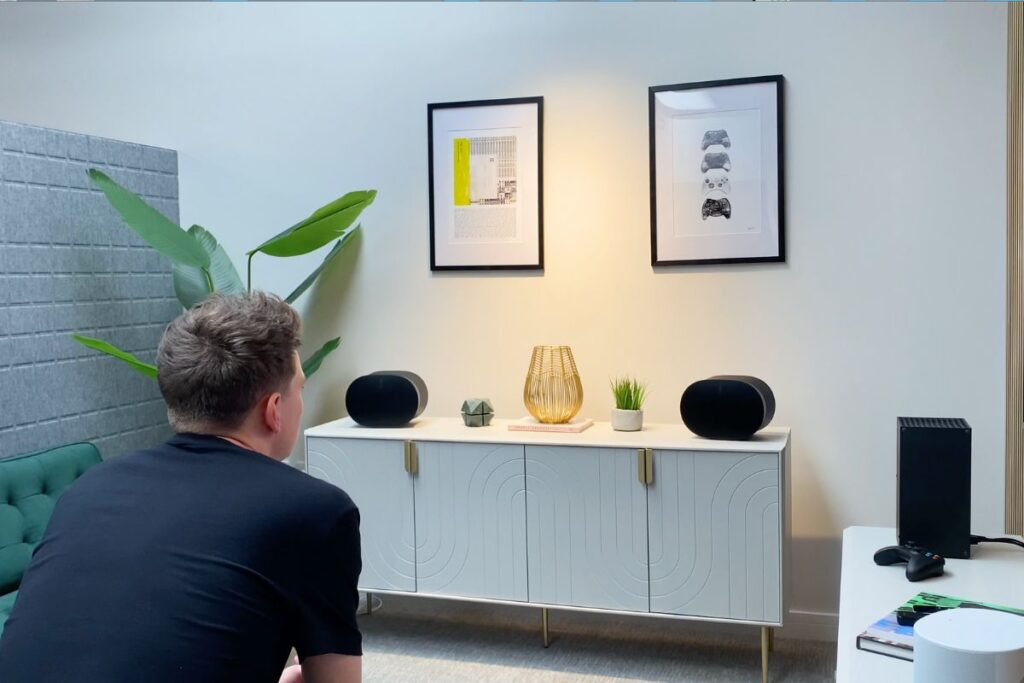
But, that’s the beauty of Sonos, their speakers are versatile, and you can expand later down the line and transform what’s already a great bit of tech into a staple part of your home entertainment system at any rate you want.
Now, I'm not one to succumb to FOMO, but after listening to a friend's 7.1.4ch Sonos home cinema setup, this might be a direction I look to go down too. I’ve already got a Sonos Arc and a Sonos Sub Mini, and I could definitely see myself swapping out my Sonos One SL rears for some Sonos Era 300’s at some point.
You know that feeling when you're at the cinema, and you're so engrossed in the film that you forget you're even there? That's the kind of experience you get with the Era 300s and I'm all about it. It’s a totally different experience that adds an extra layer of immersion that I didn't know was there.
Is The Era 300 Worth Buying?
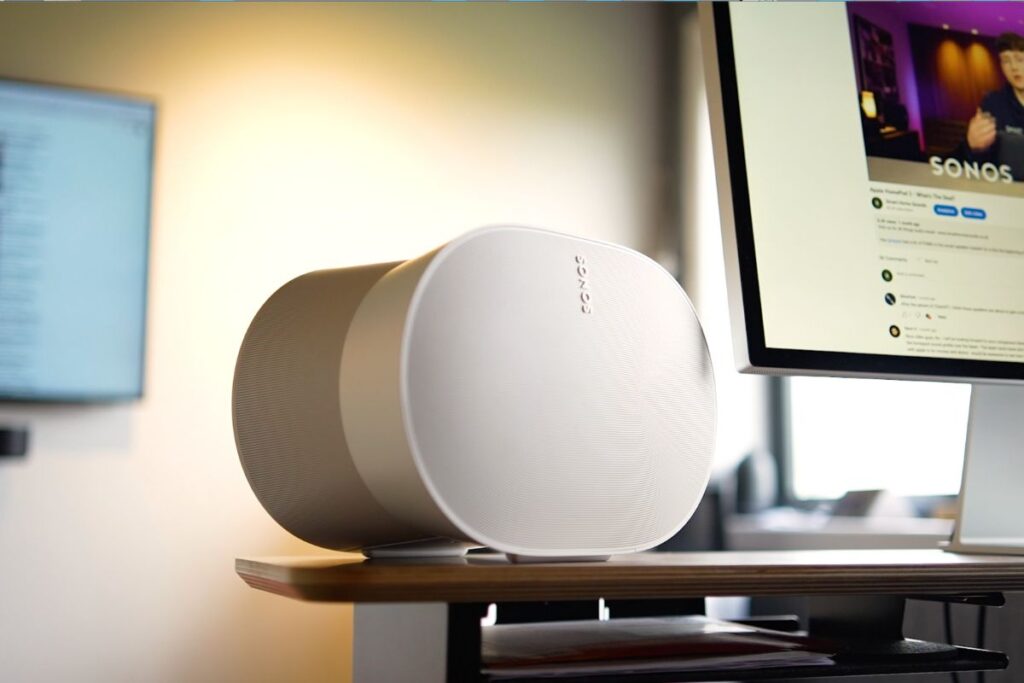
Let’s face it we all want the latest and greatest bits of tech, but what sets a good device apart from a great one is how it performs in the real world and as this is a Sonos Era 300 Review, it's only fair we share our thoughts.
Admittedly, it took a little time to get used to but the Sonos Era 300 is a speaker that grows on you. It’s so versatile and unique that other speakers feel a little one dimensional in comparison now.
If we forget about all the technical bits for a second and focus on what's really important: the music. Boy, does the Era 300 deliver. It's immersive, expansive and a joy to listen to. While it may not be for everyone, this speaker is a true testament to Sonos' commitment to pushing the boundaries of audio innovation and it definitely screams next-generation. So, if you're in the market for a new speaker and don't mind splurging a little bit, the Sonos Era 300 is going to be a sound investment (pun intended).
| info@smarthomesounds.co.uk | |
| Live Chat on our Website | |
| 0800 677 1100 |
Is the Sonos Era 300 Really Worth Buying?
Bose Smart Soundbar 600 vs Sonos Beam (Gen 2): Which soundbar should you buy?
The Sonos Beam (Gen 2) and Bose Smart Soundbar 600 are both Dolby Atmos enabled soundbars nearing the £500 price point and both are big contenders in the compact soundbar market. The question is, which should you be spending your money on?
Well, If you haven't got much time on your hands, we've made a full comprehensive comparison video over on our YouTube channel for you to watch instead.
Watch our Bose 600 vs Sonos Beam (Gen 2): The Best £500 Soundbar comparison!
Following its release in October 2022, the Bose 600 has turned lots of heads due to its high performance levels. Coming in with an RRP of £499.95, it sits between the Bose 300 and Bose 900 as their mid-range soundbar option.
Of course, there's no better competition to compare it with than the multi-award-winning Sonos Beam (Gen 2), crowned WhatHiFi’s 2022 Best Soundbar Under £500. Coming in £50 cheaper than the Bose 600, the Beam (Gen 2) at £449 could offer more bang for your buck if you decide it's the right choice for you. So let's put them to the test.
More: Sonos Beam (Gen 2) Review: Is It Worth It In 2023?
Disclaimer: Prices can often fluctuate so check the links below to check the latest pricing.
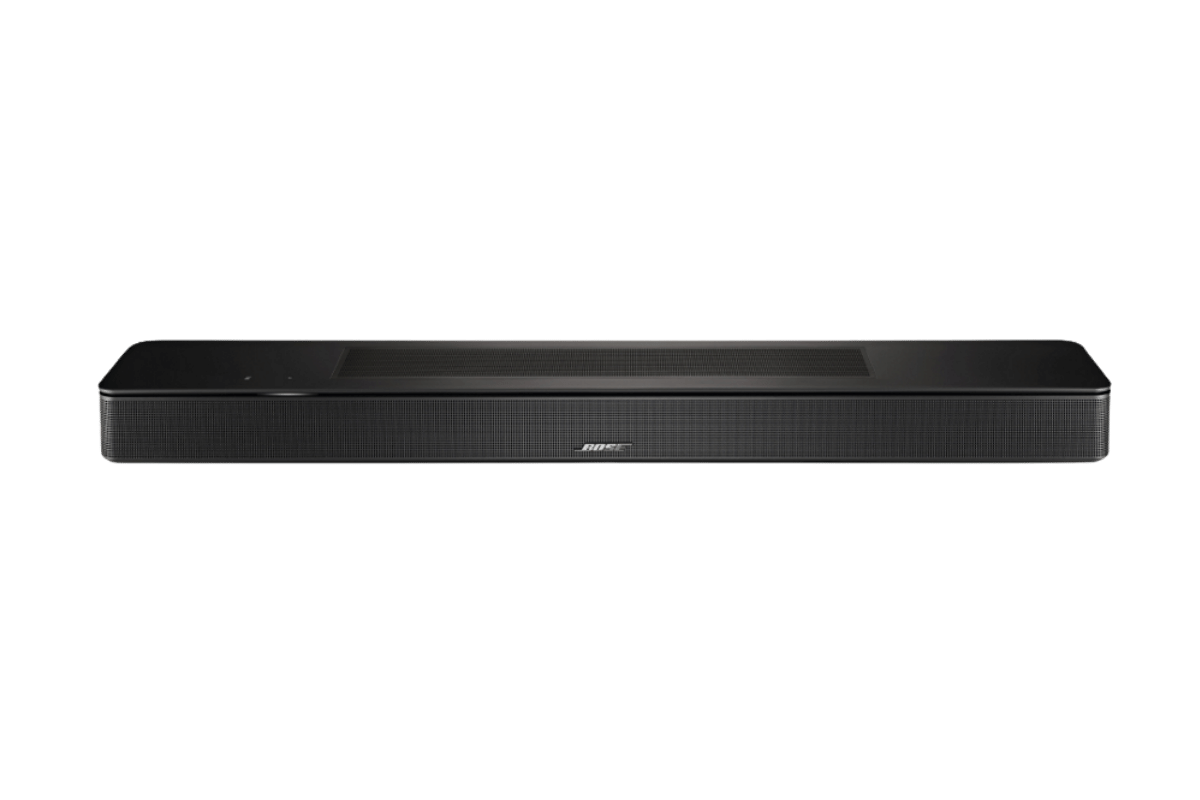 | 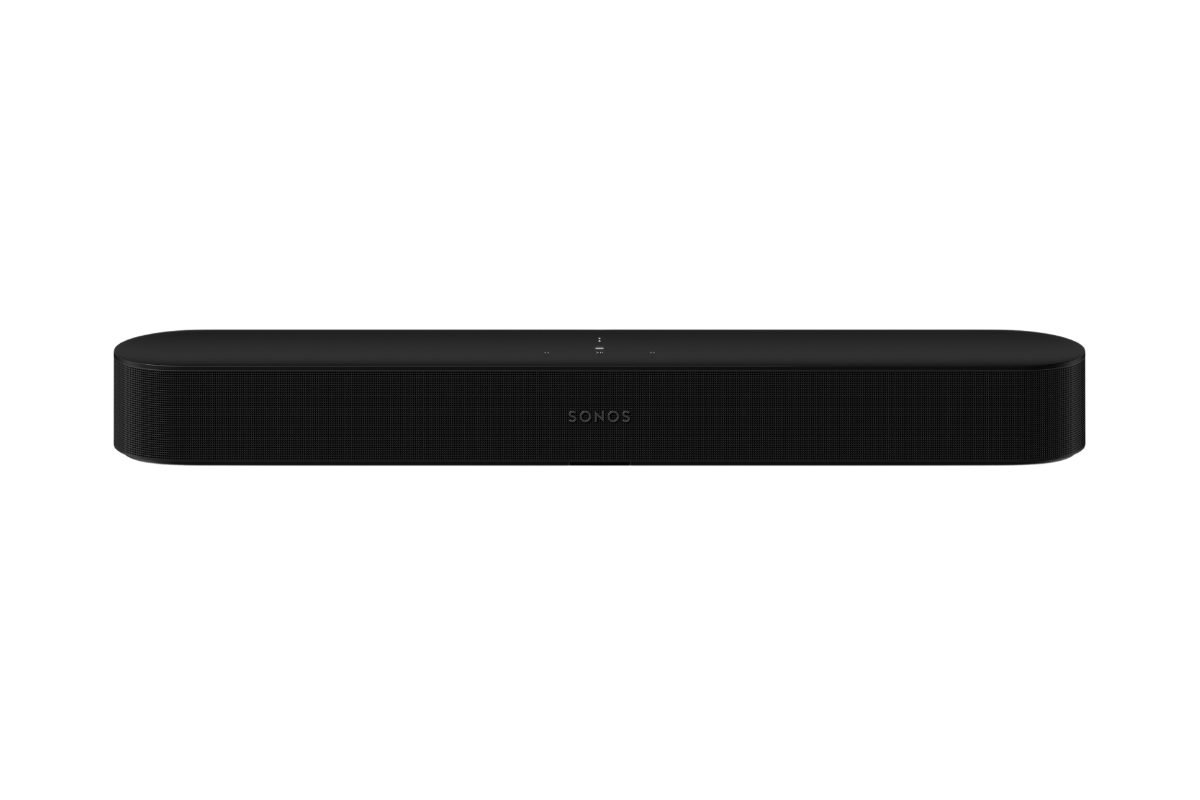 |
| Bose Smart Soundbar 600
RRP: £499.95 (see latest pricing) View Bose 600 | Sonos Beam (Gen 2)
RRP: £449 (see latest pricing) View Sonos Beam (Gen 2) |
Design
Before we dive into performance, we first need to take a closer look at the overall differences in design. After all, these soundbars are built to be at the front and centre of your space, so visuals is an important part of the buying process.
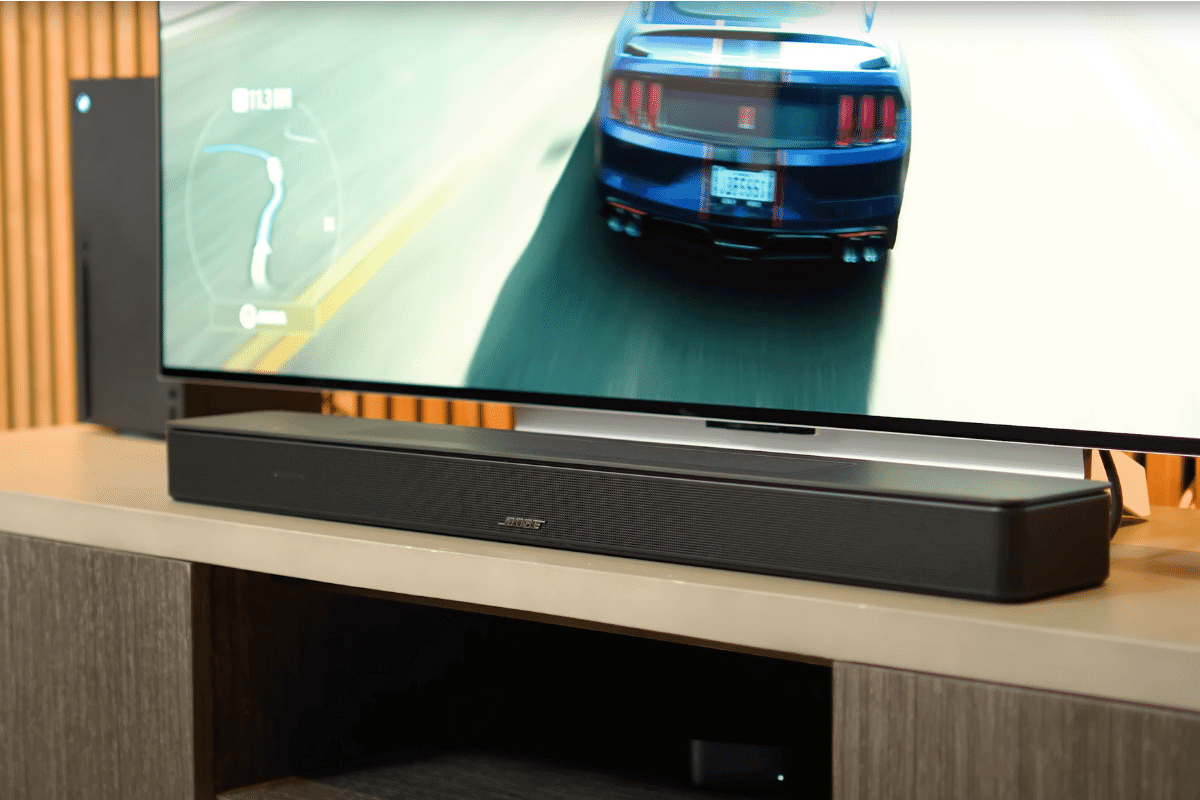 | 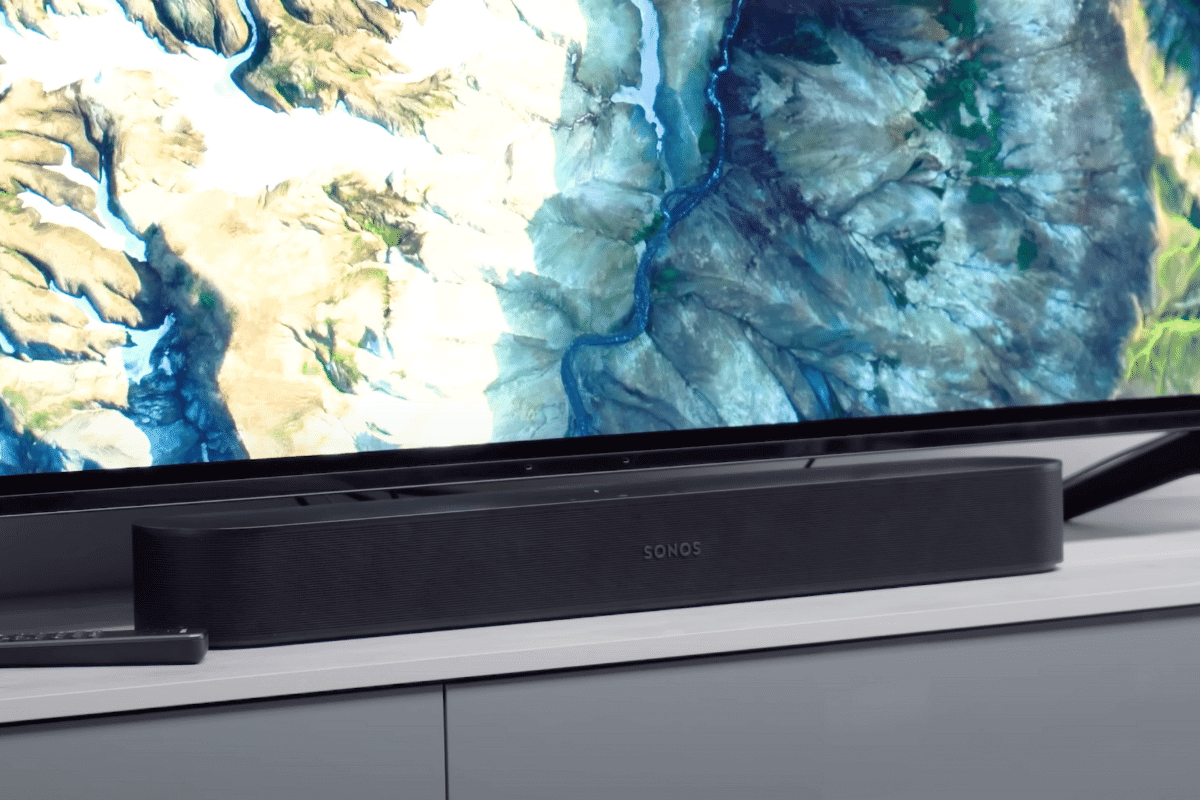 |
Straight out of the box, the most noticeable variation is their difference in shape. The Bose 600 sports a rectangular design which is considerably different to the Sonos Beam’s curved body. There isn’t a specific reason for this variation other than aesthetic solutions that accommodate the side-firing drivers in each soundbar. Constructed with similar materials, both soundbars have a matte plastic finish with a metallic wraparound grille. However, the Bose 600 has the addition of a top panel grille which is home to a pair of upwards-firing drivers.
The Sonos Beam Gen 2 is available in both black and white, whilst the Bose 600 is only available in black. However, a huge benefit of both soundbars is their ability to fit seamlessly into any home due to their discreet design and compact size.
Although the Bose is slightly wider and deeper than the Beam, it is shorter, which may be something to keep in mind when making your decision. Both soundbars are very similar in terms of dimensions the Bose 600 comes in at 5.61 x 69.4 x 10.4 (H x W x D cm) while the Beam (Gen 2) differs very slightly at 6.9 x 65.1 x 10 (H x W x D cm).
Ultimately, we think that the design will split opinions and your final choice will come down to personal preference. However, if you’re unsure and want a second opinion. We think the Sonos Beam (Gen 2) offers a more sleek and modern aesthetic while the Bose 600 has a more traditional black box style.
Connectivity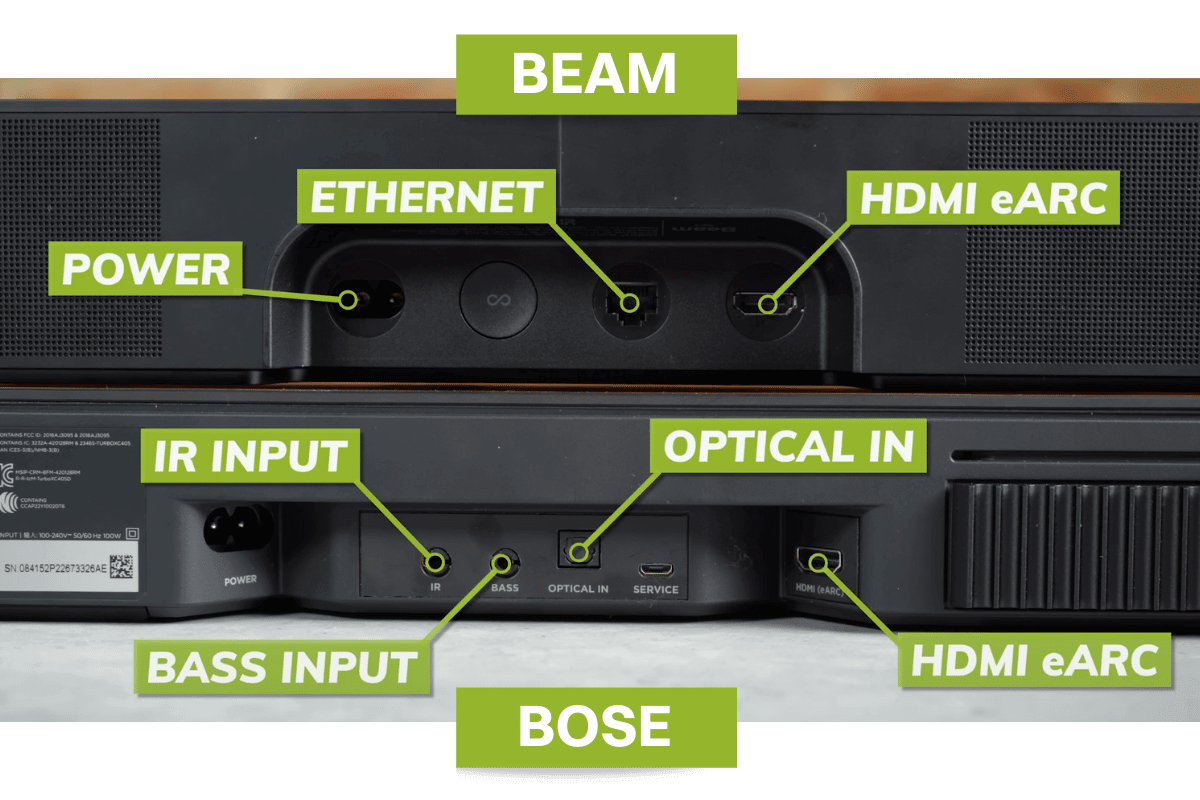
When it comes to connectivity, Sonos keeps it simple. The Beam has one ethernet port, a single HDMI (eArc) port and an optical adapter provided in the box. The Bose on the other hand has a much more extensive connections list consisting of IR, Optical, HDMI (eArc) inputs and a port to hard wire a bass module. Both soundbars use WiFi to connect with their respective apps and have Apple Airplay 2 capabilities. But the Bose is also Bluetooth and Chromecast enabled whilst the Beam is not. So, if you’re the type of person who makes the most of Bluetooth connectivity or streams from an android phone outside of the app, the Bose could be the better option for you.
Controls & Useability
The Bose 600 and Sonos Beam (Gen 2) have some control capabilities on the soundbar itself. However, the Bose comes with a separate IR remote for control too. When it comes to their app functionality, both the Sonos S2 and Bose Music apps are very user-friendly, making it difficult to pick which platform has the better interface.
We were particularly impressed with the EQ customisation options of the Bose 600. The ability to freely control the exact output from the height channel, treble and bass was a welcomed option. However, the centre channel adjustments stood out for us as a great feature and is definitely something that Sonos should take inspiration from in the future. On the other hand, it must be noted that we did encounter some slight lagging when using the Bose App throughout our testing. So, although it isn’t a deal breaker for us this may be something to consider before you buy.
 |  |
The Sonos app gives its users a good level of customisation too. Adjustable bass and treble as well as night mode and speech enhancement mean that you can fine-tune the Beam to suit your listening environment perfectly. Sonos are renowned for their ecosystem and app functionality. The simple nature of grouping rooms together and toggling different elements on and off is a prime example of the S2 app's intuitiveness. In our opinion, we think the S2 app is our preferred choice when it comes to useability, but only by the finest of margins.
We’ve also got to point out that for IOS users, the Sonos Beam has Trueplay Tuning capabilities too. Meaning that after analysing the way sound reflects off of your room's walls, furnishings and other surfaces. Your soundbar will adjust its output to provide a fine-tuned performance that precisely matches the acoustics of your space. This is one of our favourite features from Sonos and something we recommend taking into account if you’re an IOS user who's torn between these soundbars.
Internals
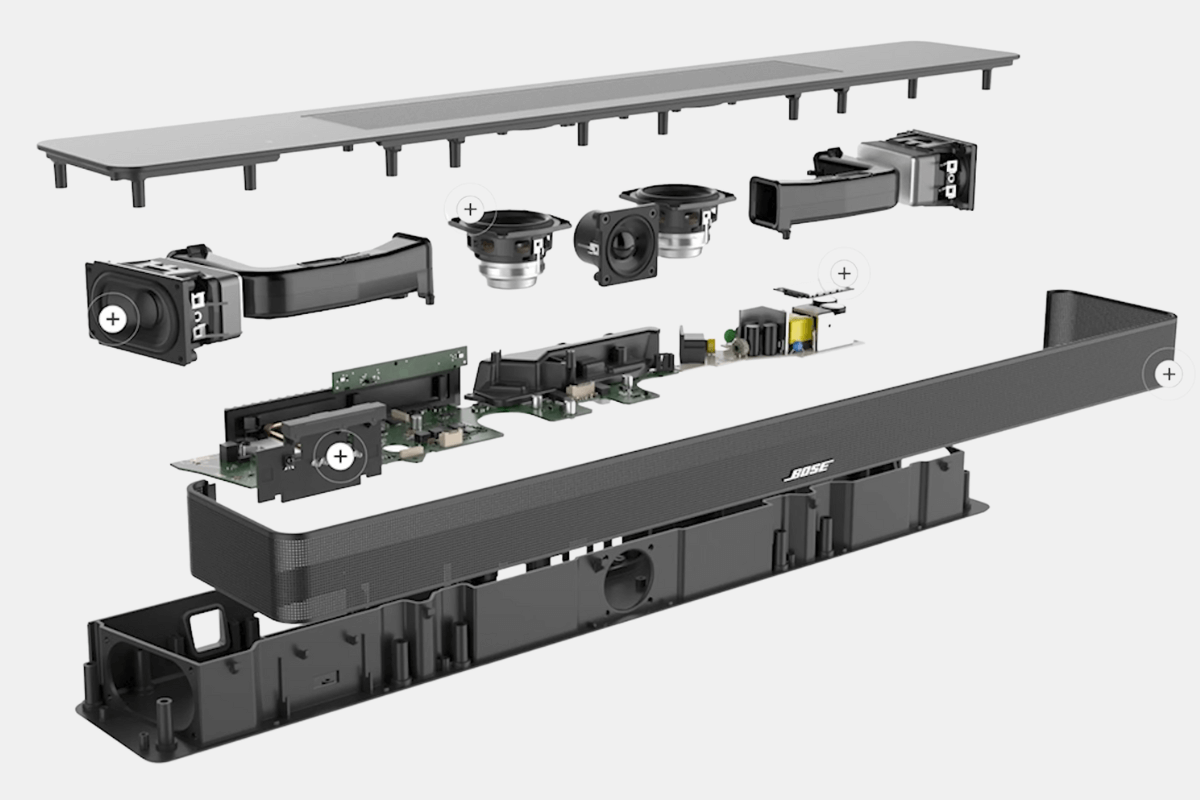 | 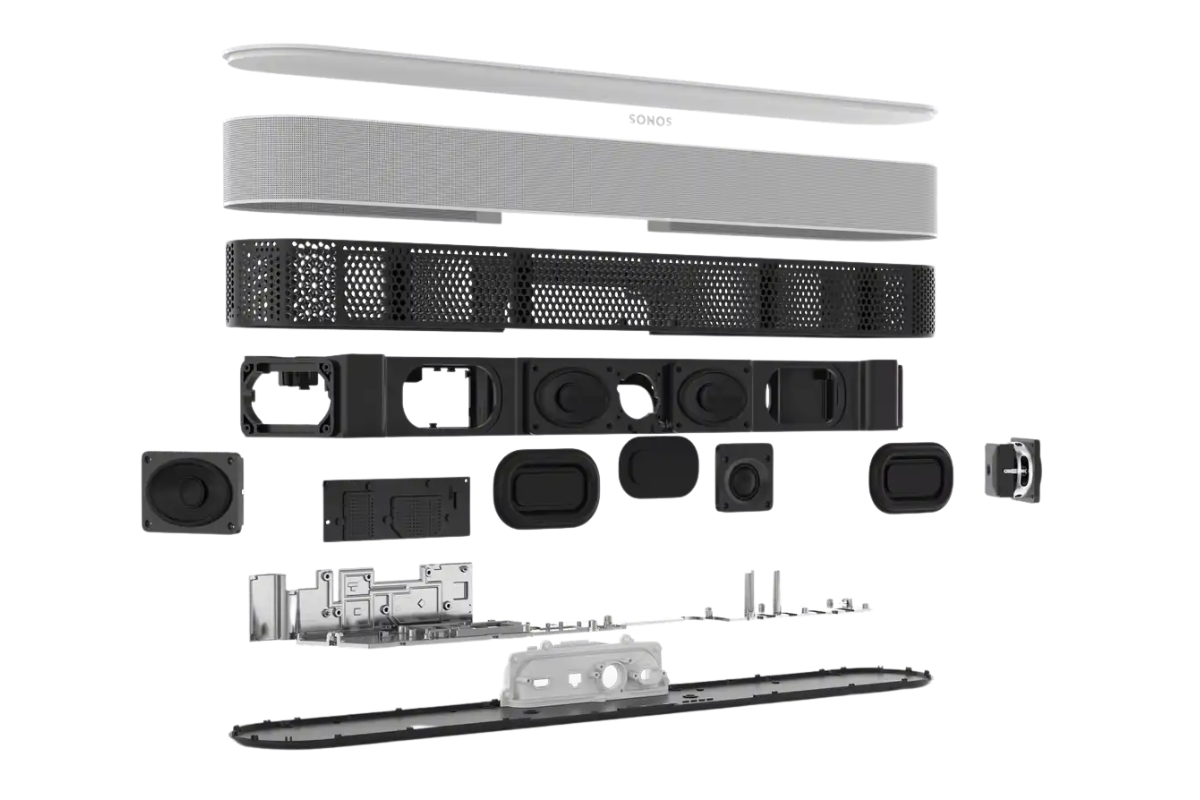 |
When it comes to internals, this is where we can notice one major difference between the two soundbars. While both are Dolby Atmos enabled, the height channels from the Sonos Beam (Gen 2) are simulated. Internally it has 4 front facing woofers, two angled outwards, and a dedicated centre tweeter but no dedicated up-firing speakers. Instead, it uses virtual processing and psychoacoustics to simulate height channels and provide separation between ear level and overhead level.
The Bose 600 on the other hand has 2 dedicated up-firing speakers to deliver the overhead effects in Dolby Atmos tracks which work alongside 2 sideways firing speakers and a front centre tweeter. Although we’re massive fans of the Beam and we think it does a brilliant job at simulating height effects. It will always struggle to compete with physical height speakers meaning the Bose 600 just edges it in this department.
Bose 600 vs Sonos BEam (Gen 2) Sound Performance
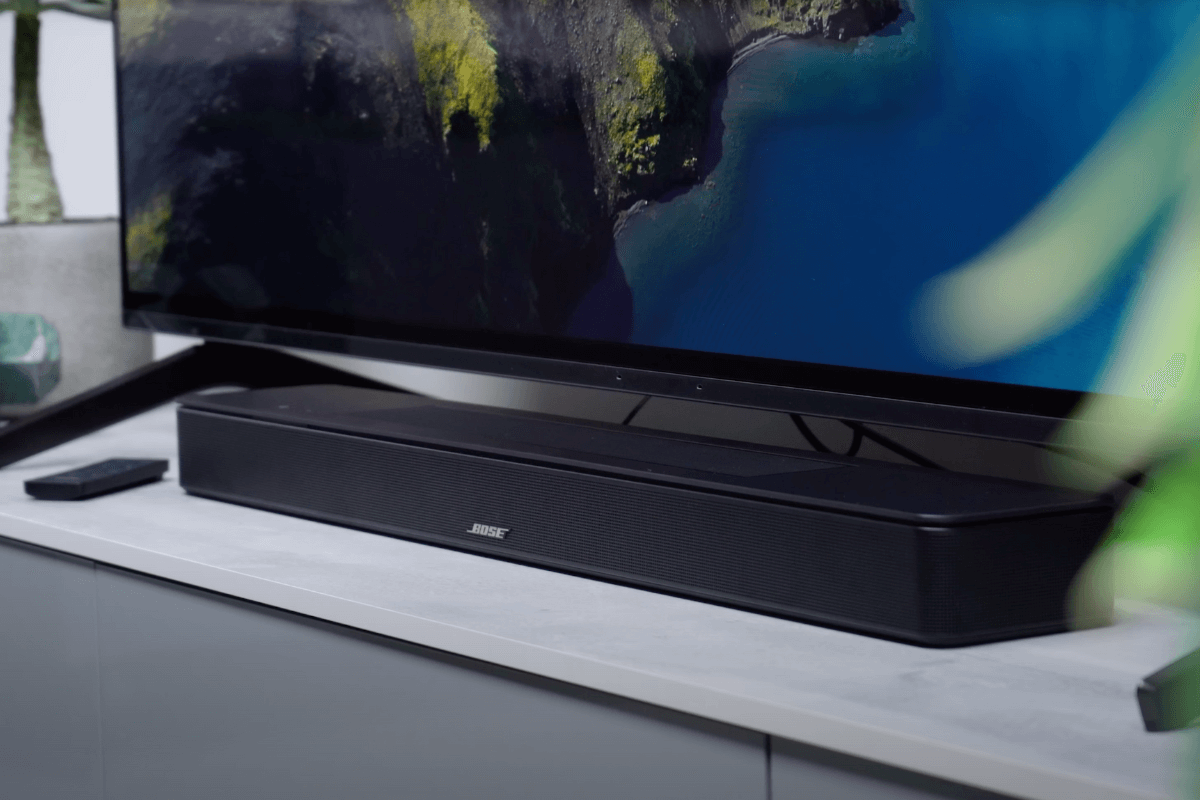 | 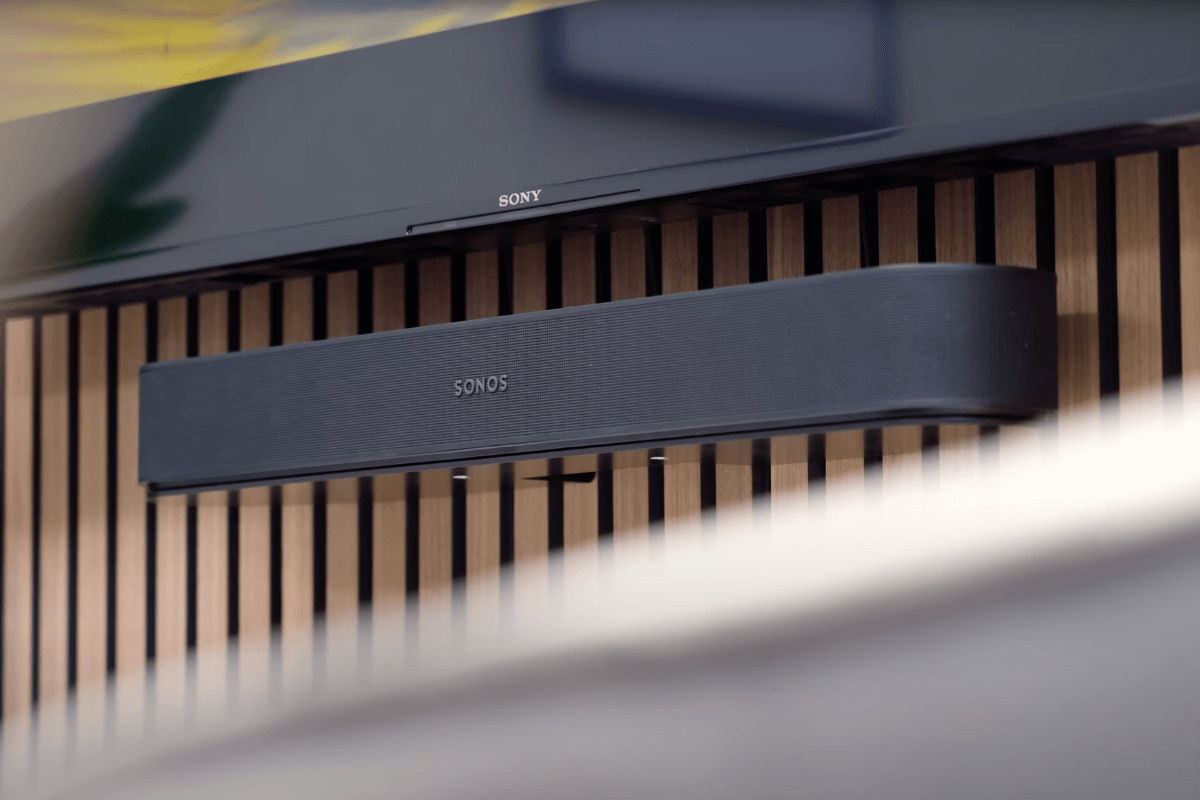 |
As always, we put both of these soundbars through their paces in a variety of different setups and locations to get a complete understanding of their optimum performance. Using an expanse of different audio content from movies, TV shows, music and gaming and it's no surprise that this was one of our most closely contested comparisons to date.
Without a doubt, both of these soundbars are guaranteed to be a huge improvement on any TV’s audio output alone. Both produce audio with a size-defying soundstage that expands far beyond their form factor. In terms of Dolby Atmos content, the upwards firing drivers on the Bose help to deliver an immersive audio experience that reaches a different dimension when compared with the Beam.
We were also left impressed by how well the Bose 600 handled complex scenes. When we watched Top Gun for example, any scenes that incorporated height channels and multiple layers were dealt with exceptionally well and didn’t feel overwhelming. The Bose also delivered impressively clean detailing that definitely enhanced our overall viewing experience.
However, the Sonos Beam(Gen 2) isn’t critically acclaimed without reason. Although it struggled to replicate the same overhead performance as the Bose with the lack of upward firing drivers, we would argue that the Beam outperformed the Bose when it came to vocals and bass performance. That’s not to say that these weren’t strong elements on the Bose but the Beam pushed further ahead in these areas for us. The Beam's vocals and centre channel clarity are simply phenomenal and they are this soundbar's standout features.
When it comes to low-end weight, if we’re looking at performance straight out of the box, the low end frequencies felt clean and punchy on the Beam and just offered an extra oomph that was lacking when listening with the Bose. However, you can tweak the bass performance on both soundbars using the app and we were able to replicate a similar low-end performance on the Bose 600 after playing around in the settings.
In terms of music performance, the Beam handles most genres well and offers balanced and punchy performance with the vocals being a standout feature yet again. The Bose 600 also coped well with a variety of different genres. Providing an accurate performance which retained nice separation of the layers throughout. However, we did notice a slight lack of meaningful bass which sometimes did take away from the overall performance.
Add-Ons
There is the ability to add optional modules like a subwoofer to both soundbars which is a great option for enhancing sound quality. So, if you’re planning on expanding your system further, the benefits of either ecosystem is definitely something you should consider.
Sonos prides itself on being a simple to use interface that makes adding additional units to your setup a seamless process. Meaning you can add a Sonos Sub (Gen 3) or Sonos Sub Mini and two Sonos One or One SL rears to this soundbar wirelessly with ease. The Bose ecosystem is less extensive but you do have the option to add a subwoofer and rears to this soundbar to expand your performance further. If you were to add the Bose Bass Module 500 you’re looking at an RRP of £949. So, £71 more expensive than the Sonos Beam and Sub Mini pairing (RRP £878). We would love to see how these setups stacked up against each other, but let us know if you’d like to see us test it out.
Sonos Beam & Sub Mini Bundle
Verdict
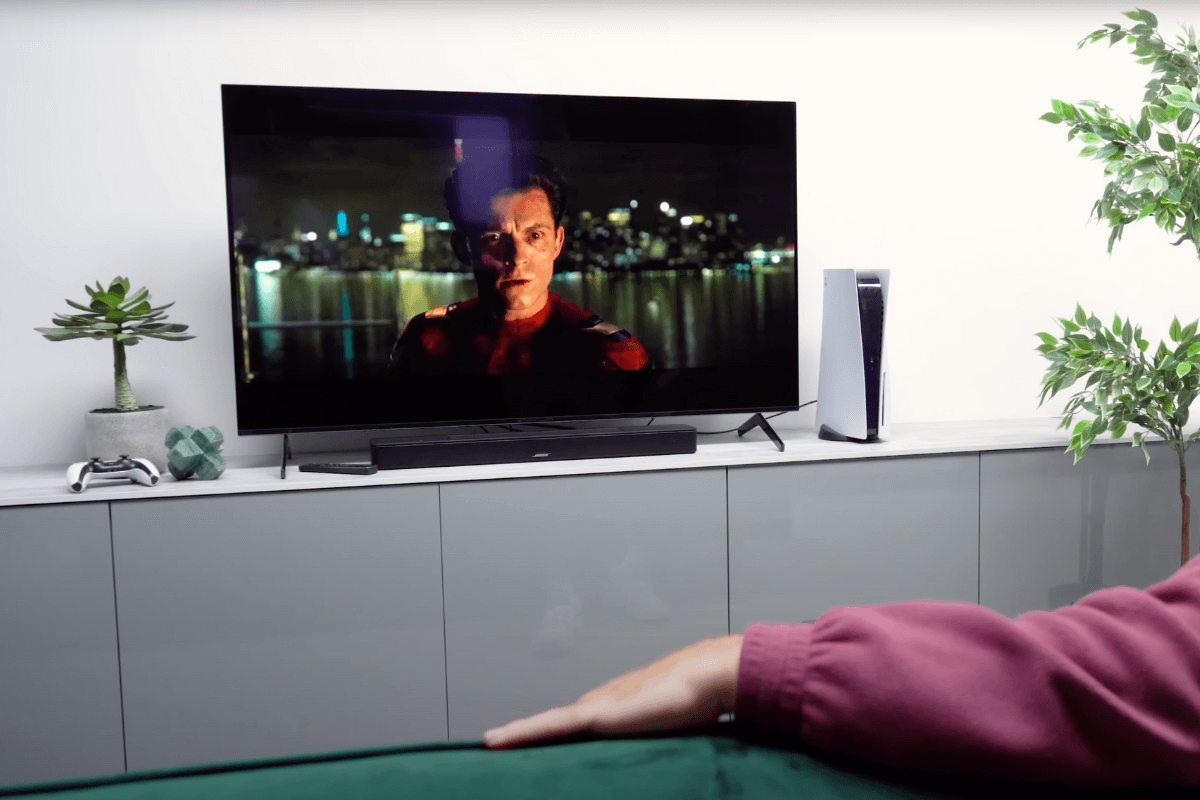 | 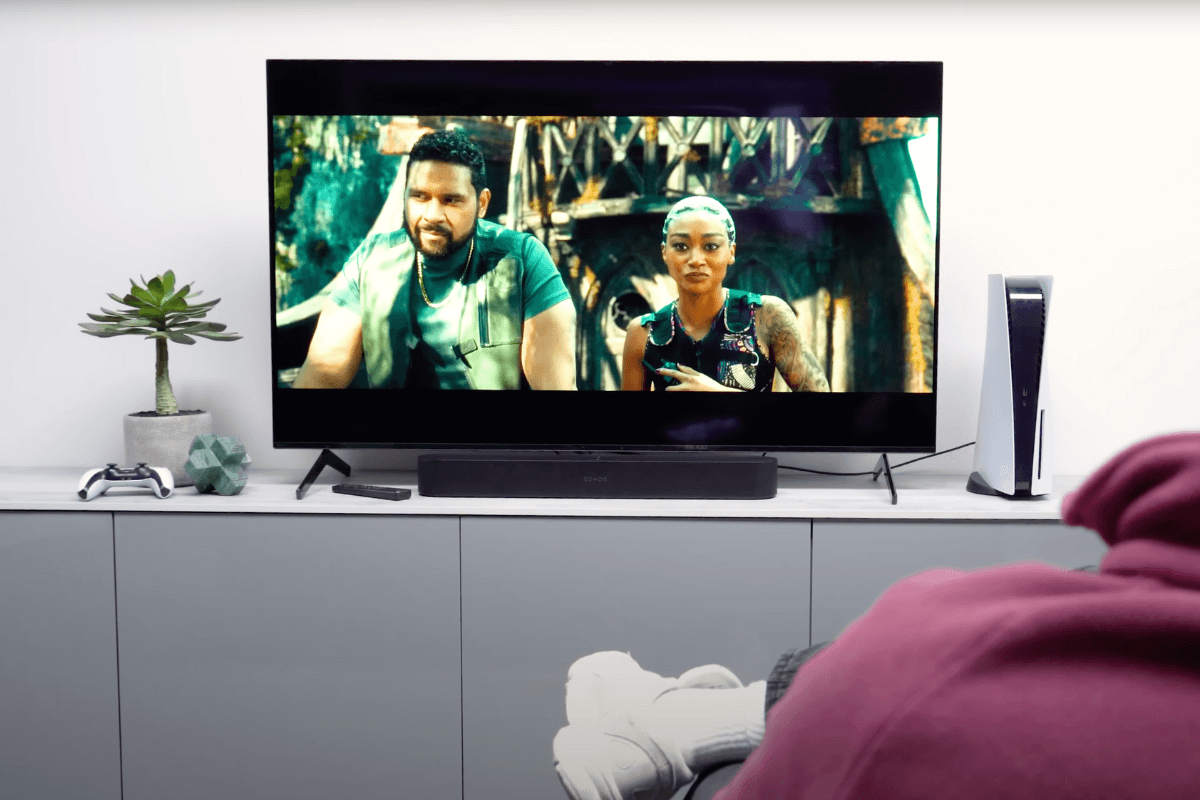 |
Taking everything into account, we have been left impressed by both soundbars and we think in their own right they’re great compact soundbar options that simply excel in different areas. The Bose 600 offers a great level of immersion and offers Bluetooth connectivity, which is something the Beam lacks. Admittedly, the Beam does offer better vocals and bass when it comes to layered Atmos soundtracks. But, what the Bose lacks here, it makes up for with its physical overhead channel. So it's a close call!
Both soundbars offer pros and cons and so for us, there can't be one standalone winner. What ticks all of one person’s box won’t be the same for the next person so it doesn’t feel right to say one is better than the other. But for those wanting to know which soundbar we would pick if we had to, the Sonos Beam (Gen 2) slightly edges it. The differences in design and overall ecosystem benefits are the key factors in our decision on this one. However, what might come out on top for us may not for you and that’s the beauty of choice.
Hopefully, this comparison has helped you gain a better understanding of whether the Bose Smart Soundbar 600 or the Sonos Beam (Gen 2) is a better option for your setup. If you would like more personal advice then feel free to reach out to our tech guides who would be more than happy to help!
| info@smarthomesounds.co.uk | |
 | Live Chat on our Website |
| 0800 677 1100 |
Find the perfect compact soundbar for your space
Sonos Era 100 vs Sonos One (Gen 2): Worth the upgrade?
Multi-room home audio specialist’s Sonos are renowned for their award-winning ecosystem with a range of the best soundbars, wireless speakers and portable speakers. The Sonos One (Gen 2) was a staple in their lineup, but 6 years on, Sonos have decided to discontinue it and release a replacement.
On the 28th March 2023, Sonos launched the Sonos Era speakers, marking a new generation of smart speakers for the brand. The Sonos Era 100 is an upgraded version of the Sonos One (Gen 2), bringing a refreshed design, upgraded bass, a second tweeter and Bluetooth connectivity. Sonos also launched their first ever Dolby Atmos speaker, the Sonos Era 300, which is a brand new entry into the Sonos lineup that sits between the Sonos Era 100 and Sonos Five in the range.
In this Sonos Era 100 vs Sonos One (Gen 2) comparison we’ll put both speakers head-to-head to help new and existing Sonos users see what improvements have been made and whether the upgrade is worth it.
If you’re new to Sonos and aren’t sure where to begin, check out our Complete Beginners Guide to Sonos or for more Sonos speaker recommendations, give our Best Sonos Speakers to Buy guide a read.
More: Sonos One and Sonos One SL Discontinued: What's Next?
Price & availability
The Sonos Era 100 comes with an increased RRP price of £249 (£50 more than the original RRP of the Sonos One Gen 2). However, when you consider the benefits of sound performance, features and design, we would argue its worth it.
It's worth knowing, despite being discontinued, there are still Sonos One (Gen 2) speakers available to purchase from various retailers - for now, at least! If you’re looking to grab a bargain on a Sonos speaker, this would be a great time to make the most of any last-minute deals. But be warned, although there will still be support for bug updates from Sonos, there won’t be any new features added anymore.
Why Buy From Smart Home Sounds?
We offer a Free 6 Year Extended Sonos Warranty and a Lowest Price Promise so if you spot any deals cheaper elsewhere, get in touch and we will match on a like-for-like basis.
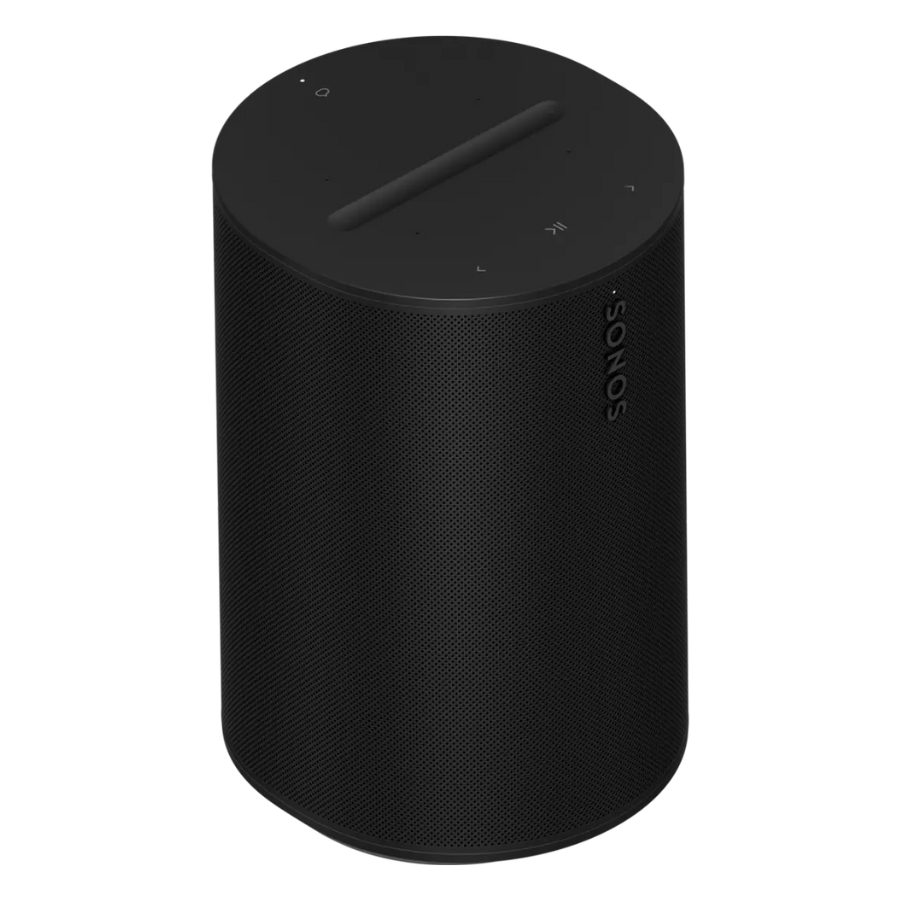 |
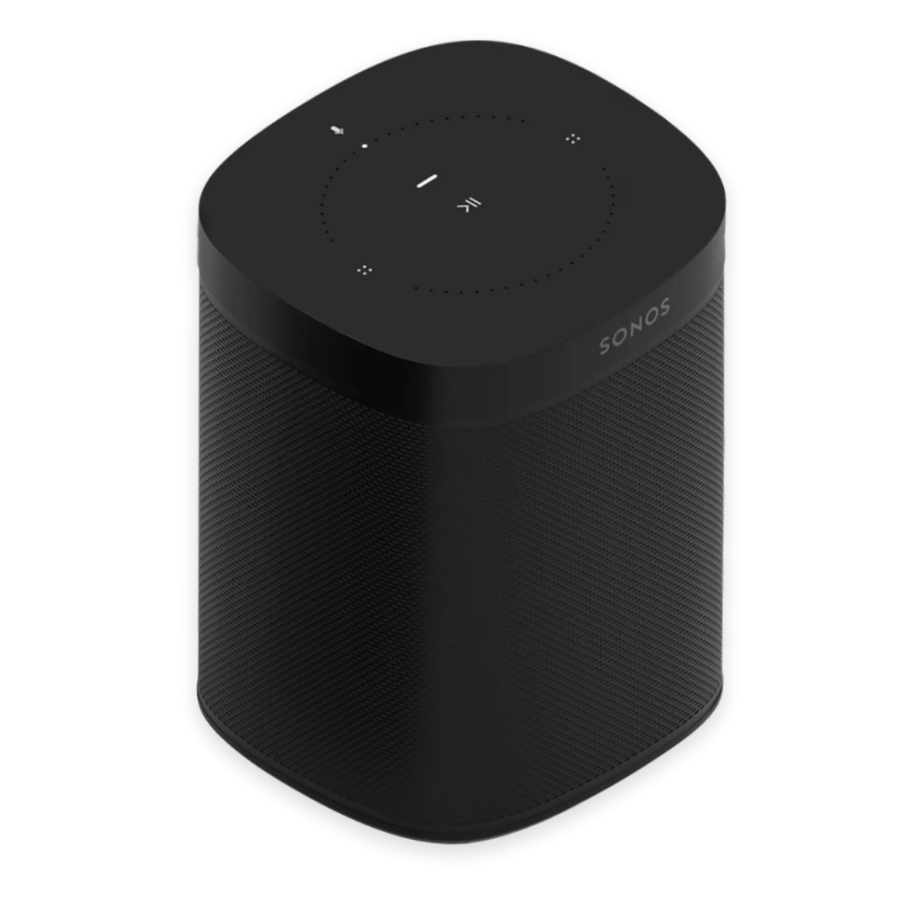 |
| Sonos Era 100
RRP £249 (see latest pricing) View Sonos Era 100 |
Sonos One (Gen 2) RRP £199 (see latest pricing) View Sonos One (Gen 2) |
Pros and cons
| Sonos Era 100 | Sonos One (Gen 2) |
| ✅ Immersive stereo sound with deeper
✅ More connectivity options with both WiFi 6 & Bluetooth 5.0 ✅ Line-in connection for an external audio source |
✅ More affordable entry into the Sonos ecosystem
✅ Support for Google Assistant voice control |
| ❌ More expensive than the Sonos One (Gen 2)
❌ No Google Assistant ❌ No Sonosnet |
❌ No bluetooth or line-in |
Design
In this Sonos Era 100 vs Sonos One (Gen 2) comparison, when it comes to design, both the Era 100 and One (Gen 2) offer a similar footprint and compact size.
Sonos have refreshed their design in more recent years to a more modern, sleek approach and the more curved shape and wraparound grille of the Era 100 provides a more aesthetic appearance. It's worth knowing both Sonos speakers are available in a choice of black or white to suit your space.
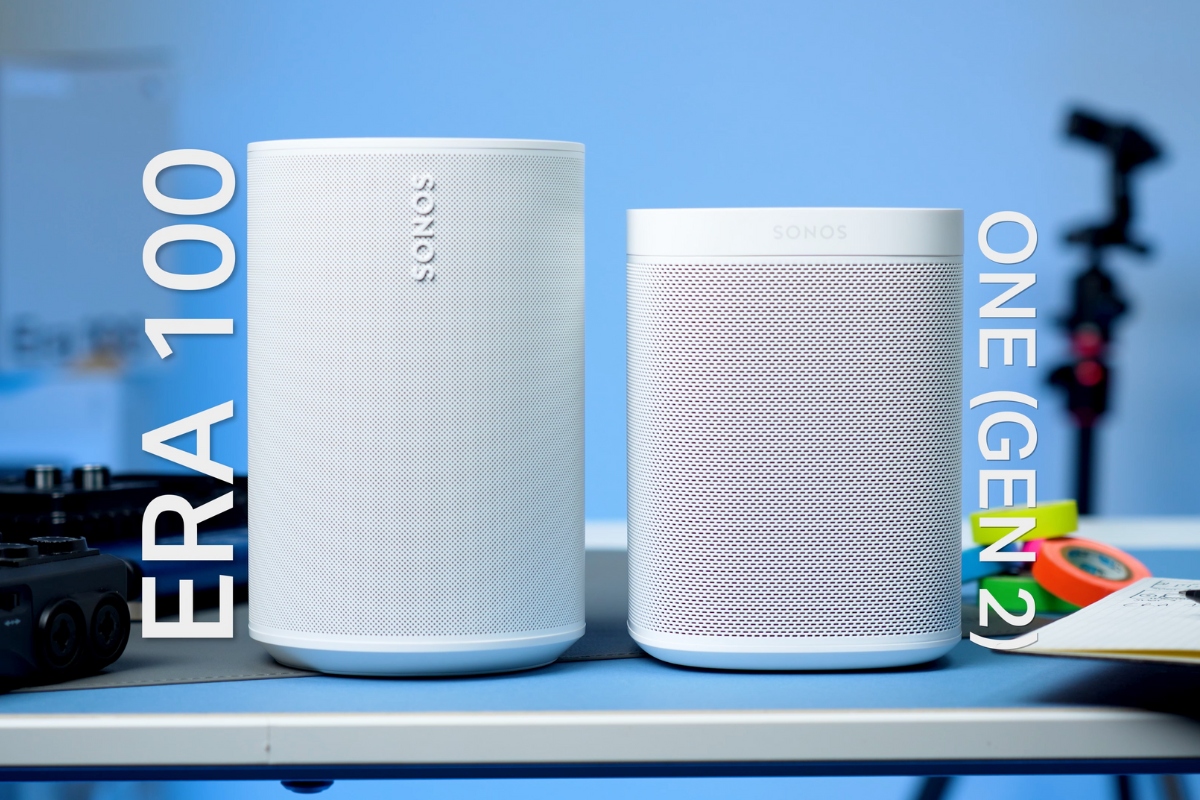
Measuring 7.18in tall, 4.72in wide and 5.14in deep, the Era 100 is slightly taller and deeper than the Sonos One (Gen 2) coming in at 6.36in tall, 4.69in wide and 4.69in deep.
Both speakers provide versatile placement options in nearly any space, and they are both humidity resistant, allowing for use in a kitchen or even in a covered outdoor area.
A notable update on the Sonos Era 100 is the redesigned top panel controls. While maintaining similar playback controls, Sonos has replaced the volume controls with an indented volume slider groove. This modification enhances intuitive volume control, making it easier to select and adjust the desired volume with precision.
Internals
The Sonos Era 100 features enhanced internals to provide an upgraded sound performance over the Sonos One (Gen 2). Inside, there is one mid-woofer that is 25% larger than the woofer in the One for better mid-range vocals and deeper bass. The Era 100 is also now a stereo speaker thanks to a dual tweeter setup with two angled tweeters which deliver the high frequencies and stereo separation. There are three Class-D digital amplifiers powering the speakers and custom waveguides which help further disperse sound.
In comparison, the Sonos One (Gen 2) features a single tweeter for the high-frequencies and one midwoofer for the mid-range and low-end. There are two Class-D digital amplifiers in the One.
Connectivity
The Sonos Era 100 also features new and improved connectivity options making this a much more versatile speaker. We still have WiFi on this speaker but it’s been upgraded to WiFi 6 which will give better pass through when connected to a WiFi 6 router and future proofs the speaker for potential updates down the line.
Like the Sonos One (Gen 2), the Era 100 also boasts Airplay 2, Spotify Connect and voice control via either Sonos Voice or Amazon Alexa. One key difference is that the Era 100 does not offer support for Google Assistant due to ongoing issues between the brands so if you use Google Assistant, the One (Gen 2) is a safer option.
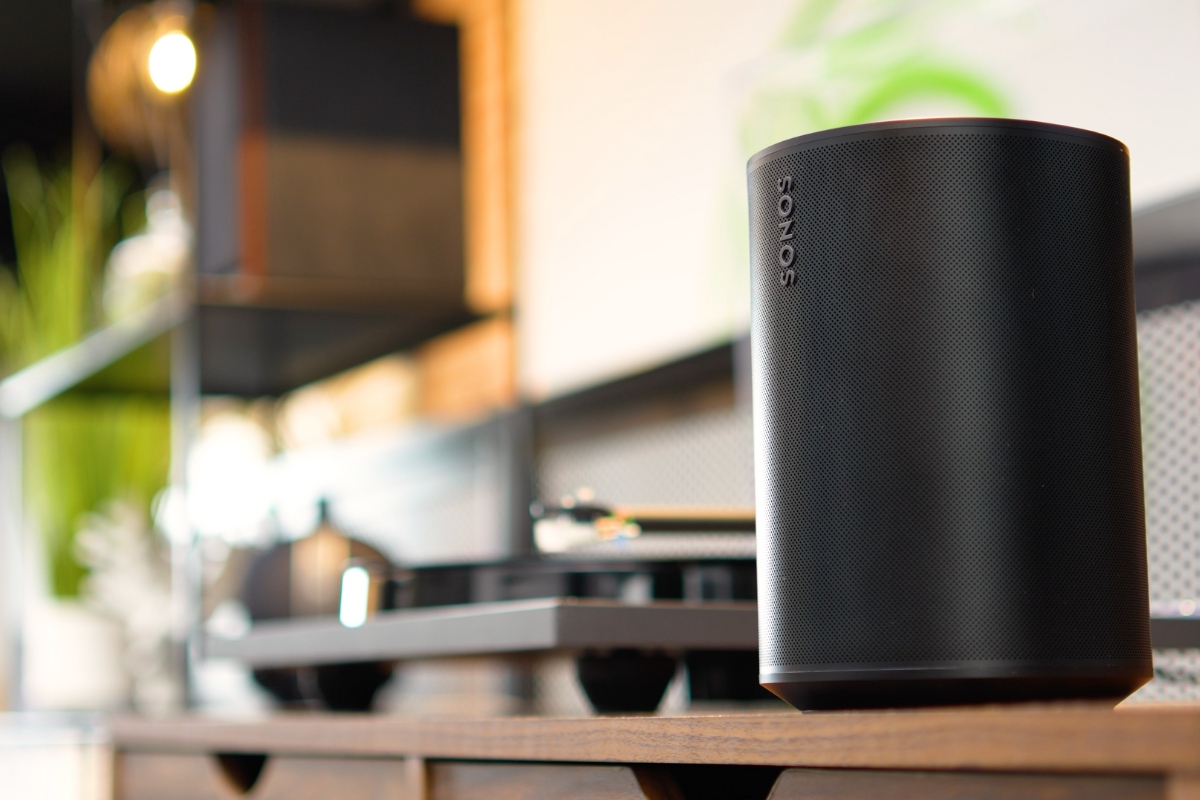
In other big news, Sonos have added Bluetooth 5.0 connectivity to the Sonos Era 100. You do need to set the speaker up on the Sonos S2 app via WiFi first but you can then connect to a Bluetooth device for control. Bluetooth has been a long requested addition to Sonos’ smart speakers and it appears the demand has been high enough to add it to their new range of speakers. One benefit is that, once the Era 100 is paired via Bluetooth, it can be used as a gateway to stream the audio to other Sonos speakers around your home.
Another key differentiator with the Sonos Era 100 is the addition of a USB-C line-in port. You can purchase a separate Sonos dongle to use the USB-C port for connecting to an external audio source such as a turntable. This setup would be the most affordable solution for adding a turntable into your Sonos setup and you can then send the audio around the rest of your Sonos speakers.
Note: both Bluetooth and the line-in connection are disabled when the Era 100 is used as rear surrounds in a Sonos home cinema setup.
Trueplay tuning
Both the Sonos Era 100 and Sonos One (Gen 2) support Trueplay Tuning, Sonos’ room correction software. This feature measures the speaker's surroundings and adjusts the acoustic performance to ensure the speaker sounds best in your space.
However, you must use an iOS device to perform Trueplay on the Sonos One (Gen 2). The Sonos Era 100 offers 2 options for Trueplay. Advanced Trueplay requires an iOS device and is the most effective option. But Android users now have the choice to use Quick Tuning which utilises the microphones in the speaker.
Is the Sonos Era 100 more energy efficient than the Sonos One (Gen 2)
In a move to make the Era 100 more sustainable, Sonos have used less virgin plastics and more screws instead of glue. They have also made the packaging 100% recyclable.
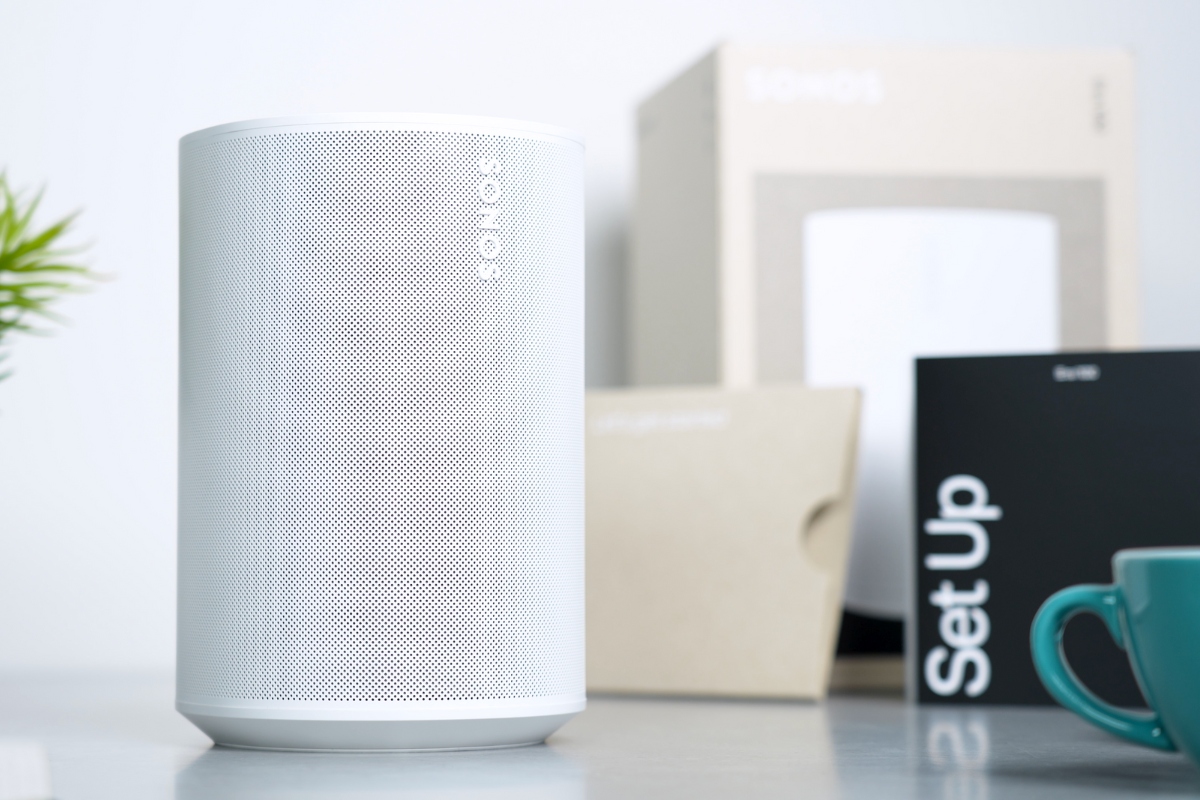
In an upgrade from the Sonos One (Gen 2), Sonos claim the Era 100 is also more energy efficient both when playing and when idle. We put this to the test and found that, when playing music at 50% volume, the Era 100 and One (Gen 2) speakers used similar power (between 5 and 10 watts). This costs around 7p per day if you were to have them playing at that volume for 24 hours.
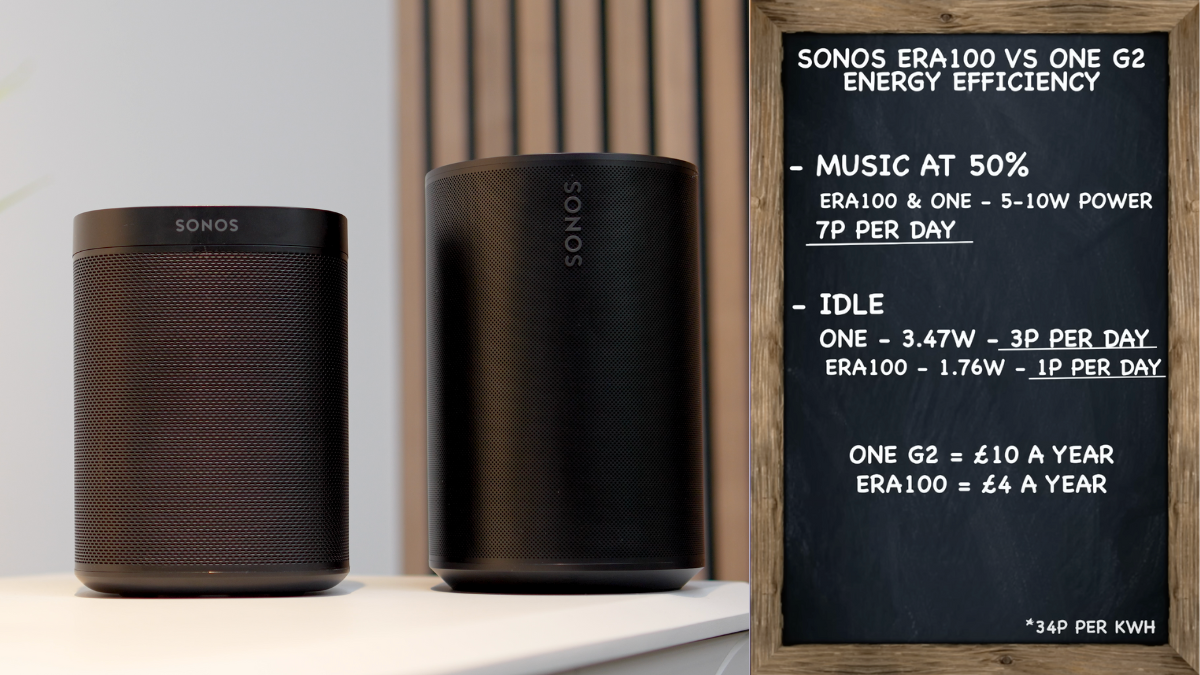
However, there’s a notable difference when the speakers are idle, which for most of us is the majority of the time. The Sonos One (Gen 2) used 3.47 watts which works out around 3p per day whereas the Era 100 used around 1.76 watts, around 1p per day. So over a year, you’re looking at £10 for the Sonos One compared with £4 for the Era 100. For reference these figures are based on 34p per kwh.
Sound - single and stereo pair
What have we found in our Sonos Era 100 vs Sonos One (Gen 2) sound test? First things first, we’ve always been big fans of the sound performance of the One. It’s a well balanced sound and the vocals and details are good. But the bass could be better and it’s a fairly directional speaker.
The Sonos Era 100 provides a notable upgrade in performance, as hinted at by the new acoustics. There is instantly more powerful, deeper bass and a wider performance thanks to the stereo sound presentation. We found it gave a richer, livelier performance and it almost feels like you get another layer onto your audio with this speaker.
The bass is nice and tight and there is good separation between different elements of the track. The balance of sound is slightly different and the vocals feel like they are set better within the overall performance of the 100 rather than projected forwards more in the One.
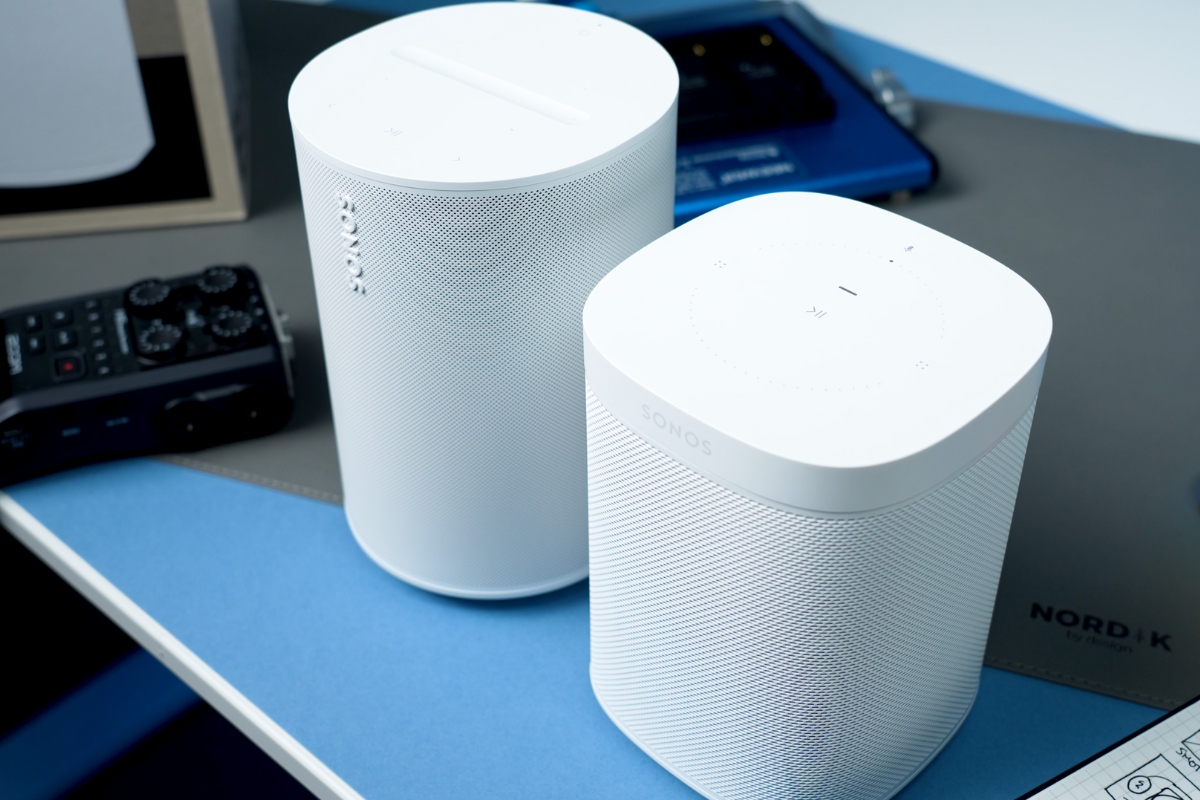
When comparing the stereo performance of a pair of Sonos Era 100 speakers vs a pair of Sonos One (Gen 2) speakers, again the bass and separation is notably improved. Two Era 100s provide a more immersive experience for your audio and is probably worth the additional budget.
As rears
Both the Sonos Era 100 and Sonos One (Gen 2) speakers can be used as surround sound rears to a Sonos soundbar so long as it’s on the Sonos S2 app. That includes the Sonos Arc, Sonos Beam (Gen 2) and Sonos Ray as well as the (now discontinued) Sonos Playbar and Playbase.
Overall the Era 100 offers a more expansive rear surround performance. One of the most notable changes was when there was a bass heavy effect coming from behind you. A good example is a scene in James Bond No Time To Die when they are being shot at in the car. The shots coming from behind you have more weight in them which gives more impact to the scene.
I think if you’re looking for the best upgrade for a Sonos soundbar then yes, the Era 100s are a more powerful addition and are a great pair of surround sound rears. However, if you already have Sonos One or Sonos One SL rears and are considering upgrading then I don’t think you’ll get enough of an upgrade for an additional £500.
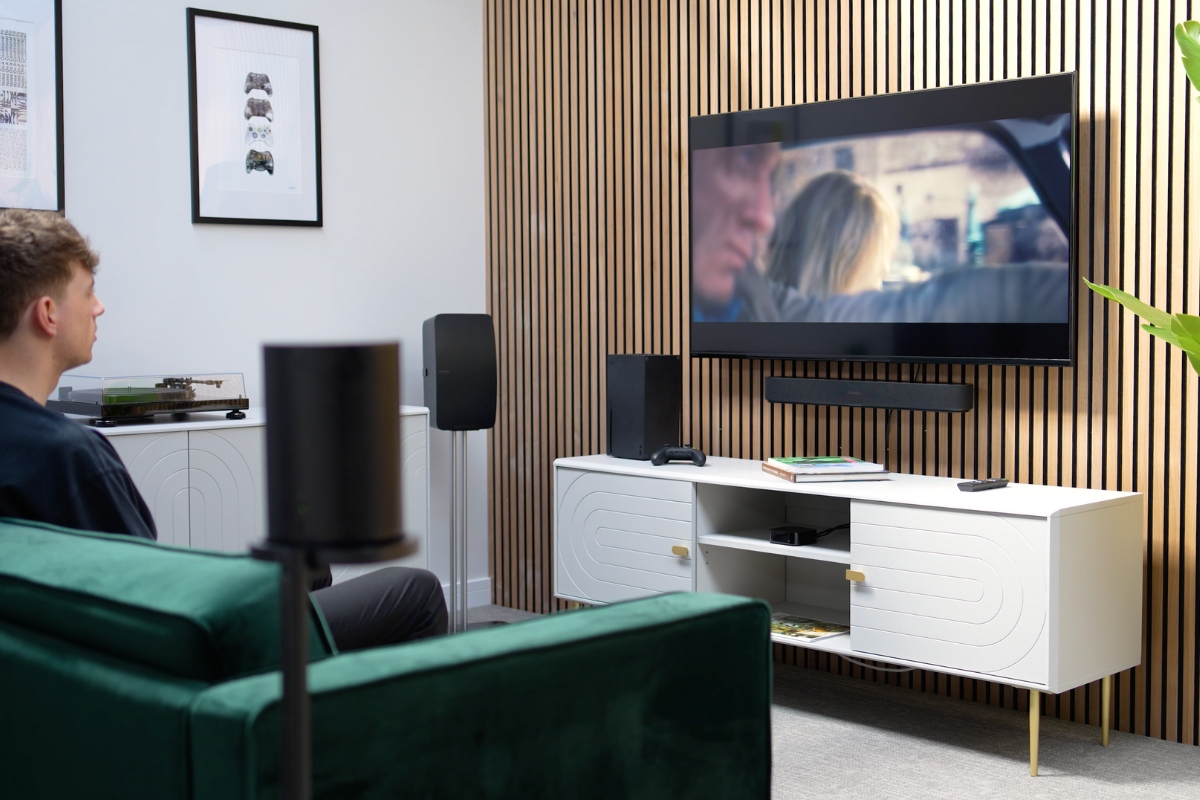
If you have the option to move your current rears to a different zone in your home then that would be a good solution. For those looking to upgrade their existing setup, then adding a Sonos Sub Mini for £429 would have more of an instant impact.
Is it Worth upgrading?
From our testing and our review of the Sonos Era 100 vs Sonos One (Gen 2), we would say now is a great time to be considering either of these speakers as you have the option to get a great deal on the Sonos One (Gen 2) or access the upgraded performance of the Sonos Era 100.
For those coming in fresh, you will need to weigh up what you’re looking for. If you’d benefit from the additional connectivity options such as Bluetooth or line-in, are looking for the best sound performance for your budget and would appreciate the more modern design then the Sonos Era 100 is the way to go.
If you aren’t bothered by the new upgrades, are looking for Google Assistant connectivity, don’t mind the slightly more dated appearance and are looking for the best deal then the Sonos One (Gen 2) might be the better solution.
For existing Sonos One (Gen 2) owners wondering if the Era 100 is worth the upgrade then it will depend on your usage and whether you would benefit from having an additional Sonos zone in your home. After all, it’s not a replacement but an opportunity to do a “speaker shuffle” and add extra zones of audio into your home.
I think if you like the performance of the Sonos One (Gen 2), you’ll love the enhancements to the performance of the Era 100 and, if budget allows, it would be a great addition to most Sonos homes.
View Sonos Era 100 |
View Sonos One (Gen 2) |
Learn More
Read Sonos Era 300 Review: The Ultimate Dolby Atmos Speaker?
Read Sonos Era 100 Review: Truly Impressive Stereo Sound
Read Sonos New Products 2023: Sonos News
If we can help any further, please reach out using one of the channels below:
| info@smarthomesounds.co.uk | |
| Live Chat on our Website | |
| 0800 677 1100 |
We put the Sonos Era 100 and Sonos One (Gen 2) head-to-head to find out what’s the difference and which smart speaker you should buy.
Sonos Era 300 Review - is this the future of audio?
Following the announcement of the first ever Sonos Dolby Atmos Speaker, we have been eagerly waiting to get our hands on the all-new Sonos Era 300. Over the past few months, we’ve been testing this speaker out, putting it through its paces to create this Sonos Era 300 review and comparing it with the current Sonos Wireless Speaker lineup to see how it stands out. For our full list of our Sonos speaker recommendations, check out our Best Sonos Speakers to Buy guide.
The Sonos Era 300 is a brand new entry into the Sonos lineup and one of their most premium smart speaker options. With 6 speakers firing sound to the front, sides and upwards, Era 300 delivers impressive Dolby Atmos sound and a wide soundstage for a room-filling performance.
It offers extended connectivity including WiFi 6, Bluetooth 5.0, Voice control with Amazon Alexa or Sonos Voice, AirPlay 2 and a USB-C line-in for external audio sources. Use standalone, as a stereo pair, as rears to a Dolby Atmos Sonos soundbar or group with other Sonos speakers for an extensive multi-room home audio system.
Not much of a reader? Watch our Sonos Era 300 Review on YouTube instead.
There is a lot to cover in this review so if you’re looking for a specific answer, use the links below to skip ahead!
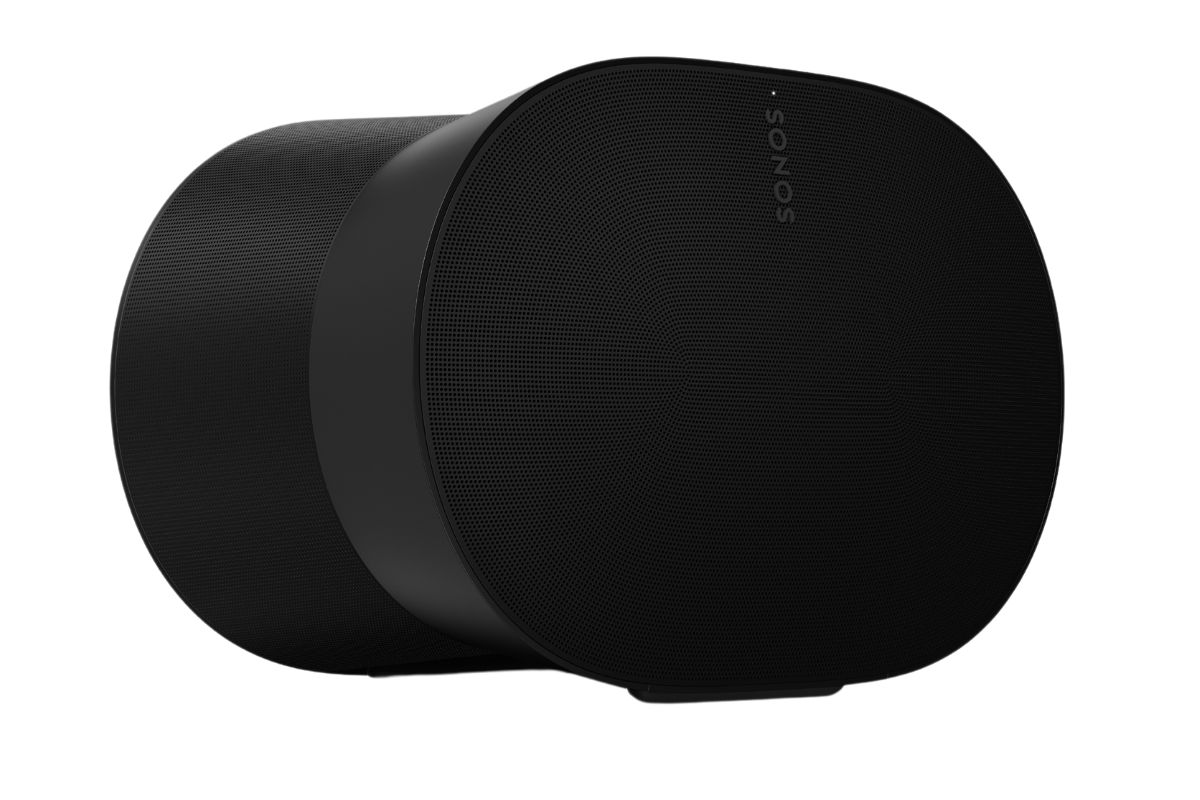
Sonos Era 300
RRP £449 (see latest pricing)
View Sonos Era 300
Sonos Era 300 Pros & Cons
| Sonos Era 300 Pros | Sonos Era 300 Cons |
| ✅ Immersive Dolby Atmos performance for music or movies
✅ WiFi 6 + Bluetooth 5.0 connectivity ✅ Sleek, premium design ✅ Line-in connectivity |
❌ No support for Google Assistant
❌ No Sonosnet ❌ Bluetooth & line-in disabled when used as rears |
Sonos Era 300 Price & Release Date
The Sonos Era 300 released on the 28th March 2023, retails for £449 putting it at the top end of the Sonos wireless speaker range, sitting just below their premium Sonos Five speaker.
Sonos Era 300 Design
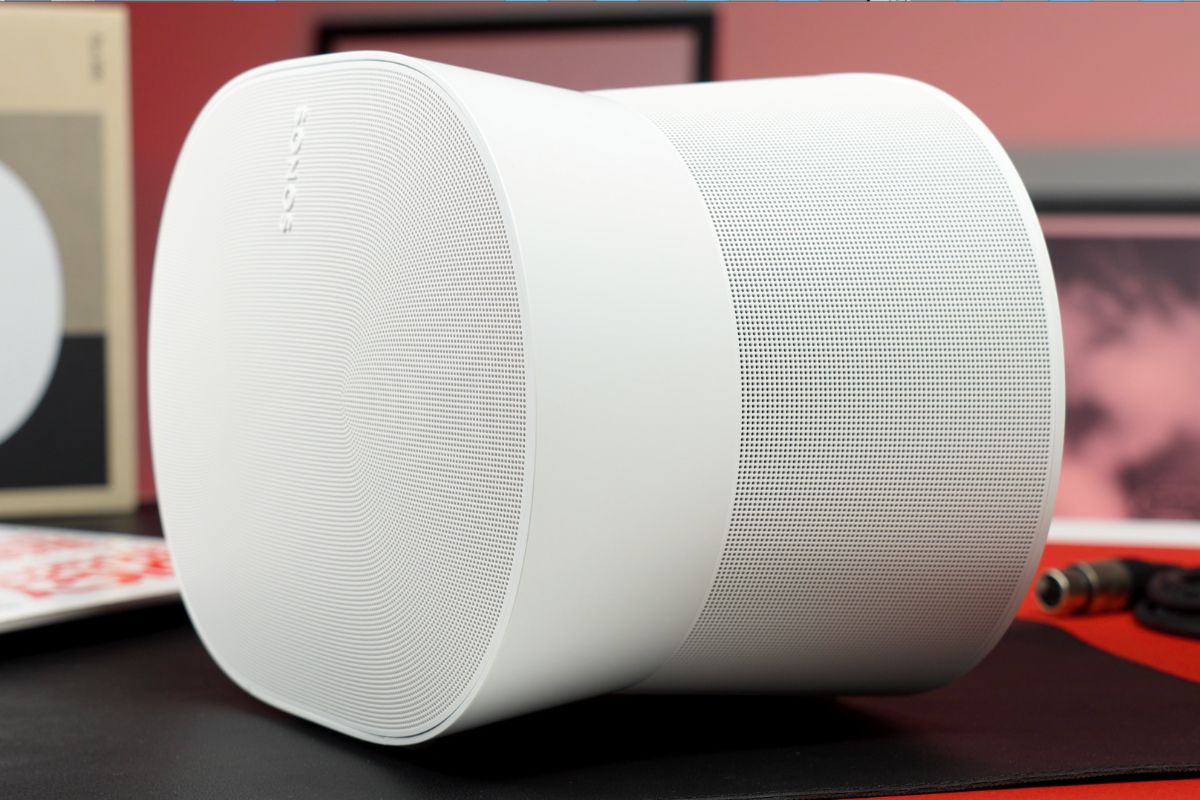 |
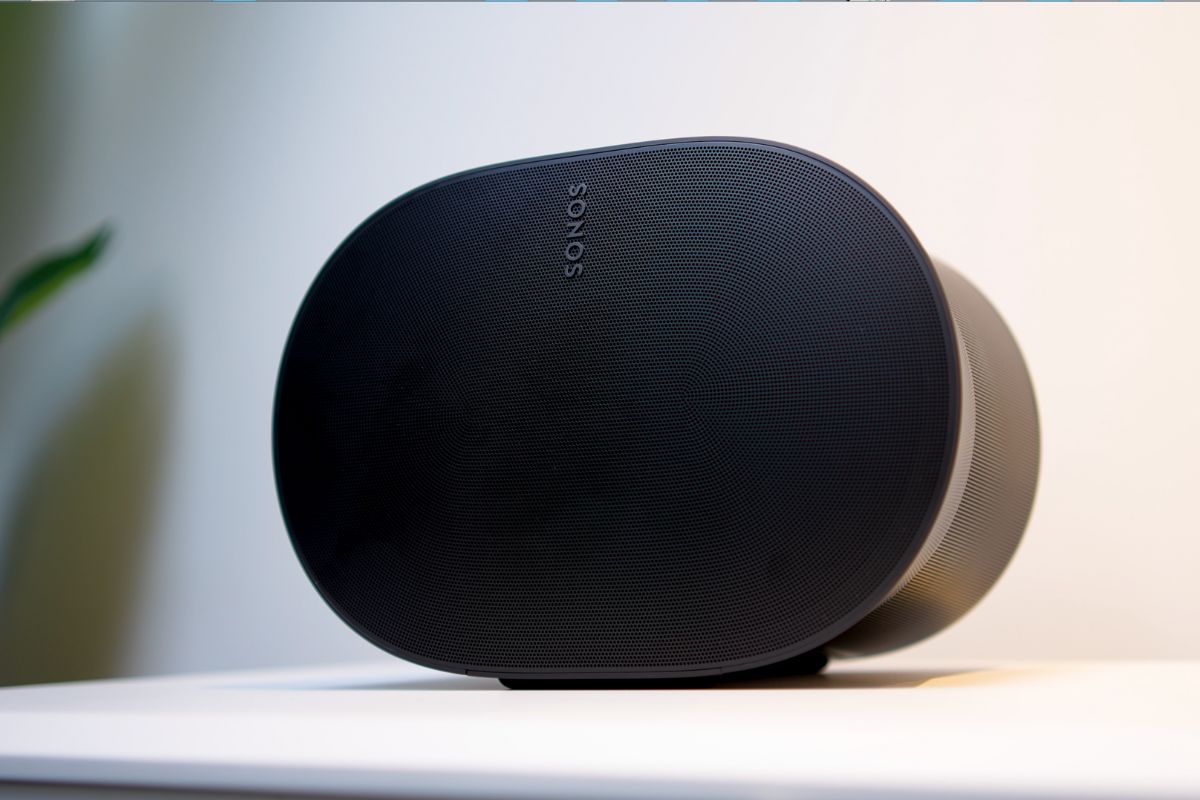 |
The Era 300 is definitely a unique looking speaker and unlike anything we’ve tested before. Initially, the shape is unusual but after a day or two we've warmed to the appearance.
For size context, the Era 300 is smaller than the Sonos Five and larger than the Sonos One (Gen 2), sitting roughly in the middle. From the front, the rounded shape helps it blend into your space and you can opt for a black or white version to suit your home’s aesthetics.
One thing worth highlighting is that these will look more prominent when on floor stands behind a sofa if you opt to use a pair of Era 300s as rears in a home cinema setup. The Sonos Floor Stands for Era 300 place the speakers at the optimum listening height which is slightly higher than the Sonos One (Gen 2).
On the top, there are handy touch controls and a new intuitive volume slider which works well. It’s quick to select a certain volume and if you swipe from left to right, you get a 30% increase in volume.
Sonos Era 300 Internals
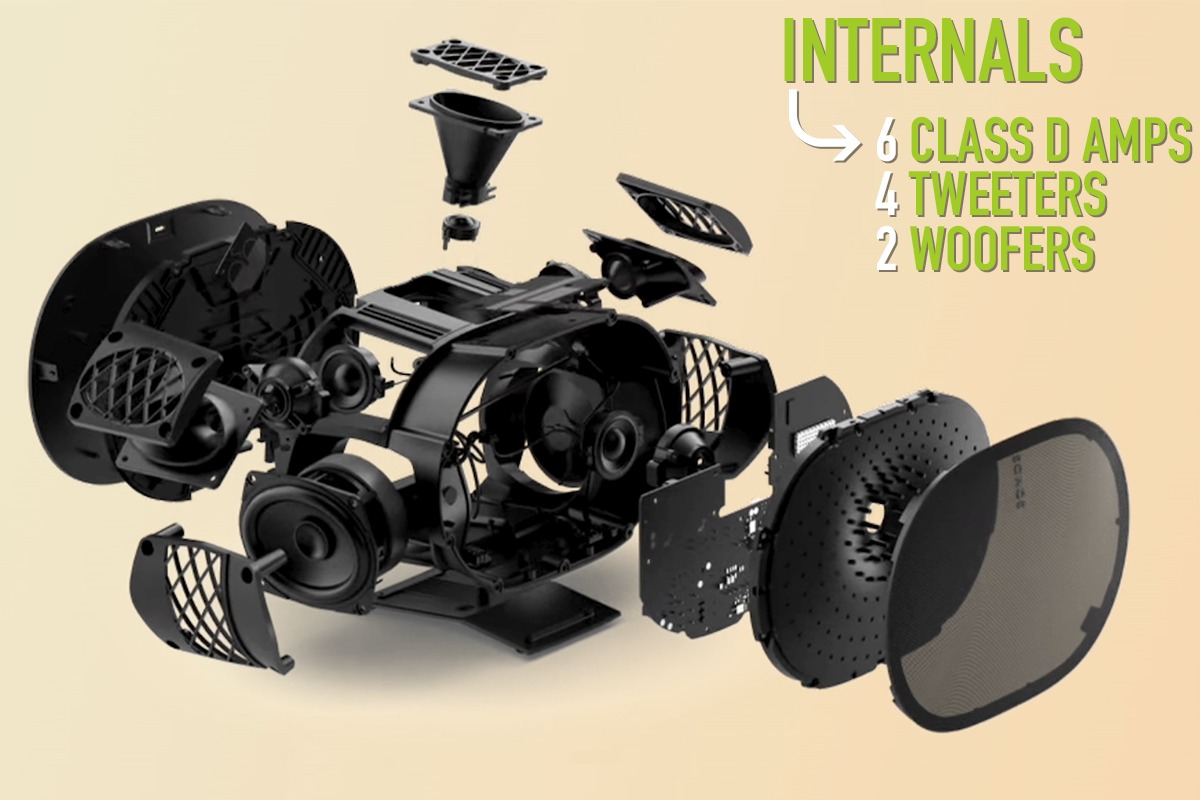
Inside the Era 300, we’ve got a pretty unique speaker makeup. There are a total of 6 class-d amplifiers powering 4 tweeters and 2 woofers. We’ve got one mid tweeter at the front that provides the centre image and covers the vocals and lead instruments. On the sides, there are two sideways firing mid tweeters and two woofers for the bass and these all work to improve the stereo separation.
Finally, there’s one upwards-firing tweeter on the top which is angled around 10 degrees forward and that bounces the sound off your ceiling to deliver those height channels in Dolby Atmos content. This means that this speaker can deliver atmos effects from a standalone unit which I think is a first.
Where should you place the Sonos Era 300?
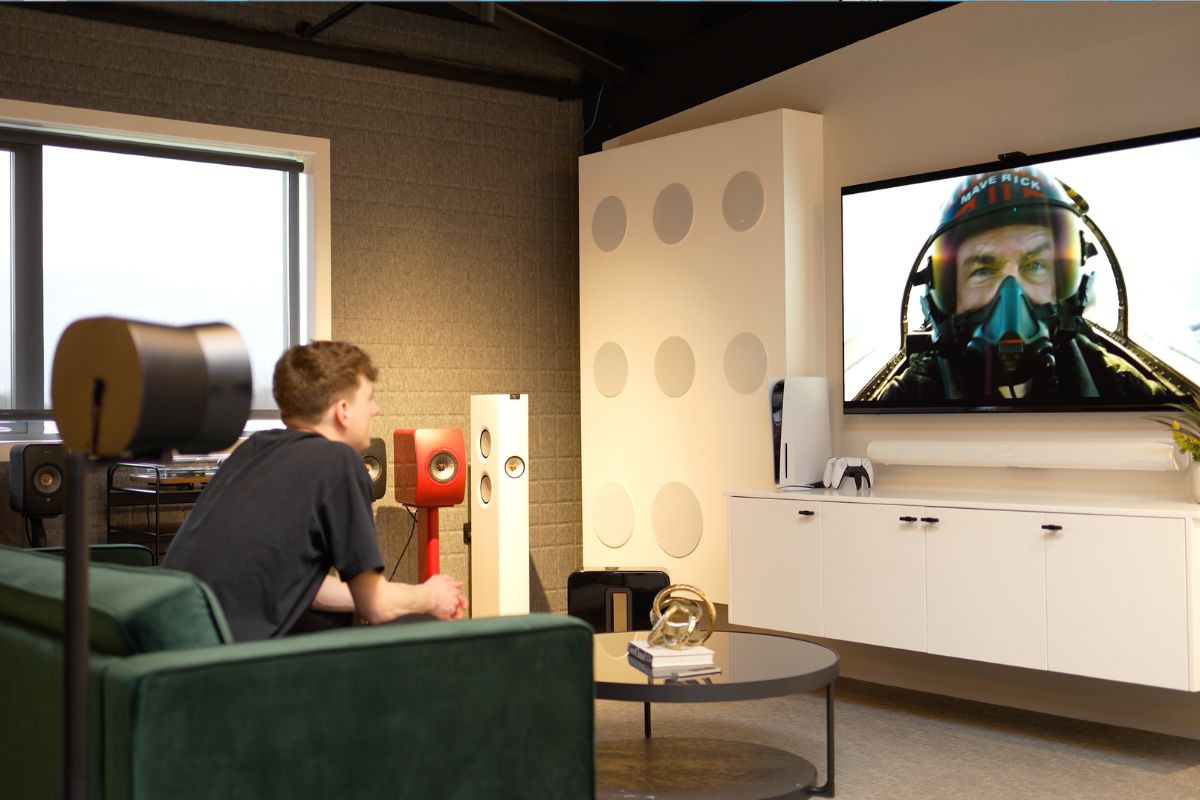 |
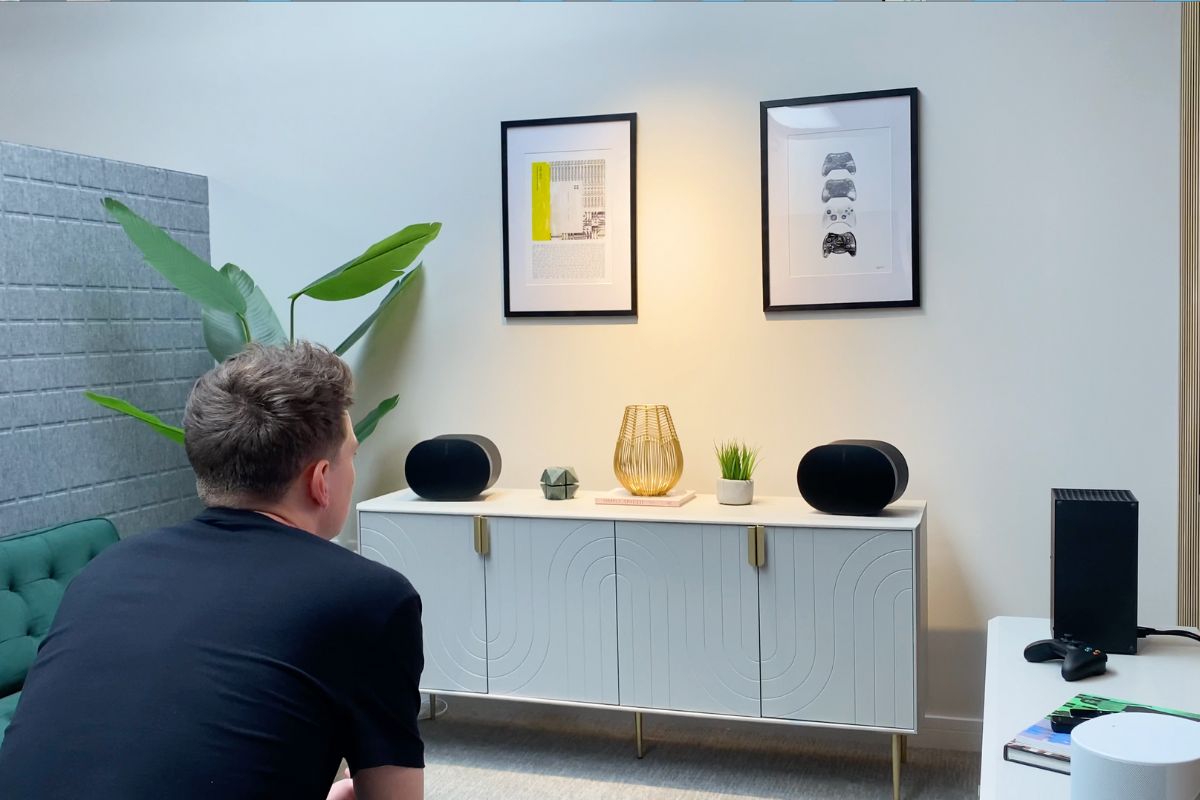 |
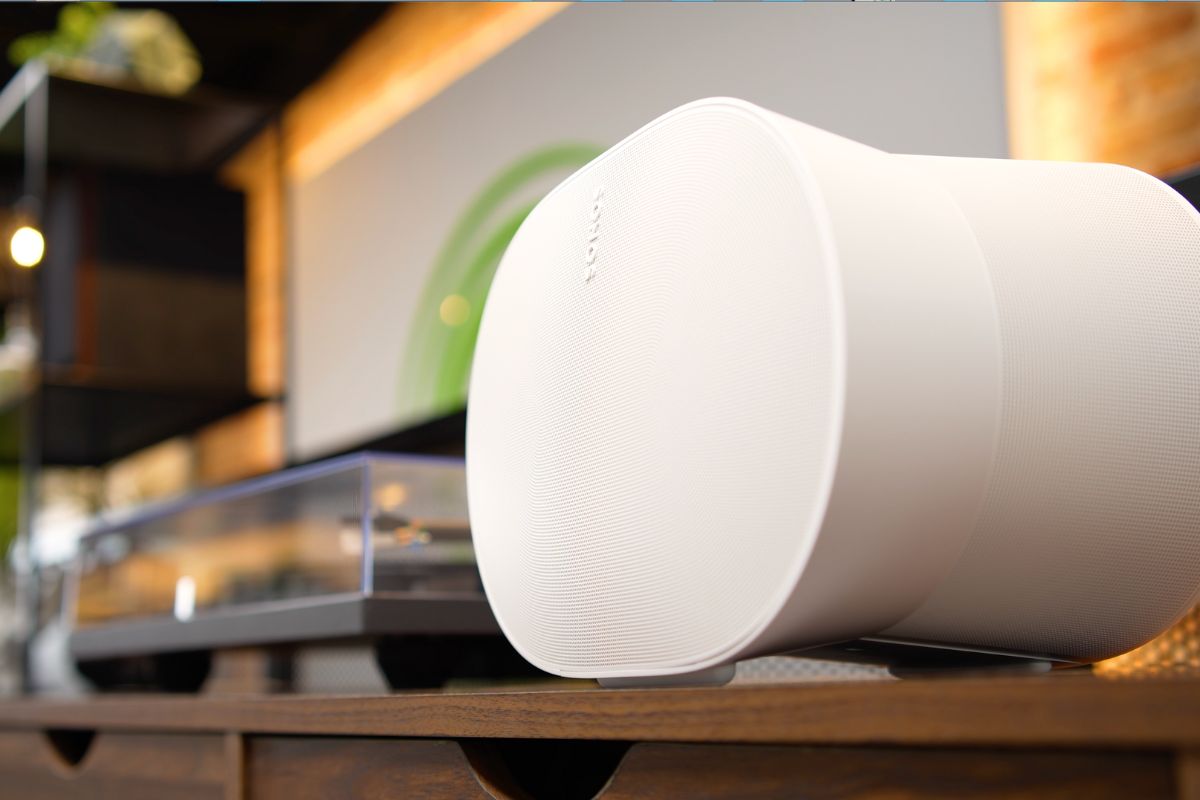 |
One thing to take into consideration is the placement of the Era 300. Sonos are recommending you allow at least 2 foot of clearance above the speaker and 8 inches on the sides. Avoid placing the Era 300 within a bookshelf as this will impact the performance.
If you plan on wall mounting the Sonos Era 300 close to your ceiling, turn the speaker upside down to avoid impacting performance.
How have Sonos improved the energy efficiency of the Sonos Era 300?
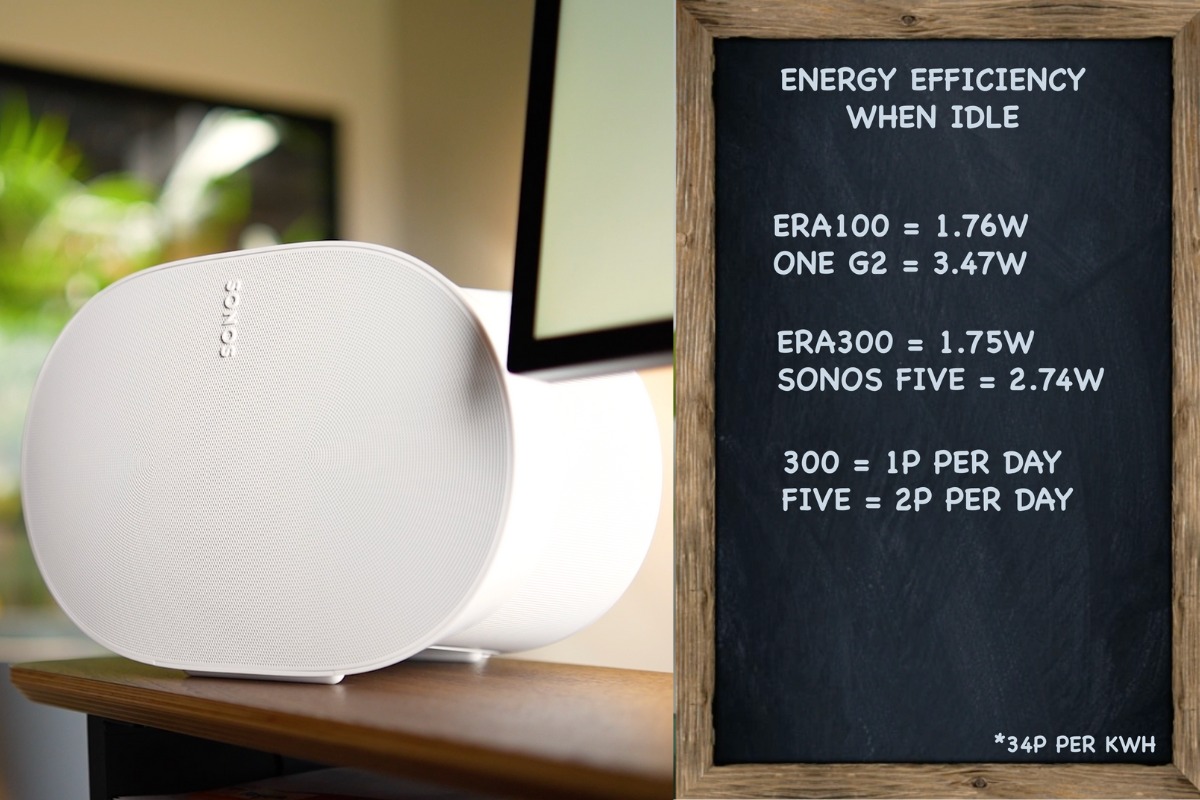
The Sonos Era 300 has been designed with sustainability in mind. Sonos have used less virgin plastics, more screws instead of glue and the packaging is 100% recyclable.
Sonos have also claimed to reduce the energy efficiency of both the Sonos Era 100 and the Era 300 speakers both when playing and when idle so of course, we wanted to test that out.
Using smart plugs, we compared the energy efficiency of the Era 100 vs the Sonos One (Gen 2) first and found that while they were pretty similar when playing, when idle the Era 100 is twice as efficient as the Sonos One (Gen 2).
The Era 300 by comparison pulls 1.75 watts when idle and the Sonos Five pulls 2.74 watts. So for comparison, at 34wph, the Era 300 will cost on average 1 pence per day idle compared with 2p for the Five.
Sonos Era 300 Connectivity
 |
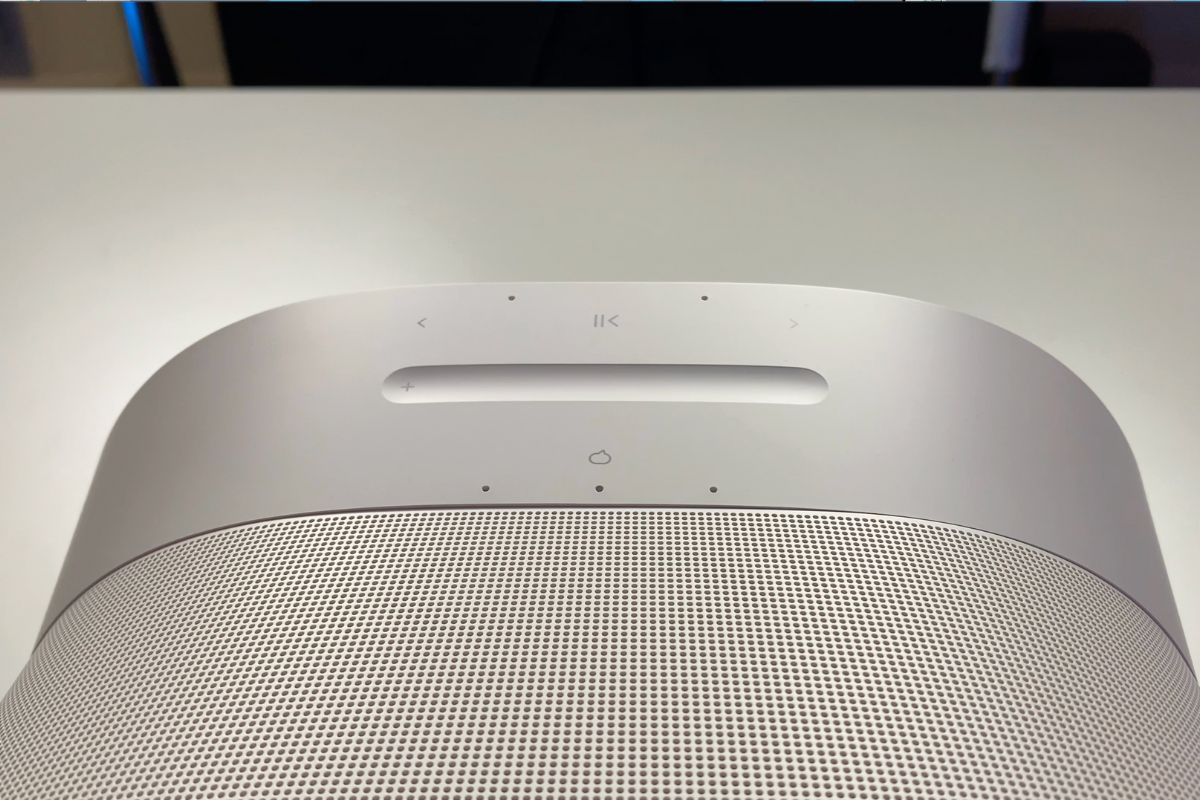 |
When it comes to connections, the Sonos Era 300 is ticking a lot of boxes and giving us the versatility we’ve been asking for. We’ve got WiFi 6 which is what I’d consider the best method for connectivity and gives us the most reliable connection.
We’ve also still got the usual options such as Airplay 2, Spotify Connect and voice control with Sonos voice or Amazon Alexa. No Google Assistant on this speaker which will be disappointing for some of you. It seems Sonos and Google are having one of those ongoing “relationship problems” but it could be added later via a software update.
What is new on this speaker is Sonos have finally added Bluetooth 5.0 to the Sonos Era range. Sonos have previously taken the stance that WiFi is the better solution but it looks like so many people have requested bluetooth that they’ve finally given in. While I don’t see myself using bluetooth at home, I can see it being a handy addition for when people come over.
One thing missing from this speaker and the Era 100 is Sonosnet. With the addition of WiFi 6 and better connectivity, I don’t see this being a big problem and I’m guessing this is why Sonos haven’t included Sonosnet on this speaker.
With the rise of Matter too, I imagine that’s another factor and while there's been no confirmation yet, Sonos are registered with Matter and I wouldn’t be surprised if this speaker will be able to be a Matter Thread Radio at some point which will be like Sonosnet on steroids but we’ll have to wait and see on that for now.
Can you connect a Sonos Era 300 to a turntable?
Yes! Another connectivity option with the Sonos Era 300 is connecting an external audio source via the USB-C port. Now you do need to purchase a separate Sonos dongle either the Sonos Line-In Adapter or Sonos Line-In + Ethernet Adapter.
I have tried a few 3rd party adapters from Amazon but so far, haven’t had any luck getting it to work.
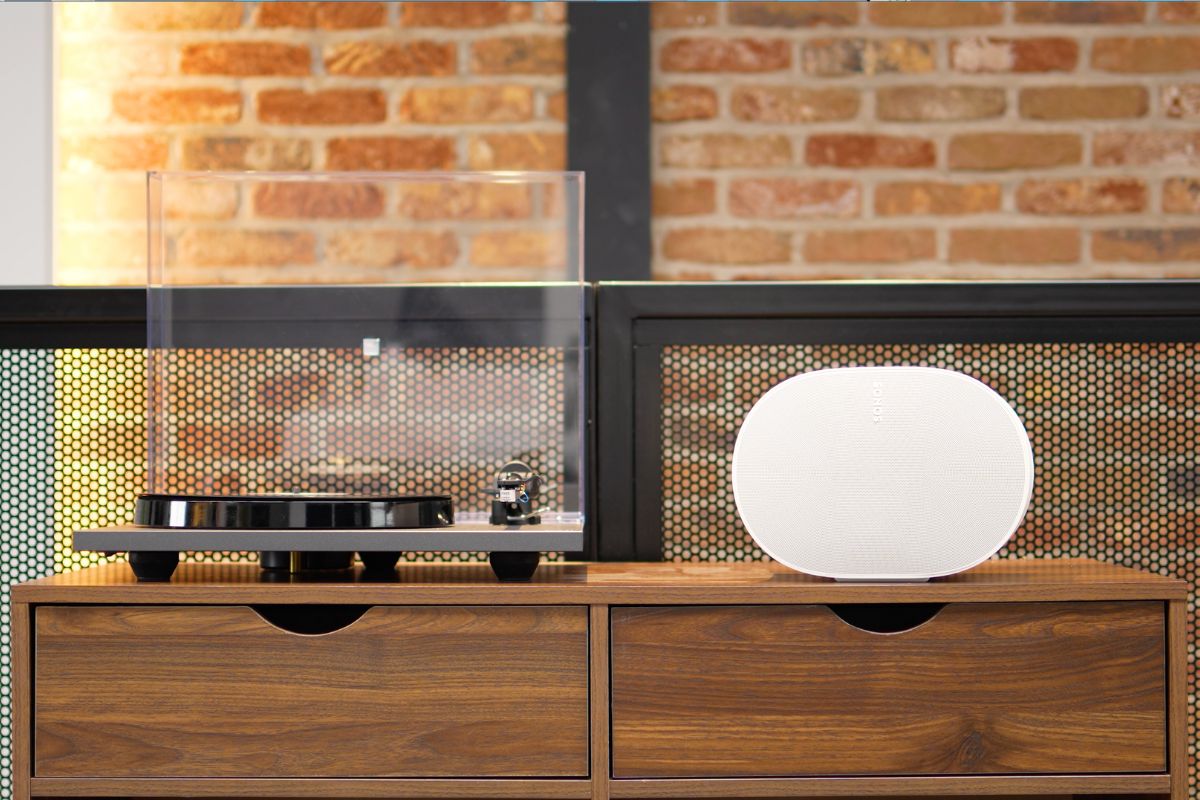
Can you connect the Sonos Era 300 to your desktop computer?
Yes, you can connect a Sonos Era 300 to your computer via Bluetooth. In our Sonos Era 300 review testing, there was no lag with this connection when watching videos or on a call but you do have to use the microphone on your computer as it wouldn’t work with the microphones on the speaker itself.
How to use Trueplay Tuning on the Sonos Era 300
From our testing, I would highly recommend performing Sonos’ Trueplay Tuning with the Sonos Era 300. Given how the speaker has been designed to bounce sound around your room, it’s more important than normal to optimise performance for your space.
There are now two options for Trueplay Tuning. If you’re an iOS user, you still have the usual method of using the microphone in a supported iOS device and walking around your space. This is now called Advanced Tuning and it’s still the most effective method. But, not to be left out anymore, Android users can now use Quick Tuning, which uses the microphones in the speaker itself to analyse the space and make any tweaks needed.
How to get Spatial Audio on Sonos
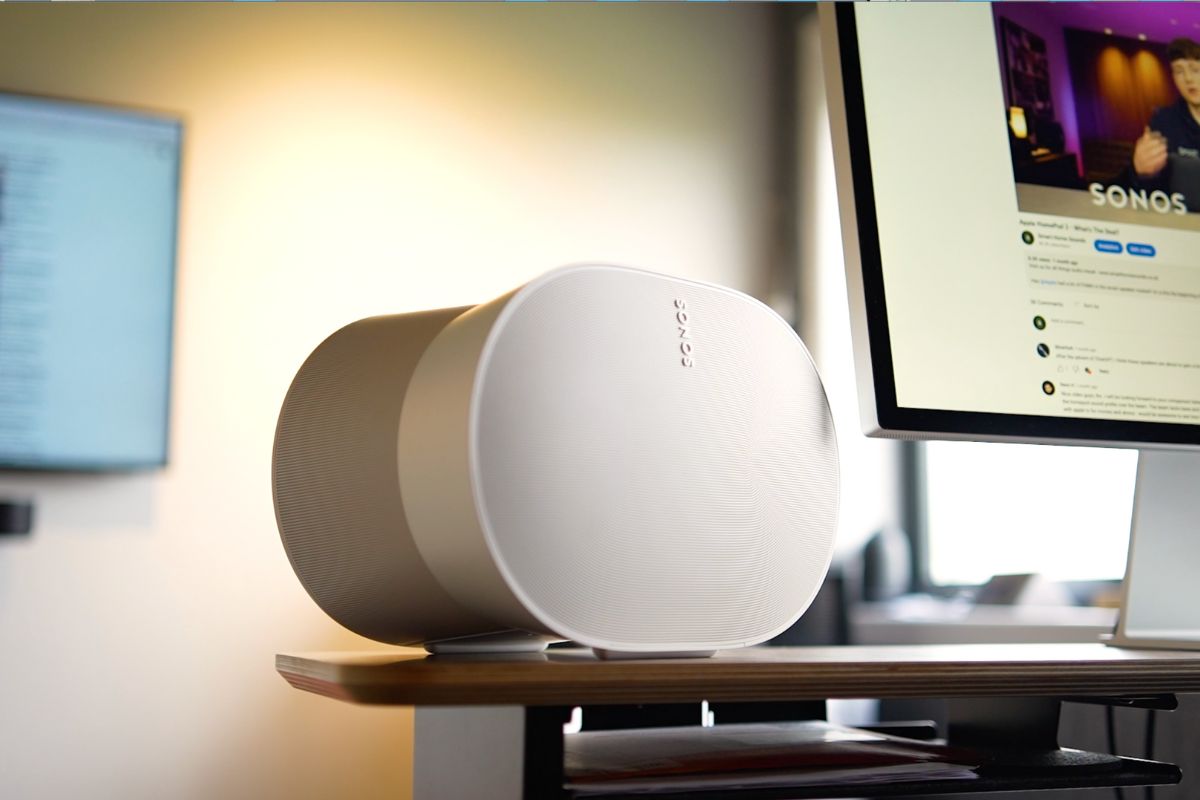
Sonos recently announced support for Apple Music Spatial Audio will be live from the 28th March which is great news and means we’ll have support as soon as the new Sonos speakers launch. The other option currently available for Dolby Atmos tracks on Sonos is Amazon Music which we’ve been testing with the Era 300. Unfortunately, there is no Dolby Atmos content on the like of Spotify right now but we can’t see it being too long before they jump on board.
Many believe that Dolby Atmos music is the future with around 90 of the top 100 billboard albums being mixed in Atmos. Giles Martin the Head of Sound experience at Sonos & and Grammy award winning producer has also said that adapted versions of the Sonos Era 300s are being used as reference monitors in studios for mixing Atmos tracks which just shows how relevant & capable this product is.
While regular music is also impressive on this speaker, I've found myself hoping that all my favourite tracks show up with that Atmos logo as the experience is just like nothing I’ve heard before. Now you can’t get Atmos audio via Bluetooth or Airplay 2 as you need a direct connection to the music server.
Beyond Apple themselves, no one else has a dedicated link to the Apple Music server apart from Sonos, making this Era 300 the only other way to experience Apple Music Spatial Audio from a single speaker right now.
Sonos Era 300 Sound Performance
In our testing of the Sonos Era 300, we found this speaker does a brilliant job of placing elements of a track around the room. You almost can’t believe the audio is coming from one speaker. The Era 300 offers a wide soundstage and the sound performance definitely feels 3D.
Vocals are really impressive and the overall performance feels super realistic and we got that cliche feeling of the artist being in the room with us. The bass is also more than we were expecting from this speaker. It’s not quite at the Sonos Five level as it just hasn’t got the size but it does pack a punch.
Again, while Dolby Atmos content sounds better, I also enjoyed the sound performance for regular music as you get all the benefits of a spacious, detailed sound, great bass and impressive vocals.
Sonos Era 300 vs Sonos Five
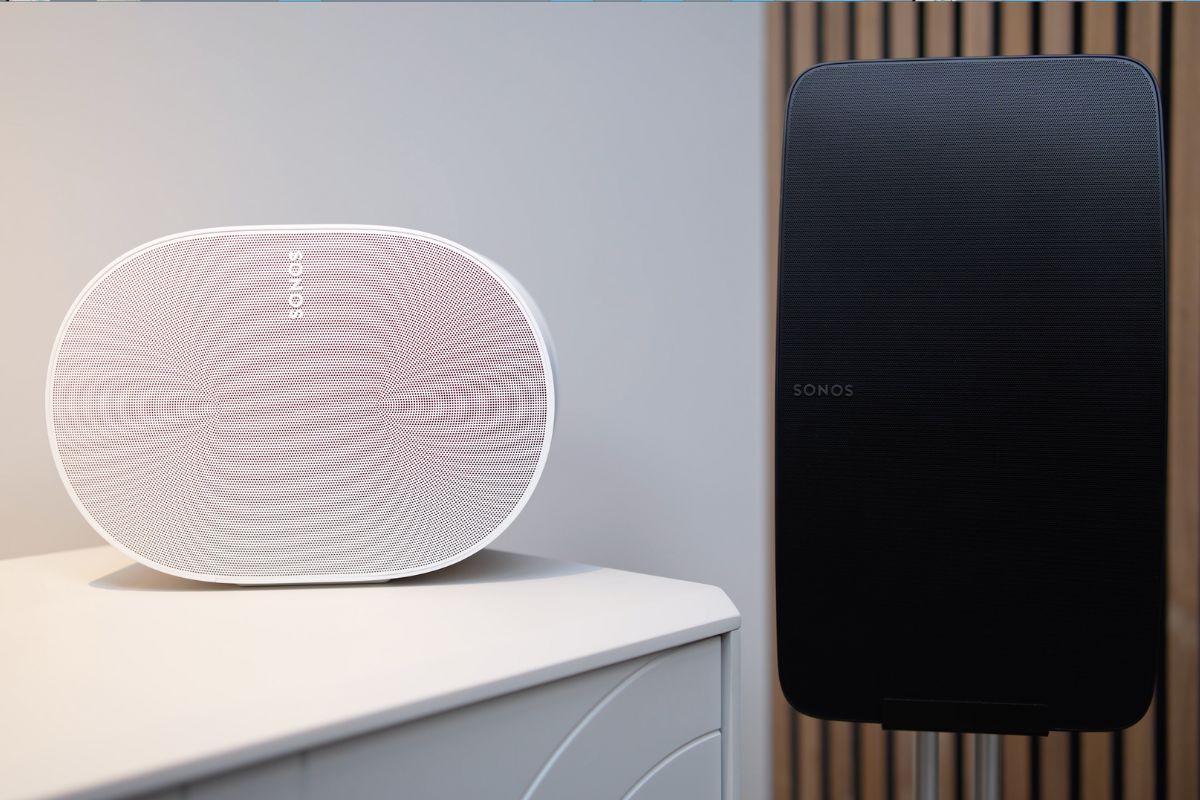
The Sonos Five and Sonos Era 300 offer a very different listening experience and it’s difficult to compare the performances. However, we have found in testing that the Sonos Five is a louder, bigger and bassier speaker. In comparison, the Sonos Era 300 gives a unique experience and shines with Atmos content, something the Sonos Five cannot offer.
If you want to sit down and listen to every detail in your music and will make use of Dolby Atmos tracks, then the Sonos Era 300 would be our recommendation. But if you’re looking for the most powerful speaker Sonos offer for room filling sound and impressive bass then the Sonos Five is a better solution.
Will Sonos bring out a Sonos Era 500? We can definitely see that coming along with a whole range of Era products. But, I don’t think it will be soon.
View Sonos Five
Sonos Era 300 Stereo Pair Review

Personally, my favourite experience from the Sonos Era 300 speakers was as a stereo pair. The overall performance in testing was incredible. The separation provided gave a different feeling to tracks we’ve tested a hundred times over and the stereo imaging gives a great experience so you really feel like the music is coming from all around you and not from two separate speakers.
The bass performance from the Sonos Era 300 is very accurate and deep and I don’t think most people will feel the need to add a Sonos Sub to this setup. Having tested Spatial Audio on the Sonos Arc before which is roughly the same price for me there is no comparison. A pair of Sonos Era 300s wins hands down for Spatial Audio.
View 2X Sonos Era 300 Bundle
Recommended Sonos Era 300 Soundbar Pairings
Two Sonos Era 300 speakers can be used upwards-firing, Dolby Atmos surround sound rears to a Dolby Atmos enabled Sonos soundbar.
With a Sonos Arc, adding two Sonos Era 300 speakers provides a 7.0.4 setup with the Sonos Arc and Sonos Era 300’s upwards-firing speakers working together to create an immersive, 3D sound performance. With sound bouncing off the ceiling and walls, you’re placed in the centre of the soundstage for a more immersive experience.
With a Sonos Beam (Gen 2), adding two Sonos Era 300 speakers delivers a 5.0.4 setup with 2 of the height channels coming from rear surrounds and 2 of the height channels coming virtually from the soundbar.
Want to get more from your Dolby Atmos soundbar? Read Our Sonos Soundbar Top Tips blog
Sonos Arc, Sonos Sub Gen 3 & 2 x Sonos Era 300 upwards-firing rears review

Now my initial thoughts having tested a pair of Sonos Era 300s as a stereo pair is that they are almost too good for rears. They are also an expensive addition and is it actually worth it?
For a lot of spaces and setups, adding 2 Era 300s will be overkill but, as there are many people with 2 x Sonos Five speakers as rears there is clearly a market for this setup.
Coming in at £2,500 minus any stands or mounts, this is an expensive setup. But we think movie lovers are going to love this. The Sonos Arc, Sonos Sub (Gen 3) and 2 x Sonos Era 300 bundle is a 7.1.4 setup and the upwards firing capabilities of the Arc and Era 300 work together to create a full 3D effect, putting you right at the centre of the action.
In testing, it does sound like audio is coming from all around and above you and if I closed my eyes, I’d struggle to point out where the speakers were positioned.
The overall immersion of this setup is truly impressive, it reminds me of when you’re watching a film in the cinema and you’re glued to the screen for 2 hours. You really do struggle to look away from the action, you’re locked in. The addition of the Era 300s makes scenes feel more dramatic and it adds extra tension with background effects and the immersion of the soundtrack.
Yes this setup does a great job in films like Top Gun: Maverick where there are missiles flying everywhere but we’ve actually appreciated the effects in more subtle, ambient scenes like in Dune where it feels like you’re in the middle of the desert with sand flying past you.
Quiet Place has been a great film for testing and the scene where she’s in the house hiding from a death angel is brilliant. The clock ticking in the background sounds like it comes from the far corner of the room and you really follow the action around the screen with all the different noises and breaths moving around you.
View Sonos Arc + 2X Sonos Era 300 Bundle
Sonos Beam (Gen 2) & 2 x Sonos Era 300 upwards-firing rears review
When we tested a pair of Sonos Era 300s as upwards-firing rears with the Sonos Beam (Gen 2), we were surprised by how much the rears added to the overall performance. The Dolby Atmos rears add another dimension to the Sonos Beam (Gen 2) and the extra bass from the Era 300s delivers a more balanced and immersive sound performance for your movies and music.
Overall, these definitely aren’t cheap rears and for a lot of people’s setups, this will be overkill. But in the right space, if you’ve got the budget and you love movies, this is one hell of a setup.
View Sonos Beam + 2X Sonos Era 300 Bundle
Can you use a pair of Sonos Era 300 speakers with your TV?
Sadly you are unable to use two Era 300 speakers for your TV audio. This is rather disappointing for many of use as the wide soundstage and support for Dolby Atmos would make this a fantastic setup for TV audio. We hope this is something Sonos will enable in the future but for now, you have to use a Sonos soundbar to upgrade your TV audio and add two Era 300s as upwards-firing rears for a more immersive experience.
Verdict
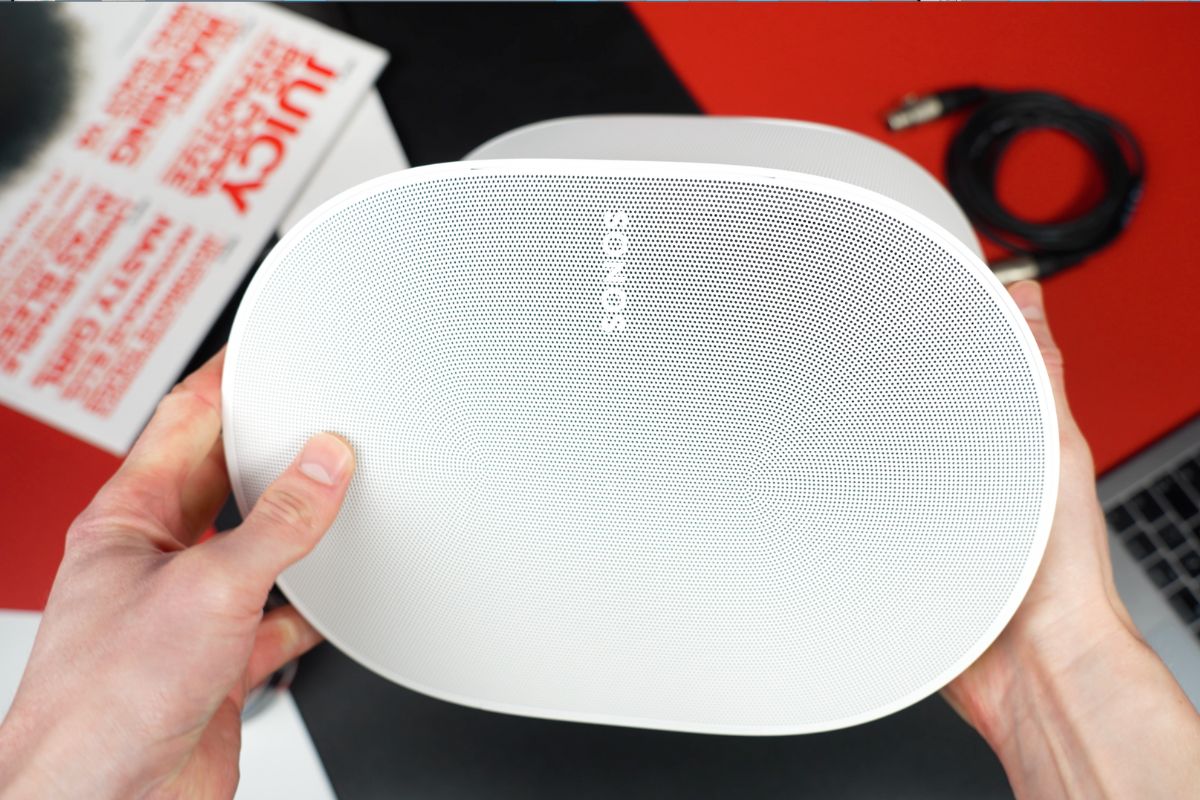
Overall, this is a pretty versatile speaker. I was initially worried that without a subscription for a streaming service that supports spatial audio and Dolby Atmos tracks, this speaker wouldn’t be a worthwhile purchase.
Although you absolutely get the most out of this speaker with Dolby Atmos music, it’s still a brilliant option for those looking to experience their music in a more immersive way whether that’s as a standalone speaker, as a stereo pair or with an external audio source. Plus, for those looking to upgrade their Sonos home cinema setup, this is a huge upgrade.
I think the Era 300 is doing some really clever stuff and honestly, I think the best way we could test this speaker was by forgetting about the tech for a minute and just enjoying the music or movies we were testing. This product might not be for everyone and every setup (and it’s definitely not an impulse addition) but we do see that this is truly a new era of audio from Sonos and hopefully paves the way for more exciting products to come in the future.
Shop Sonos Era 300
Learn More
Read Sonos Era 100 Review: Truly Immersive Stereo Sound
Read Sonos Arc Review: Is It Worth It In 2023?
Read Sonos Era 100 vs Sonos One (Gen 2): What's The Difference?
If we can help any further, please reach out using one of the channels below:
| info@smarthomesounds.co.uk | |
| Live Chat on our Website | |
| 0800 677 1100 |
The all-new Sonos Era 300 ensures a next-generation listening experience thanks to its Dolby Atmos Spatial Audio capabilities, but is it the right choice for you?


